
Welcome to the only platform where you can connect with MASLD/MASH experts in your geographic area and stay up to date with disease state education in the form of short video modules and news articles.
Thought Leader
Mission of the MASLD Community
Dedicated to fostering collaboration, driving innovation, and improving outcomes for patients living with Metabolic Associated Steatotic Liver Disease.


Engage with MASLD/MASH Experts in Your Region
Connect with regional specialists for personalized guidance, professional training, and continuous support in MASLD/MASH.


Expert Insights
Benefit from expert-driven resources, including podcasts, publications, and practical tools designed for clinicians and patients.


Tailored Education for Your Community
Join your regional community network, where education is tailored to meet local needs. Collaborate with peers from local and regional communities, share knowledge, and drive impactful changes together.
Explore Our Events

MASLD vs MetALD - Virtual

Join HoChong Gilles, DNP, FNP-BC, on August 7, 2025, for a live GHAPP Zoom session exploring one of the most important and evolving topics in hepatolo..
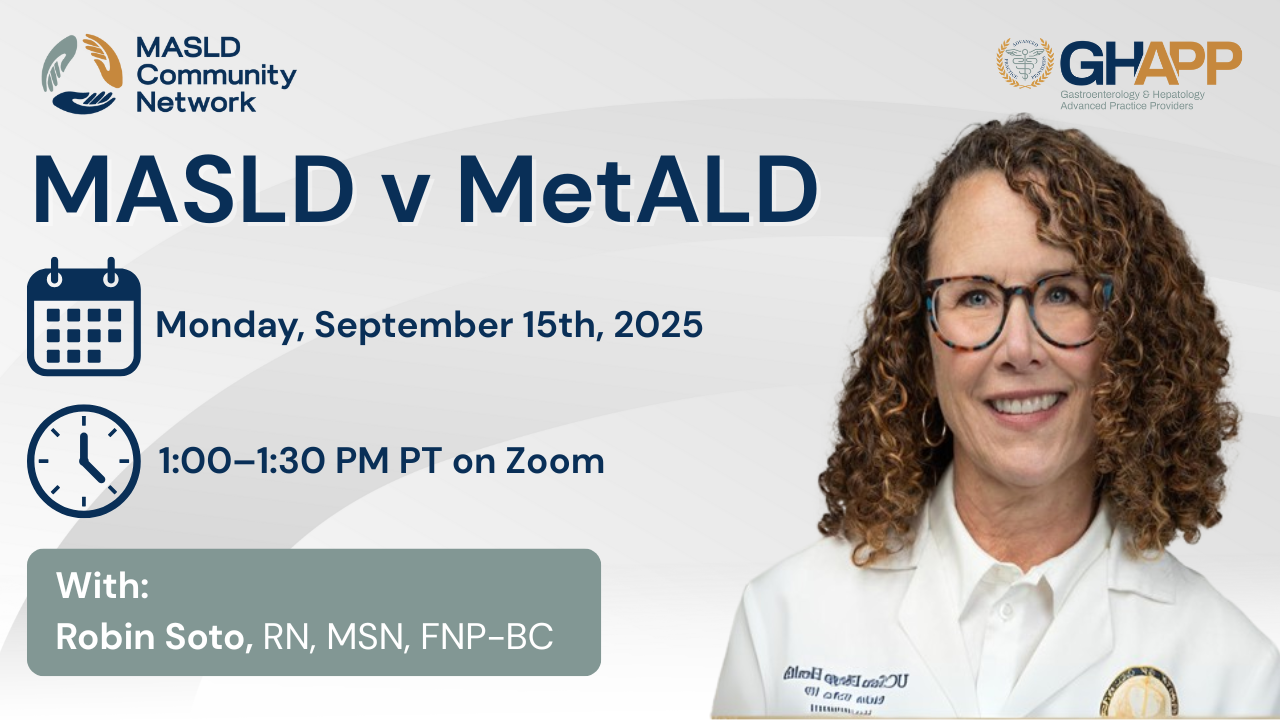
MASLD vs MetALD - Virtual

Don’t miss this important live GHAPP Zoom session on September 15, 2025, with Robin Soto, MSN, RN, FNP-BC, as she breaks down the evolving lands..
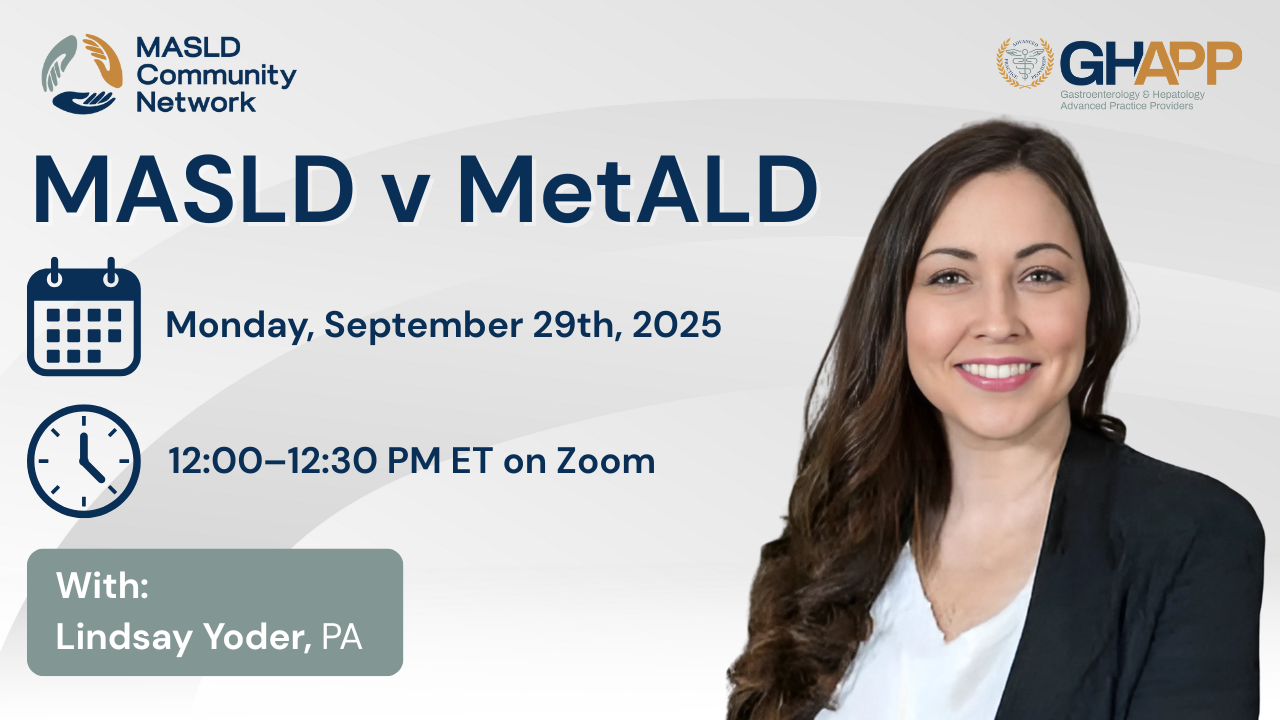
MASLD vs MetALD - Virtual

Join Lindsay Yoder, PA-C, MPAS, on September 29, 2025, for a live GHAPP Zoom session focused on one of the most important updates in hepatology: the c..

MASLD vs MetALD - Virtual

Join Michelle Barnett, PA-C, MPAS, DFAAPA on August 4, 2025, for a live GHAPP Zoom session focused on MASLD vs MetALD. ..

MASLD vs MetALD

Join Jill Olmstead, DNP, ANP-BC on August 5th, 2025, for a GHAPP Zoom session focused on MASLD vs MetALD. ..

MASLD vs MetALD - Virtual

Join Patrick Horne, ARNP, on August 5, 2025, for a live GHAPP Zoom session focused on MASLD vs MetALD...

MASLD vs MetALD - Virtual

Join Christina Hanson, FNP-C, on August 6, for a live GHAPP zoom session focused on MASLD vs MetALD. ..

MASLD vs MetALD - Virtual

Join Ellie Gonyeau, NP, on August 6, 2025, for a live GHAPP Zoom session focused on MASLD vs MetALD. ..

MASLD vs MetALD - Virtual

Join Anthony Derencius, PA-C on August 8th, 2025, for a GHAPP Zoom session focused on MASLD vs MetALD. ..

MASLD vs MetALD - Virtual

Join Elizabeth Goacher, PA-C, on August 12, 2025, for a live GHAPP Zoom session focused on MASLD vs MetALD. ..
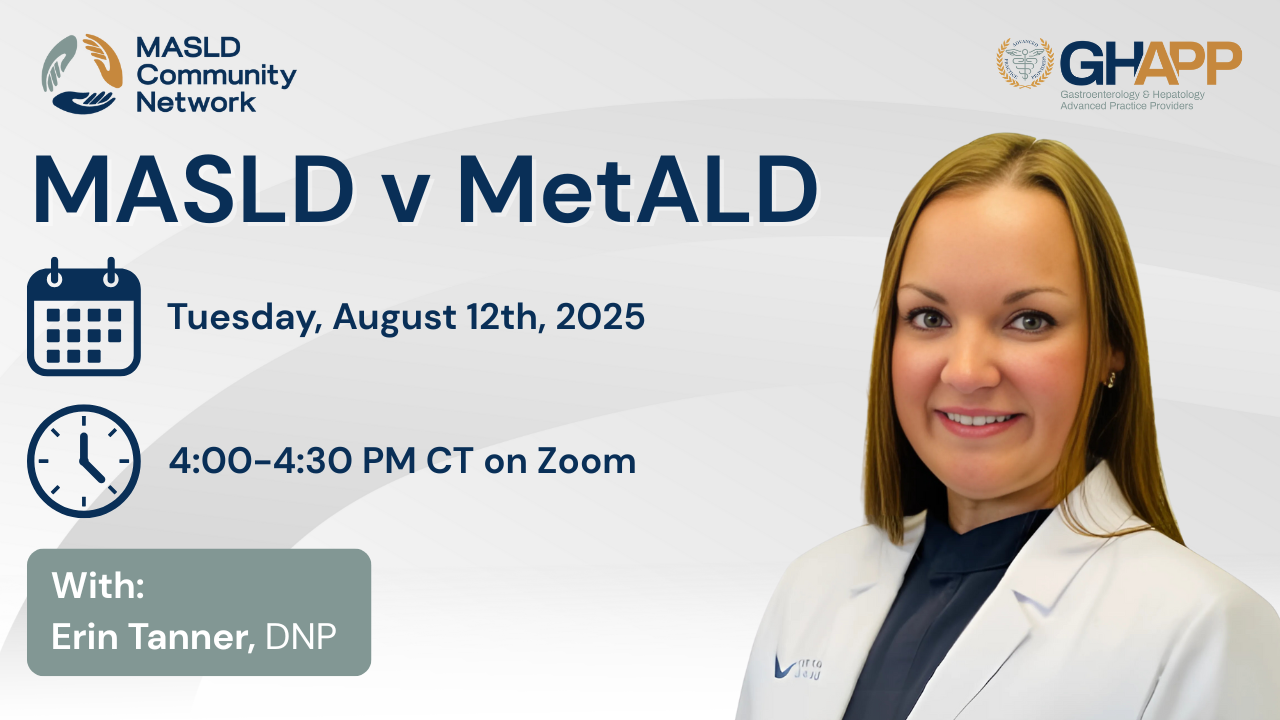
MASLD vs MetALD - Virtual

Join Erin Tanner, DNP, on August 12, 2025, for a live GHAPP Zoom session focused on MASLD vs MetALD. ..

MASLD vs MetALD - Virtual

Join April Morris, NP, on August 13, 2025, for a live GHAPP Zoom session focused on MASLD vs MetALD. ..

MASLD vs MetALD - Virtual

Join Maribeth Capuno, DNP, RN, ANP-BC, on August 14, 2025, for a live GHAPP Zoom session focused on MASLD vs MetALD. ..

MASLD vs MetALD - Virtual

Join Whitney Steinmetz, NP, on August 15, 2025, for a live GHAPP Zoom session focused on MASLD vs MetALD...

MASLD vs MetALD - Virtual

Join Jennifer Geremia, PA-C, on August 18, 2025, for a live GHAPP Zoom session focused on MASLD vs MetALD. ..

MASLD vs MetALD - Virtual

Join Alison Moe, PA-C, on August 18, 2025, for a live GHAPP Zoom session focused on MASLD vs MetALD. ..

MASLD vs MetALD - Virtual

Join Allysa Saggese, NP, on August 21, 2025, for a live GHAPP Zoom session focused on MASLD vs MetALD. ..

MASLD vs MetALD - Virtual

Join Lindsay Pratt, PA-C, on August 20, 2025, for a live GHAPP Zoom session focused on MASLD vs MetALD. ..

MASLD vs MetALD - Virtual

Join Suzanne Robertazzi, DNP, ANP-BC, on September 9, 2025, for a live GHAPP Zoom session focused on MASLD vs MetALD. ..

MASLD vs MetALD - Virtual

Join Janet Gripshover, DNP, FNP-BC on September 10, 2025, for a GHAPP Zoom session focused on MASLD vs MetALD. ..

MASLD vs MetALD - Virtual

Join Scott Springer, PA-C, on September 11th, 2025, for a GHAPP Zoom session focused on MASLD vs MetALD. ..

MASLD vs MetALD - Virtual

Join Emily Przybyl, PA-C, on September 12th, 2025, for a GHAPP Zoom session focused on MASLD vs MetALD. ..

MASLD vs MetALD - Virtual

Join Gabriella McCarty, NP, on September 15th, 2025, for a GHAPP Zoom session focused on MASLD vs MetALD. ..

MASLD vs MetALD - Virtual

Join Christie Morrison, NP, on September 15, 2025, for a live GHAPP Zoom session focused on MASLD vs MetALD. ..

MASLD vs MetALD - Virtual

Join Valerie Shin, NP, on September 15, 2025, for a live GHAPP Zoom session focused on MASLD vs MetALD. ..

MASLD vs MetALD - Virtual

Join Tessa Janovsky, PA-C, on September 16, 2025, for a live GHAPP Zoom session focused on MASLD vs MetALD. ..
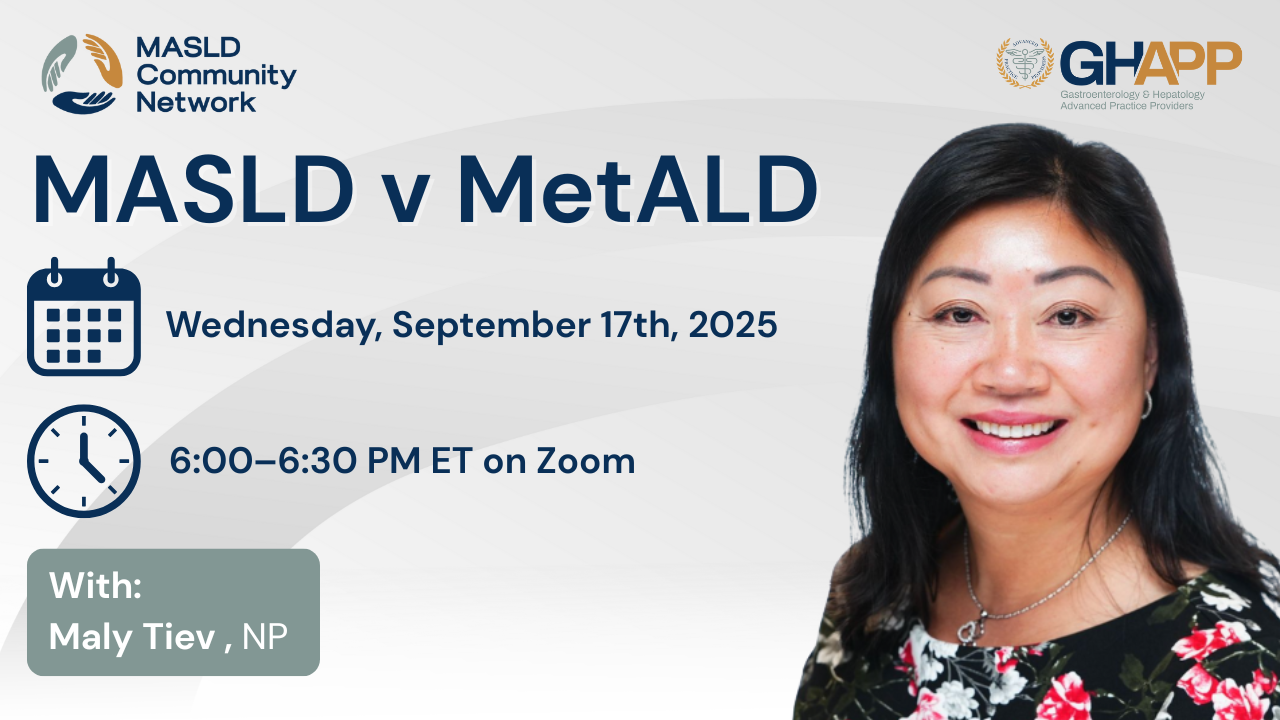
MASLD vs MetALD - Virtual

Join Maly Tiev, NP, on September 17, 2025, for a live GHAPP Zoom session focused on MASLD vs MetALD. ..

MASLD vs MetALD - Virtual

Join Sarah Dawkins, NP, on September 17, 2025, for a live GHAPP Zoom session as we dive into MASLD vs MetALD. ..

MASLD vs MetALD - Virtual

Join Oyin Penny, FNP, on September 18, 2025, for a live GHAPP Zoom session focused on MASLD vs MetALD. ..

MASLD vs MetALD - Virtual

Join Sherona Bau, NP, on September 16, 2025, for a live GHAPP Zoom session focused on MASLD vs MetALD. ..

MASLD vs MetALD - Virtual

Join Kelly Smeester, MMS, RD, PA-C, on September 26, 2025, for a live GHAPP Zoom session focused on MASLD vs MetALD. ..

MASLD vs MetALD - Virtual

Join Milly Ng, NP, on September 19, 2025, for a live GHAPP zoom session focused on MASLD vs MetALD. ..

MASLD vs MetALD - Virtual

Join Summer Collier, FNP, on September 24, 2025, for a live GHAPP Zoom session focused on MASLD vs MetALD. ..

MASLD vs MetALD - Virtual

Join Brian Lam, PA-C, on September 23, 2025, for a live GHAPP Zoom session focused on MASLD vs MetALD...

MASLD vs MetALD - Virtual

Join Erin Parkinson, MS, APRN, FNP-C, on August 16, for a live GHAPP zoom session focused on MASLD vs MetALD. ..

MASLD vs MetALD - Virtual

Join Lavinia Iordache, PA-C, on August 4, 2025, for a live GHAPP Zoom session focused on MASLD vs MetALD. ..

MASLD vs MetALD - Virtual

Join HoChong Gilles, DNP, FNP-BC, on August 7, 2025, for a live GHAPP Zoom session exploring one of the most important and evolving topics in hepatolo..

MASLD vs MetALD - Virtual

Don’t miss this important live GHAPP Zoom session on September 15, 2025, with Robin Soto, MSN, RN, FNP-BC, as she breaks down the evolving lands..

MASLD vs MetALD - Virtual

Join Lindsay Yoder, PA-C, MPAS, on September 29, 2025, for a live GHAPP Zoom session focused on one of the most important updates in hepatology: the c..

MASLD vs MetALD - Virtual

Join Michelle Barnett, PA-C, MPAS, DFAAPA on August 4, 2025, for a live GHAPP Zoom session focused on MASLD vs MetALD. ..

MASLD vs MetALD

Join Jill Olmstead, DNP, ANP-BC on August 5th, 2025, for a GHAPP Zoom session focused on MASLD vs MetALD. ..

MASLD vs MetALD - Virtual

Join Patrick Horne, ARNP, on August 5, 2025, for a live GHAPP Zoom session focused on MASLD vs MetALD...

MASLD vs MetALD - Virtual

Join Christina Hanson, FNP-C, on August 6, for a live GHAPP zoom session focused on MASLD vs MetALD. ..

MASLD vs MetALD - Virtual

Join Ellie Gonyeau, NP, on August 6, 2025, for a live GHAPP Zoom session focused on MASLD vs MetALD. ..

MASLD vs MetALD - Virtual

Join Anthony Derencius, PA-C on August 8th, 2025, for a GHAPP Zoom session focused on MASLD vs MetALD. ..

MASLD vs MetALD - Virtual

Join Elizabeth Goacher, PA-C, on August 12, 2025, for a live GHAPP Zoom session focused on MASLD vs MetALD. ..

MASLD vs MetALD - Virtual

Join Erin Tanner, DNP, on August 12, 2025, for a live GHAPP Zoom session focused on MASLD vs MetALD. ..

MASLD vs MetALD - Virtual

Join April Morris, NP, on August 13, 2025, for a live GHAPP Zoom session focused on MASLD vs MetALD. ..

MASLD vs MetALD - Virtual

Join Maribeth Capuno, DNP, RN, ANP-BC, on August 14, 2025, for a live GHAPP Zoom session focused on MASLD vs MetALD. ..

MASLD vs MetALD - Virtual

Join Whitney Steinmetz, NP, on August 15, 2025, for a live GHAPP Zoom session focused on MASLD vs MetALD...

MASLD vs MetALD - Virtual

Join Jennifer Geremia, PA-C, on August 18, 2025, for a live GHAPP Zoom session focused on MASLD vs MetALD. ..

MASLD vs MetALD - Virtual

Join Alison Moe, PA-C, on August 18, 2025, for a live GHAPP Zoom session focused on MASLD vs MetALD. ..

MASLD vs MetALD - Virtual

Join Allysa Saggese, NP, on August 21, 2025, for a live GHAPP Zoom session focused on MASLD vs MetALD. ..

MASLD vs MetALD - Virtual

Join Lindsay Pratt, PA-C, on August 20, 2025, for a live GHAPP Zoom session focused on MASLD vs MetALD. ..

MASLD vs MetALD - Virtual

Join Suzanne Robertazzi, DNP, ANP-BC, on September 9, 2025, for a live GHAPP Zoom session focused on MASLD vs MetALD. ..

MASLD vs MetALD - Virtual

Join Janet Gripshover, DNP, FNP-BC on September 10, 2025, for a GHAPP Zoom session focused on MASLD vs MetALD. ..

MASLD vs MetALD - Virtual

Join Scott Springer, PA-C, on September 11th, 2025, for a GHAPP Zoom session focused on MASLD vs MetALD. ..

MASLD vs MetALD - Virtual

Join Emily Przybyl, PA-C, on September 12th, 2025, for a GHAPP Zoom session focused on MASLD vs MetALD. ..

MASLD vs MetALD - Virtual

Join Gabriella McCarty, NP, on September 15th, 2025, for a GHAPP Zoom session focused on MASLD vs MetALD. ..

MASLD vs MetALD - Virtual

Join Christie Morrison, NP, on September 15, 2025, for a live GHAPP Zoom session focused on MASLD vs MetALD. ..

MASLD vs MetALD - Virtual

Join Valerie Shin, NP, on September 15, 2025, for a live GHAPP Zoom session focused on MASLD vs MetALD. ..

MASLD vs MetALD - Virtual

Join Tessa Janovsky, PA-C, on September 16, 2025, for a live GHAPP Zoom session focused on MASLD vs MetALD. ..

MASLD vs MetALD - Virtual

Join Maly Tiev, NP, on September 17, 2025, for a live GHAPP Zoom session focused on MASLD vs MetALD. ..

MASLD vs MetALD - Virtual

Join Sarah Dawkins, NP, on September 17, 2025, for a live GHAPP Zoom session as we dive into MASLD vs MetALD. ..

MASLD vs MetALD - Virtual

Join Oyin Penny, FNP, on September 18, 2025, for a live GHAPP Zoom session focused on MASLD vs MetALD. ..

MASLD vs MetALD - Virtual

Join Sherona Bau, NP, on September 16, 2025, for a live GHAPP Zoom session focused on MASLD vs MetALD. ..

MASLD vs MetALD - Virtual

Join Kelly Smeester, MMS, RD, PA-C, on September 26, 2025, for a live GHAPP Zoom session focused on MASLD vs MetALD. ..

MASLD vs MetALD - Virtual

Join Milly Ng, NP, on September 19, 2025, for a live GHAPP zoom session focused on MASLD vs MetALD. ..

MASLD vs MetALD - Virtual

Join Summer Collier, FNP, on September 24, 2025, for a live GHAPP Zoom session focused on MASLD vs MetALD. ..

MASLD vs MetALD - Virtual

Join Brian Lam, PA-C, on September 23, 2025, for a live GHAPP Zoom session focused on MASLD vs MetALD...

MASLD vs MetALD - Virtual

Join Erin Parkinson, MS, APRN, FNP-C, on August 16, for a live GHAPP zoom session focused on MASLD vs MetALD. ..

MASLD vs MetALD - Virtual

Join Lavinia Iordache, PA-C, on August 4, 2025, for a live GHAPP Zoom session focused on MASLD vs MetALD. ..

MASLD vs MetALD - Virtual

Join HoChong Gilles, DNP, FNP-BC, on August 7, 2025, for a live GHAPP Zoom session exploring one of the most important and evolving topics in hepatolo..

MASLD vs MetALD - Virtual

Don’t miss this important live GHAPP Zoom session on September 15, 2025, with Robin Soto, MSN, RN, FNP-BC, as she breaks down the evolving lands..

MASLD vs MetALD - Virtual

Join Lindsay Yoder, PA-C, MPAS, on September 29, 2025, for a live GHAPP Zoom session focused on one of the most important updates in hepatology: the c..

GHAPP Eighth Annual Conference

About the 2025 GHAPP Conference The GHAPP conference is the only conference specifically designed by advanced practice providers (APPs) for the pur..
Explore Our Events

CME EVENT
GHAPP Eighth Annual Conference
 September 04 @ 12:00 pm - 12:00 pm MDT
September 04 @ 12:00 pm - 12:00 pm MDT
About the 2025 GHAPP Conference The GHAPP conference is the only conference specifically designed by advanced practice providers (APPs) for the pur..
Featured MASLD/MASH Educators

Allysa Saggese
NP
Allysa Saggese is a graduate of Columbia University School of Nursing with a Master's Degree in Nursing. She is board certified with the ANCC as an Adult-Gerontology Primary Care Nurse Practitioner. She has worked in Hepatology, Liver Transplantation and Hepatology Research at Weill Cornell Medicine since 2018. Her main interests include Steatotic Liver Disease, Primary Biliary Cholangitis and cirrhotic liver disease, as well as the spectrum of research within hepatology.

Patrick Horne
ARNP
Patrick M. Horne, MSN, APRN-BC, FNP, AF-AASLD is the Assistant Director of Clinical Hepatology Research and Clinical Programs Coordinator at the University of Florida’s Department of Medicine, Division of Gastroenterology, Hepatology, and Nutrition. He holds bachelor's and master's degrees from the University of Florida College of Nursing. His research focuses on hepatology clinical trials, including viral hepatitis, MASH, autoimmune hepatitis, cholestatic liver disease, and HCC. He has published extensively in clinical hepatology and has presented at major conferences such as AASLD, AGA NP/PA, and GHAPP.

Valerie Shin
NP
Valerie Shin earned her Bachelor of Science in Nursing from New York University. After earning her degree, she advanced her nursing career with the Cleveland Clinic in Cleveland, Ohio, and the Veterans Affairs Medical Center in West Los Angeles, California. Valerie furthered her career by completing the Acute Care Nurse Practitioner program at the University of California, Los Angeles, where she obtained a Master’s degree. During her clinical rotation, she had the privilege of being mentored at the liver clinic, where she developed a strong interest in hepatology and the management of liver diseases. This experience led her to her current role as a Hepatology Nurse Practitioner at the Pfleger Liver Institute at UCLA Health, where she continues to specialize in liver disease care. In addition to providing exceptional patient care, Valerie Shin has a strong passion for education, both in teaching future APPs and empowering her patients. She enjoys educating her NP students in her clinic and was honored with the opportunity to lecture NP students at UCLA School of Nursing on the topic of liver cirrhosis and its complications. Valerie also contributes to the annual UCLA Patient Seminar for Liver Diseases, where she provides essential patient education. Furthermore, she is actively involved in the GHAPP meetings, demonstrating her ongoing commitment to advancing both the education of current and future APPs and the care of liver disease patients.

Gabriella McCarty
NP-C
Gabriella McCarty is a gastroenterology/hepatology nurse practitioner. She obtained her masters and nurse practitioner degree at Case Western Reserve University in 2004. She has been practicing in this field for 26 years. She serves as faculty for Gastroenterology/ Hepatology Advanced Practice Providers (GHAPP) and is an American College of Gastroenterology (ACG) committee member, serving on the education subcommittee. She will be completing her doctorate of nursing in May 2025. She loves all aspects of GI / Hepatology, education and nursing.

Alison Moe
PA-C
Alison S. Moe, MS, PA-C, is a board-certified physician assistant specializing in gastroenterology at United Digestive's Braselton office in Hoschton, Georgia. She earned her Master of Science in Medical Education from Seton Hall University and a Bachelor of Arts in Physical Anthropology from the State University of New York at Stony Brook. Alison is fluent in Spanish and has a special interest in treating irritable bowel syndrome and liver disease. With almost two decades of experience as a Physician Assistant, Alison has developed a strong foundation in both clinical practice and research, particularly in the fields of gastroenterology and hepatology. Alison's dedication to patient care includes extensive clinical hours, allowing her to cultivate deep relationships with patients as well as national experts caring for individuals, especially those suffering from inflammatory bowel disease (IBD) and advanced liver disease. Alison's commitment to advancing the understanding and treatment of these conditions drives my clinical practice and ongoing research efforts, aiming to provide the highest standard of care for my patients.

Christie Morrison
AGACNP-BC
Christie Morrison is a Board Certified Adult Advanced Practice Nurse and Lead APP at Oshi Health, a digital digestive health practice and IBD APP at Texas Digestive Disease Consultants in San Antonio, Texas. She strives to improve the lives of patients with chronic gastrointestinal conditions through a multidisciplinary approach. She has worked in various roles as a GI advanced practice provider, including inpatient, outpatient clinic, and telehealth since 2015. Mrs. Morrison is currently an active member of the American College of Gastroenterology where she is serving on the Editorial Board. She is also a member of several GI societies, including TSGE, AGA, ASGE, and GHAPP. Christie was recently honored with the ACG APP Clinical Excellence Award for community practice. She collaborates with industry partners and GI colleagues to enhance education and engagement for APPs working in Gastroenterology. She strives to improve the quality of life and better patient outcomes in all chronic GI conditions and believes that providing resources to her peers through education can help her achieve this goal.

Jill Olmstead
DNP, ANP-BC
Jill Olmstead, DNP, ANP-BC, is a gastroenterology nurse practitioner with Providence St. Jude Heritage Medical Group in Fullerton, California. She specializes in diagnosing and managing gastrointestinal disorders, offering compassionate, evidence-based care to improve patient outcomes.

Oyin Penny
MSN, FNP
Oyin Penny is a dedicated and experienced Nurse practitioner in Hepatology and Gastroenterology with a passion for providing comprehensive care to patients with various gastrointestinal disorders and liver disease. Oyin has 13+ years of clinical experience. She has an expertise in managing patients in conditions such as Steatotic liver disease (metabolic liver disease), chronic liver disease, hepatitis (acute or chronic), inflammatory bowel disease and functional GI disorders in both inpatient and outpatient settings. She actively collaborates with multidisciplinary teams to ensure her patients receive the best quality care. Oyin is committed to a patient-centered care, with emphasis on education, disease prevention, and lifestyle modifications to improve health outcomes. In addition to clinical experience, Oyin is passionate about patient advocacy and mentorship. She is currently a Mentor for APPs for the ACG and also initiated and leads the KC Gut club for APPs in GI and Hepatology in the Kansas City area.

Emily Przybyl
PA-C
Emily Przybyl is a physician assistant who specializes in gastroenterology and hepatology at Erie County Medical Center in Buffalo, NY. She earned her Bachelor of Science in Health Sciences and Master of Science in Physician Assistant Studies at Daemen University in Amherst, NY. She has over 5 years experience in her field and has a special interest in treating patients with MASLD/MASH.

Lisa Richards
MSN, FNP-BC, AF-AASLD
Lisa Richards is a highly experienced Family Nurse Practitioner at the University of California, San Diego Health System. She earned her Bachelor of Science and Master of Science degrees in Nursing, graduating magna cum laude, from the University of San Diego. With over 22 years of experience in Hepatology, Lisa has developed specialized expertise in MASLD (Metabolic Associated Steatotic Liver Disease) and its related research. She currently serves as the Assistant Director of Clinical Operations at the MASLD Research Center, where she plays a pivotal role in advancing the field. A dedicated member of the American Association for the Study of Liver Diseases (AASLD), Lisa has been honored with the prestigious title of Associate Fellow, recognizing her excellence and leadership in Hepatology. In addition to her clinical and research work, Lisa is an active speaker and thought leader in her field. She has presented at esteemed events such as the AASLD Annual Meeting, Global Hepatology and Advanced Practice Providers (GHAPPP), and various local and regional conferences, sharing her deep knowledge and insights into Hepatology. Known for her leadership and expertise, Lisa Richards is widely regarded as a key figure in advancing MASLD research and Hepatology care.

Jordan Mayberry
MPAS, PA-C
Jordan Mayberry completed her master’s in physician assistant studies at UT Southwestern School of Health Professions in 2012. She completed the AASLD NP/PA Fellowship in 2013. She has been practicing hepatology in a large academic setting for over 12 years. She enjoys mentoring new APPs and serves as a lecturer and preceptor for the UT Southwestern Physician Assistant program and was awarded Outstanding Educator Award in 2023. She has given plenary talks at The Liver Meeting, Digestive Disease Week and GHAPP national and regional meetings. She currently serves at the vice chair for the Associates committee for AASLD.

Carla Molliner
PA-C
Carla M. Molliner, PA-C, is a seasoned physician assistant specializing in hepatology at the University of Miami Health System. With over two decades of clinical experience, she provides expert care in liver diseases and transplant hepatology. She is fluent in both English and Spanish, enhancing her ability to serve a diverse patient population. Carla Molliner earned her master's degree from Nova Southeastern University and completed a fellowship in hepatology at the University of Miami. She is board-certified by the National Commission on Certification of Physician Assistants. Currently, she serves as the APP Team Manager (H) at the University of Miami, where she leads advanced practice providers in hepatology. In addition to her clinical duties, Carla Molliner actively participates in academic and educational initiatives. She was a featured speaker at the 2024 Advances in Hepatobiliary Diseases conference, where she presented on age-appropriate health care maintenance beyond liver disease.

Ann Moore
NP
Ann Moore is a hepatology nurse practitioner and VP of Clinical Services at Arizona Liver Health. She has over 30 years of liver disease and liver transplant management experience and is recognized nationally for her liver disease expertise. In addition to her clinical practice, she serves as Principal Investigator for multiple clinical trials in MASH and other liver diseases. Throughout her career, Ann has worked to expand access to liver disease care throughout the state of Arizona, running numerous outreach clinics in rural locations.

April Morris
FNP
Mrs. April Morris received a bachelor of science in biology and nursing from Virginia Commonwealth University (VCU) in Richmond, Virginia. She went on to complete a master’s degree in nursing at VCU and became a board-certified family nurse practitioner in 2006. Initially, she worked in hepatology at VCU Medical Center for many years focusing on treating those patients with chronic hepatitis C. She then worked in a community hospital-based setting at the Liver Institute of Virginia in Newport News, VA and Richmond, VA for several years as the senior nurse practitioner. In this role, she gained extensive experience evaluating and managing patients with various acute and chronic liver diseases and conditions, including complications related to cirrhosis and hepatocellular carcinoma (HCC). She was also a sub-investigator for many liver-related clinical trials including studies conducted to develop better oral medications for chronic hepatitis C, NASH and PBC. Currently, she works full-time in the GI/Hepatology department at Hunter Holmes McGuire Veterans Affairs Medical Center in Richmond, VA. In this role, she is primarily working to help develop a metabolic liver clinic to benefit those patients with NASH. Mrs. Morris is a member of the American Academy of Nurse Practitioners, American Association for the Study of Liver Diseases, American College of Gastroenterology, Virginia Council of Nurse Practitioners and an executive committee member and advisor for Chronic Liver Disease Foundation (CLDF).

Janet Gripshover
DNP, MBA
Janet Gripshover, DNP, MBA, AF-AASLD, is a highly experienced Family Nurse Practitioner and Nurse Manager for Cedars-Sinai’s Liver Transplant Program in Los Angeles. With over 15 years of clinical and leadership expertise in hepatology, Dr. Gripshover is recognized for her commitment to advancing the role of Advanced Practice Providers (APPs) in liver care. She has led numerous initiatives to foster APP education and collaboration, including founding the APP HCV Consortium in Baltimore, MD, and creating the GI APP Grand Rounds series at Geisinger Wyoming Valley in Wilkes-Barre, PA. In addition to speaking at national conferences, Dr. Gripshover has developed and delivered a wide range of educational and professional development seminars for non-physician providers across the country. An advocate for patient-centered innovation, she also founded and moderated the first hospital-sponsored Facebook support group for liver transplant recipients — a project that earned her the New Media Award for Healthcare from the Baltimore Business Journal and national recognition. Dr. Gripshover is an active member of the American Association for the Study of Liver Diseases (AASLD), where she has served on the Hepatology Associates Committee and the Women’s Initiatives Committee, helping launch the AASLD Women’s Leadership Program. She currently serves as Vice Chair of AASLD’s Hepatology Associates Special Interest Group and is also a member of the Hepatology Associates Committee for the American College of Gastroenterology (ACG).

Milly Ng
FNP, MPH
Miu Lai "Milly" Ng FNP-BC, MPH is a dedicated Nurse Practitioner specializing in hepatology at Tufts Medical Center, with 8 years of experience in managing patients with Metabolic Dysfunction-Associated Steatotic Liver Disease (MASLD) and Metabolic Dysfunction-Associated Steatohepatitis (MASH), including the lean MASH population. Passionate about improving liver health within the Asian population, Miu Lai is actively engaged in community outreach and education. Their clinical expertise includes the use of GLP-1 receptor agonists and liver-targeted medications to optimize treatment outcomes. In addition to clinical practice, Miu Lai serves as a consultant for Pharmaceuticals and contributes expertise to multiple advisory boards and podcasts, advocating for advancements in hepatology care.

Michelle Barnett
PA-C, MPAS, DFAAPA
Michelle Barnett is a highly experienced physician assistant specializing in patient-focused and evidence-based hepatology at Peak Gastroenterology Associates in Colorado Springs, Colorado. The most rewarding part of her position includes educating patients and collaborating with other GI advanced practice providers to enhance care for the growing MASLD/MASH population. She is now a subinvestigtor for hepatology clinical trials with Peak in Colorado Springs. With over 30 years in the GI and liver communities, she has held leadership roles, including serving as President of the Colorado Academy of Physician Assistants (CAPA) and receiving CAPA's Physician Assistant of the Year award. She is a national speaker and has given lectures for the AAPA, GHAPP and AANP. A graduate of Wichita State University and the University of Nebraska, Michelle has been recognized with the DFAAPA distinction and honors such as the Crohn’s and Colitis Foundation's IBD internship and the International Foundation for Gastrointestinal Disorders Ally Award. Passionate about holistic care, she incorporates lifestyle strategies like nutrition, yoga, and meditation into her practice. Outside of work, Michelle enjoys hiking, travel, musical theater, and supporting her favorite Colorado sports teams.

Erin Parkinson
MS, APRN, FNP-C
Erin Parkinson has been a board-certified family nurse practitioner since 2007 and has been practicing in Transplant and Non-transplant Hepatology with the Tampa General Medical Group since 2011. She is the Lead Advanced Practice Provider for the Hepatology program. She has presented at national and regional meetings and is the author of multiple abstracts and poster presentations. She serves as a sub investigator for multiple clinical trials within hepatology and conducts her own research surrounding APP led practice initiatives and hepatitis C. She is a member of the AASLD annual meeting education committee and was a mentor for the ELAPP program with AASLD. She resides in St. Petersburg Florida with her husband and two sons.

Christina Hanson
FNP-C
Christina Hanson is a nurse practitioner in Gastroenterology and Hepatology at South Denver GI, with nearly 20 years of clinical practice. She is a course director and board of trustee for GHAPP. An active researcher with extensive leadership and teaching experience, she is a champion of evidence-based practice, data-driven care delivery, interdisciplinary collaboration, and quality patient care. Christina is committed to amplifying professional development, growth, and contributions of advanced practice.

Summer Collier
MSN, FNP-BC
Summer Collier is a nurse practitioner with advanced expertise in hepatology and a strong commitment to evidence-based, multidisciplinary care. At UC San Diego Health, she provides comprehensive management for patients with chronic liver disease, including viral hepatitis, autoimmune hepatitis, alcohol-associated liver disease, and metabolic dysfunction–associated steatotic liver disease (MASLD). Collier is actively engaged in clinical research and has participated in multidisciplinary studies on liver fibrosis, steatosis, and treatment protocols for hepatitis C and alcohol use disorder. Her scholarly work focuses on improving transitions of care for patients with cirrhosis and expanding access to pharmacologic treatments for patients with alcohol use disorder. A recognized leader in the field, Collier has presented at national conferences including The Liver Meeting (AASLD), Digestive Disease Week (DDW), and GHAPP, speaking on topics such as cirrhosis care, hepatology red flags, and advanced practice provider leadership. She previously served as Chair of the Advanced Practice Council at UC San Diego Health, driving initiatives that elevated APP visibility and impact within the organization. Before joining UC San Diego Health, she was a family nurse practitioner and HIV specialist with Family Health Centers of San Diego. She also has prior experience as a registered nurse. Collier completed a Master of Science in Nursing degree from University of San Diego and will complete the Doctor of Nursing Practice degree from University of California, Los Angeles in June 2025. She is certified by the American Nurses Credentialing Center.

Allysa Saggese
NP
Allysa Saggese is a graduate of Columbia University School of Nursing with a Master's Degree in Nursing. She is board certified with the ANCC as an Adult-Gerontology Primary Care Nurse Practitioner. She has worked in Hepatology, Liver Transplantation and Hepatology Research at Weill Cornell Medicine since 2018. Her main interests include Steatotic Liver Disease, Primary Biliary Cholangitis and cirrhotic liver disease, as well as the spectrum of research within hepatology.

Patrick Horne
ARNP
Patrick M. Horne, MSN, APRN-BC, FNP, AF-AASLD is the Assistant Director of Clinical Hepatology Research and Clinical Programs Coordinator at the University of Florida’s Department of Medicine, Division of Gastroenterology, Hepatology, and Nutrition. He holds bachelor's and master's degrees from the University of Florida College of Nursing. His research focuses on hepatology clinical trials, including viral hepatitis, MASH, autoimmune hepatitis, cholestatic liver disease, and HCC. He has published extensively in clinical hepatology and has presented at major conferences such as AASLD, AGA NP/PA, and GHAPP.

Valerie Shin
NP
Valerie Shin earned her Bachelor of Science in Nursing from New York University. After earning her degree, she advanced her nursing career with the Cleveland Clinic in Cleveland, Ohio, and the Veterans Affairs Medical Center in West Los Angeles, California. Valerie furthered her career by completing the Acute Care Nurse Practitioner program at the University of California, Los Angeles, where she obtained a Master’s degree. During her clinical rotation, she had the privilege of being mentored at the liver clinic, where she developed a strong interest in hepatology and the management of liver diseases. This experience led her to her current role as a Hepatology Nurse Practitioner at the Pfleger Liver Institute at UCLA Health, where she continues to specialize in liver disease care. In addition to providing exceptional patient care, Valerie Shin has a strong passion for education, both in teaching future APPs and empowering her patients. She enjoys educating her NP students in her clinic and was honored with the opportunity to lecture NP students at UCLA School of Nursing on the topic of liver cirrhosis and its complications. Valerie also contributes to the annual UCLA Patient Seminar for Liver Diseases, where she provides essential patient education. Furthermore, she is actively involved in the GHAPP meetings, demonstrating her ongoing commitment to advancing both the education of current and future APPs and the care of liver disease patients.

Gabriella McCarty
NP-C
Gabriella McCarty is a gastroenterology/hepatology nurse practitioner. She obtained her masters and nurse practitioner degree at Case Western Reserve University in 2004. She has been practicing in this field for 26 years. She serves as faculty for Gastroenterology/ Hepatology Advanced Practice Providers (GHAPP) and is an American College of Gastroenterology (ACG) committee member, serving on the education subcommittee. She will be completing her doctorate of nursing in May 2025. She loves all aspects of GI / Hepatology, education and nursing.

Alison Moe
PA-C
Alison S. Moe, MS, PA-C, is a board-certified physician assistant specializing in gastroenterology at United Digestive's Braselton office in Hoschton, Georgia. She earned her Master of Science in Medical Education from Seton Hall University and a Bachelor of Arts in Physical Anthropology from the State University of New York at Stony Brook. Alison is fluent in Spanish and has a special interest in treating irritable bowel syndrome and liver disease. With almost two decades of experience as a Physician Assistant, Alison has developed a strong foundation in both clinical practice and research, particularly in the fields of gastroenterology and hepatology. Alison's dedication to patient care includes extensive clinical hours, allowing her to cultivate deep relationships with patients as well as national experts caring for individuals, especially those suffering from inflammatory bowel disease (IBD) and advanced liver disease. Alison's commitment to advancing the understanding and treatment of these conditions drives my clinical practice and ongoing research efforts, aiming to provide the highest standard of care for my patients.

Christie Morrison
AGACNP-BC
Christie Morrison is a Board Certified Adult Advanced Practice Nurse and Lead APP at Oshi Health, a digital digestive health practice and IBD APP at Texas Digestive Disease Consultants in San Antonio, Texas. She strives to improve the lives of patients with chronic gastrointestinal conditions through a multidisciplinary approach. She has worked in various roles as a GI advanced practice provider, including inpatient, outpatient clinic, and telehealth since 2015. Mrs. Morrison is currently an active member of the American College of Gastroenterology where she is serving on the Editorial Board. She is also a member of several GI societies, including TSGE, AGA, ASGE, and GHAPP. Christie was recently honored with the ACG APP Clinical Excellence Award for community practice. She collaborates with industry partners and GI colleagues to enhance education and engagement for APPs working in Gastroenterology. She strives to improve the quality of life and better patient outcomes in all chronic GI conditions and believes that providing resources to her peers through education can help her achieve this goal.

Jill Olmstead
DNP, ANP-BC
Jill Olmstead, DNP, ANP-BC, is a gastroenterology nurse practitioner with Providence St. Jude Heritage Medical Group in Fullerton, California. She specializes in diagnosing and managing gastrointestinal disorders, offering compassionate, evidence-based care to improve patient outcomes.

Oyin Penny
MSN, FNP
Oyin Penny is a dedicated and experienced Nurse practitioner in Hepatology and Gastroenterology with a passion for providing comprehensive care to patients with various gastrointestinal disorders and liver disease. Oyin has 13+ years of clinical experience. She has an expertise in managing patients in conditions such as Steatotic liver disease (metabolic liver disease), chronic liver disease, hepatitis (acute or chronic), inflammatory bowel disease and functional GI disorders in both inpatient and outpatient settings. She actively collaborates with multidisciplinary teams to ensure her patients receive the best quality care. Oyin is committed to a patient-centered care, with emphasis on education, disease prevention, and lifestyle modifications to improve health outcomes. In addition to clinical experience, Oyin is passionate about patient advocacy and mentorship. She is currently a Mentor for APPs for the ACG and also initiated and leads the KC Gut club for APPs in GI and Hepatology in the Kansas City area.

Emily Przybyl
PA-C
Emily Przybyl is a physician assistant who specializes in gastroenterology and hepatology at Erie County Medical Center in Buffalo, NY. She earned her Bachelor of Science in Health Sciences and Master of Science in Physician Assistant Studies at Daemen University in Amherst, NY. She has over 5 years experience in her field and has a special interest in treating patients with MASLD/MASH.

Lisa Richards
MSN, FNP-BC, AF-AASLD
Lisa Richards is a highly experienced Family Nurse Practitioner at the University of California, San Diego Health System. She earned her Bachelor of Science and Master of Science degrees in Nursing, graduating magna cum laude, from the University of San Diego. With over 22 years of experience in Hepatology, Lisa has developed specialized expertise in MASLD (Metabolic Associated Steatotic Liver Disease) and its related research. She currently serves as the Assistant Director of Clinical Operations at the MASLD Research Center, where she plays a pivotal role in advancing the field. A dedicated member of the American Association for the Study of Liver Diseases (AASLD), Lisa has been honored with the prestigious title of Associate Fellow, recognizing her excellence and leadership in Hepatology. In addition to her clinical and research work, Lisa is an active speaker and thought leader in her field. She has presented at esteemed events such as the AASLD Annual Meeting, Global Hepatology and Advanced Practice Providers (GHAPPP), and various local and regional conferences, sharing her deep knowledge and insights into Hepatology. Known for her leadership and expertise, Lisa Richards is widely regarded as a key figure in advancing MASLD research and Hepatology care.

Jordan Mayberry
MPAS, PA-C
Jordan Mayberry completed her master’s in physician assistant studies at UT Southwestern School of Health Professions in 2012. She completed the AASLD NP/PA Fellowship in 2013. She has been practicing hepatology in a large academic setting for over 12 years. She enjoys mentoring new APPs and serves as a lecturer and preceptor for the UT Southwestern Physician Assistant program and was awarded Outstanding Educator Award in 2023. She has given plenary talks at The Liver Meeting, Digestive Disease Week and GHAPP national and regional meetings. She currently serves at the vice chair for the Associates committee for AASLD.

Carla Molliner
PA-C
Carla M. Molliner, PA-C, is a seasoned physician assistant specializing in hepatology at the University of Miami Health System. With over two decades of clinical experience, she provides expert care in liver diseases and transplant hepatology. She is fluent in both English and Spanish, enhancing her ability to serve a diverse patient population. Carla Molliner earned her master's degree from Nova Southeastern University and completed a fellowship in hepatology at the University of Miami. She is board-certified by the National Commission on Certification of Physician Assistants. Currently, she serves as the APP Team Manager (H) at the University of Miami, where she leads advanced practice providers in hepatology. In addition to her clinical duties, Carla Molliner actively participates in academic and educational initiatives. She was a featured speaker at the 2024 Advances in Hepatobiliary Diseases conference, where she presented on age-appropriate health care maintenance beyond liver disease.

Ann Moore
NP
Ann Moore is a hepatology nurse practitioner and VP of Clinical Services at Arizona Liver Health. She has over 30 years of liver disease and liver transplant management experience and is recognized nationally for her liver disease expertise. In addition to her clinical practice, she serves as Principal Investigator for multiple clinical trials in MASH and other liver diseases. Throughout her career, Ann has worked to expand access to liver disease care throughout the state of Arizona, running numerous outreach clinics in rural locations.

April Morris
FNP
Mrs. April Morris received a bachelor of science in biology and nursing from Virginia Commonwealth University (VCU) in Richmond, Virginia. She went on to complete a master’s degree in nursing at VCU and became a board-certified family nurse practitioner in 2006. Initially, she worked in hepatology at VCU Medical Center for many years focusing on treating those patients with chronic hepatitis C. She then worked in a community hospital-based setting at the Liver Institute of Virginia in Newport News, VA and Richmond, VA for several years as the senior nurse practitioner. In this role, she gained extensive experience evaluating and managing patients with various acute and chronic liver diseases and conditions, including complications related to cirrhosis and hepatocellular carcinoma (HCC). She was also a sub-investigator for many liver-related clinical trials including studies conducted to develop better oral medications for chronic hepatitis C, NASH and PBC. Currently, she works full-time in the GI/Hepatology department at Hunter Holmes McGuire Veterans Affairs Medical Center in Richmond, VA. In this role, she is primarily working to help develop a metabolic liver clinic to benefit those patients with NASH. Mrs. Morris is a member of the American Academy of Nurse Practitioners, American Association for the Study of Liver Diseases, American College of Gastroenterology, Virginia Council of Nurse Practitioners and an executive committee member and advisor for Chronic Liver Disease Foundation (CLDF).

Janet Gripshover
DNP, MBA
Janet Gripshover, DNP, MBA, AF-AASLD, is a highly experienced Family Nurse Practitioner and Nurse Manager for Cedars-Sinai’s Liver Transplant Program in Los Angeles. With over 15 years of clinical and leadership expertise in hepatology, Dr. Gripshover is recognized for her commitment to advancing the role of Advanced Practice Providers (APPs) in liver care. She has led numerous initiatives to foster APP education and collaboration, including founding the APP HCV Consortium in Baltimore, MD, and creating the GI APP Grand Rounds series at Geisinger Wyoming Valley in Wilkes-Barre, PA. In addition to speaking at national conferences, Dr. Gripshover has developed and delivered a wide range of educational and professional development seminars for non-physician providers across the country. An advocate for patient-centered innovation, she also founded and moderated the first hospital-sponsored Facebook support group for liver transplant recipients — a project that earned her the New Media Award for Healthcare from the Baltimore Business Journal and national recognition. Dr. Gripshover is an active member of the American Association for the Study of Liver Diseases (AASLD), where she has served on the Hepatology Associates Committee and the Women’s Initiatives Committee, helping launch the AASLD Women’s Leadership Program. She currently serves as Vice Chair of AASLD’s Hepatology Associates Special Interest Group and is also a member of the Hepatology Associates Committee for the American College of Gastroenterology (ACG).

Milly Ng
FNP, MPH
Miu Lai "Milly" Ng FNP-BC, MPH is a dedicated Nurse Practitioner specializing in hepatology at Tufts Medical Center, with 8 years of experience in managing patients with Metabolic Dysfunction-Associated Steatotic Liver Disease (MASLD) and Metabolic Dysfunction-Associated Steatohepatitis (MASH), including the lean MASH population. Passionate about improving liver health within the Asian population, Miu Lai is actively engaged in community outreach and education. Their clinical expertise includes the use of GLP-1 receptor agonists and liver-targeted medications to optimize treatment outcomes. In addition to clinical practice, Miu Lai serves as a consultant for Pharmaceuticals and contributes expertise to multiple advisory boards and podcasts, advocating for advancements in hepatology care.

Michelle Barnett
PA-C, MPAS, DFAAPA
Michelle Barnett is a highly experienced physician assistant specializing in patient-focused and evidence-based hepatology at Peak Gastroenterology Associates in Colorado Springs, Colorado. The most rewarding part of her position includes educating patients and collaborating with other GI advanced practice providers to enhance care for the growing MASLD/MASH population. She is now a subinvestigtor for hepatology clinical trials with Peak in Colorado Springs. With over 30 years in the GI and liver communities, she has held leadership roles, including serving as President of the Colorado Academy of Physician Assistants (CAPA) and receiving CAPA's Physician Assistant of the Year award. She is a national speaker and has given lectures for the AAPA, GHAPP and AANP. A graduate of Wichita State University and the University of Nebraska, Michelle has been recognized with the DFAAPA distinction and honors such as the Crohn’s and Colitis Foundation's IBD internship and the International Foundation for Gastrointestinal Disorders Ally Award. Passionate about holistic care, she incorporates lifestyle strategies like nutrition, yoga, and meditation into her practice. Outside of work, Michelle enjoys hiking, travel, musical theater, and supporting her favorite Colorado sports teams.

Erin Parkinson
MS, APRN, FNP-C
Erin Parkinson has been a board-certified family nurse practitioner since 2007 and has been practicing in Transplant and Non-transplant Hepatology with the Tampa General Medical Group since 2011. She is the Lead Advanced Practice Provider for the Hepatology program. She has presented at national and regional meetings and is the author of multiple abstracts and poster presentations. She serves as a sub investigator for multiple clinical trials within hepatology and conducts her own research surrounding APP led practice initiatives and hepatitis C. She is a member of the AASLD annual meeting education committee and was a mentor for the ELAPP program with AASLD. She resides in St. Petersburg Florida with her husband and two sons.

Christina Hanson
FNP-C
Christina Hanson is a nurse practitioner in Gastroenterology and Hepatology at South Denver GI, with nearly 20 years of clinical practice. She is a course director and board of trustee for GHAPP. An active researcher with extensive leadership and teaching experience, she is a champion of evidence-based practice, data-driven care delivery, interdisciplinary collaboration, and quality patient care. Christina is committed to amplifying professional development, growth, and contributions of advanced practice.

Summer Collier
MSN, FNP-BC
Summer Collier is a nurse practitioner with advanced expertise in hepatology and a strong commitment to evidence-based, multidisciplinary care. At UC San Diego Health, she provides comprehensive management for patients with chronic liver disease, including viral hepatitis, autoimmune hepatitis, alcohol-associated liver disease, and metabolic dysfunction–associated steatotic liver disease (MASLD). Collier is actively engaged in clinical research and has participated in multidisciplinary studies on liver fibrosis, steatosis, and treatment protocols for hepatitis C and alcohol use disorder. Her scholarly work focuses on improving transitions of care for patients with cirrhosis and expanding access to pharmacologic treatments for patients with alcohol use disorder. A recognized leader in the field, Collier has presented at national conferences including The Liver Meeting (AASLD), Digestive Disease Week (DDW), and GHAPP, speaking on topics such as cirrhosis care, hepatology red flags, and advanced practice provider leadership. She previously served as Chair of the Advanced Practice Council at UC San Diego Health, driving initiatives that elevated APP visibility and impact within the organization. Before joining UC San Diego Health, she was a family nurse practitioner and HIV specialist with Family Health Centers of San Diego. She also has prior experience as a registered nurse. Collier completed a Master of Science in Nursing degree from University of San Diego and will complete the Doctor of Nursing Practice degree from University of California, Los Angeles in June 2025. She is certified by the American Nurses Credentialing Center.

Allysa Saggese
NP
Allysa Saggese is a graduate of Columbia University School of Nursing with a Master's Degree in Nursing. She is board certified with the ANCC as an Adult-Gerontology Primary Care Nurse Practitioner. She has worked in Hepatology, Liver Transplantation and Hepatology Research at Weill Cornell Medicine since 2018. Her main interests include Steatotic Liver Disease, Primary Biliary Cholangitis and cirrhotic liver disease, as well as the spectrum of research within hepatology.

Patrick Horne
ARNP
Patrick M. Horne, MSN, APRN-BC, FNP, AF-AASLD is the Assistant Director of Clinical Hepatology Research and Clinical Programs Coordinator at the University of Florida’s Department of Medicine, Division of Gastroenterology, Hepatology, and Nutrition. He holds bachelor's and master's degrees from the University of Florida College of Nursing. His research focuses on hepatology clinical trials, including viral hepatitis, MASH, autoimmune hepatitis, cholestatic liver disease, and HCC. He has published extensively in clinical hepatology and has presented at major conferences such as AASLD, AGA NP/PA, and GHAPP.

Valerie Shin
NP
Valerie Shin earned her Bachelor of Science in Nursing from New York University. After earning her degree, she advanced her nursing career with the Cleveland Clinic in Cleveland, Ohio, and the Veterans Affairs Medical Center in West Los Angeles, California. Valerie furthered her career by completing the Acute Care Nurse Practitioner program at the University of California, Los Angeles, where she obtained a Master’s degree. During her clinical rotation, she had the privilege of being mentored at the liver clinic, where she developed a strong interest in hepatology and the management of liver diseases. This experience led her to her current role as a Hepatology Nurse Practitioner at the Pfleger Liver Institute at UCLA Health, where she continues to specialize in liver disease care. In addition to providing exceptional patient care, Valerie Shin has a strong passion for education, both in teaching future APPs and empowering her patients. She enjoys educating her NP students in her clinic and was honored with the opportunity to lecture NP students at UCLA School of Nursing on the topic of liver cirrhosis and its complications. Valerie also contributes to the annual UCLA Patient Seminar for Liver Diseases, where she provides essential patient education. Furthermore, she is actively involved in the GHAPP meetings, demonstrating her ongoing commitment to advancing both the education of current and future APPs and the care of liver disease patients.
MASLD/MASH Learning Center

MASLD Pharmacotherapy

In this dynamic and highly informative session, Sherona Bau, NP, presents a comprehensive overview of pharmacotherapy in MASLD and MASH, breaking down current treatment strategies and emerging therapies for patients with metabolic dysfunction-associated steatotic liver disease. This presentation, part of the MASLD/MASH Community Network, begins by contextualizing the recent nomenclature shift from NAFLD/NASH to MASLD/MASH and its clinical implications. Sherona explores lifestyle intervention targets, including Mediterranean diet, weight loss goals based on fibrosis stage, and the role of GLP-1 and GIP receptor agonists in improving liver health. She highlights the ESSENCE trial results for semaglutide, discusses the only FDA-approved therapy to date—resmetirom (Rezdiffra)—and explains its mechanism of action via thyroid hormone receptor beta activation. The session dives deep into efficacy data from the MAESTRO-NASH trial, side effect profiles, drug–drug interactions, and monitoring recommendations. She also previews a pipeline of promising agents in phase 2 and 3 trials—including tirzepatide (GLP-1/GIP), cotadutide (GLP-1/GR), pemvidutide (GLP-1/GIP), and retatrutide (GLP-1/GIP/GR)—offering insight into what’s next in the evolving treatment landscape. This is a must-watch for hepatology and endocrinology clinicians focused on the future of fatty liver management.
Watch Now

Comparing F3 and F4 Fibrosis With Erin Tanner

Join Erin Tanner, NP from Gastro Health in Birmingham, Alabama, for a practical and in-depth exploration of how to differentiate and manage patients with F3 versus F4 fibrosis in the setting of MASLD (Metabolic Dysfunction-Associated Steatotic Liver Disease) and MASH. This session, part of the MASLD & MASH Community Network, features two detailed case studies—Sam A and Sam B—who share identical comorbidities but diverge in fibrosis stage, illustrating how non-invasive testing (NITs) can guide diagnosis and treatment. Erin walks through the clinical application of tools like FIB-4, FibroScan (VCTE), ELF test, and CAP score, emphasizing the importance of interpreting lab and imaging results in context. The discussion covers key decision points, including when to initiate pharmacologic therapy like resmetirom (Rezdiffra), how to determine eligibility for HCC surveillance, and when to consider liver biopsy. She also addresses common challenges in community GI settings, such as incidental fatty liver findings, elevated ferritin levels, and the limitations of FIB-4 in older or diabetic patients. Whether you're in hepatology, gastroenterology, or primary care, this talk offers actionable insights on fibrosis staging, lifestyle counseling, and long-term monitoring in patients with MASLD and MASH.
Watch Now
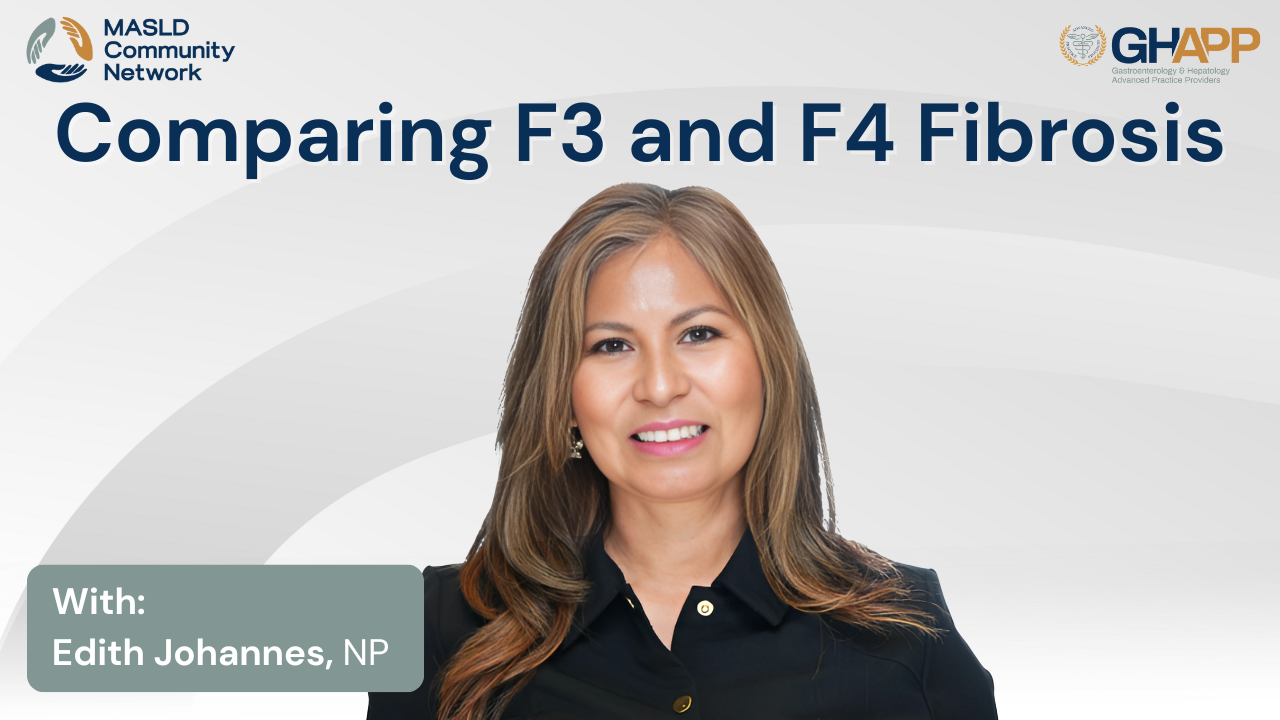
Comparing F3 and F4 Fibrosis With Edith Johannes

Join Edith Johannes, NP from UCLA Health, for a comprehensive and approachable introduction to MASLD (Metabolic Dysfunction-Associated Steatotic Liver Disease)—formerly known as NAFLD—and how to accurately diagnose it. Designed for primary care providers and early learners in hepatology, this session outlines the fundamental criteria for diagnosing MASLD and MASH, the importance of ruling out alternate causes of hepatic steatosis, and the key role of cardio-metabolic risk factors. Edith discusses how to apply non-invasive testing tools such as the FIB-4 score, ELF test, and elastography to determine fibrosis stage, along with guidance on when to consider liver biopsy and refer to hepatology. The presentation also explores the overlap between MASLD and alcohol-related liver disease, addresses the impact of genetic risk factors like PNPLA3 (particularly in Hispanic populations), and reinforces the urgent need for early detection to prevent cirrhosis and liver cancer. With clinical pearls and case-based examples, this session helps clinicians feel confident in evaluating patients for MASLD and navigating next steps for care.
Watch Now

Non-Invasive Testing With April Morris

In this educational presentation, April Morris, FNP—an experienced provider in both liver disease and endocrinology—guides viewers through the evolving landscape of non-invasive testing (NITs) for diagnosing and managing patients with MASLD (Metabolic Dysfunction-Associated Steatotic Liver Disease) and MASH. Using the case of a 65-year-old male with metabolic co-morbidities and suspected liver disease, Morris reviews how to effectively apply tools like the FIB-4 score, ELF test, and FibroScan (VCTE) to assess fibrosis risk and stratify patients. She compares imaging modalities including transient elastography, MR elastography (MRE), and shear wave elastography, offering practical considerations such as patient eligibility, test accuracy, and insurance barriers. The discussion emphasizes the importance of interpreting NITs within clinical context—highlighting how to determine risk, guide patient counseling, and establish a follow-up plan for low-risk patients. This session also reinforces the role of primary care in longitudinal liver health management and directs providers to resources available through the GHAPP MASLD & MASH Community Network.
Watch Now

Lifestyle Management With Whitney Steinmetz

In this case-based clinical discussion, Whitney Steinmetz, FNP from Presbyterian Medical Group in Albuquerque, New Mexico, offers an in-depth review of lifestyle management strategies for patients with MASLD and MASH. Using the case of a 65-year-old male with persistently elevated ALT and metabolic syndrome, she highlights the importance of individualized, culturally competent counseling around nutrition, exercise, and behavioral change. Steinmetz outlines how tools like the FIB-4 score and FibroScan can help guide management and determine fibrosis risk, while emphasizing the critical role gastroenterology providers must play in addressing obesity, insulin resistance, and dietary habits. From the utility of motivational interviewing and realistic meal planning to the integration of caloric restriction and personalized exercise, this presentation equips clinicians with practical tools to support sustainable behavior change in patients with metabolic liver disease. Genetic factors, social determinants of health, and patient empowerment are all addressed, offering a holistic perspective on disease progression and prevention.
Watch Now
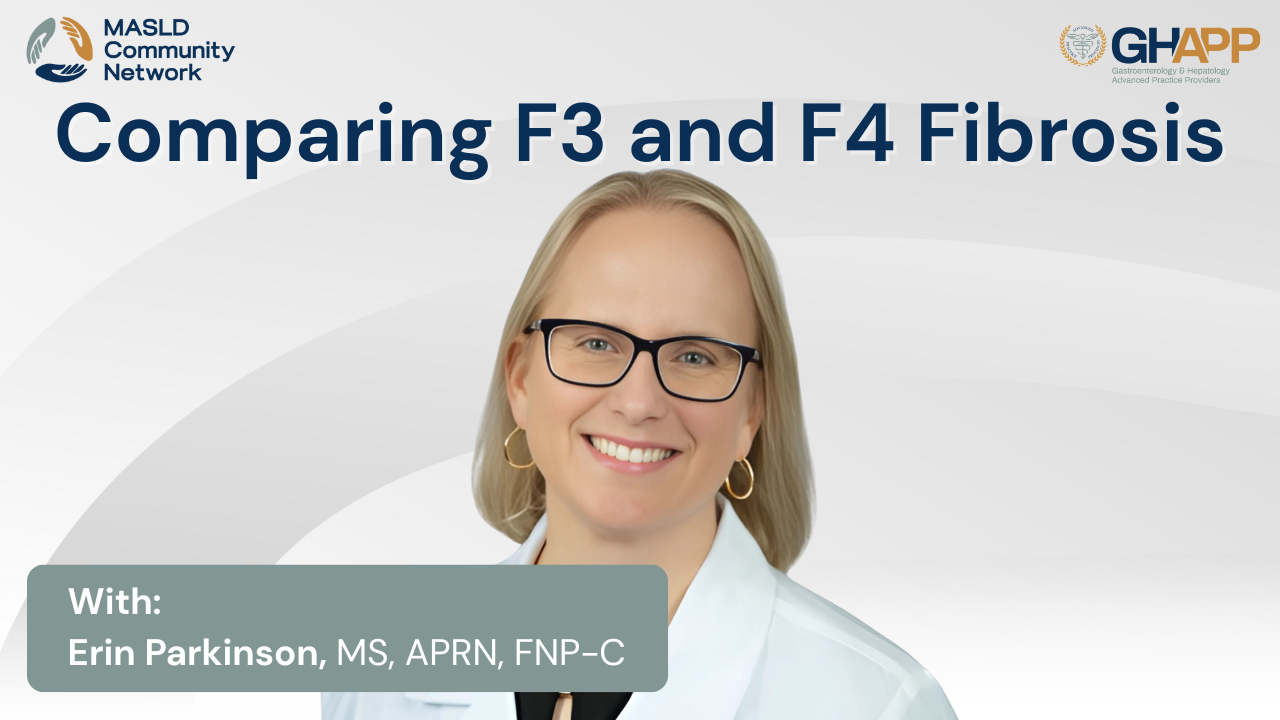
Comparing F3 and F4 Fibrosis With Erin Parkinson

In this in-depth clinical discussion, Erin Parkinson, NP from the Tampa General Medical Group Transplant Institute, walks through the nuanced process of differentiating stage 3 and stage 4 fibrosis in patients with MASLD (Metabolic Dysfunction-Associated Steatotic Liver Disease). Using two illustrative case studies, she explores key clinical signs, lab values, and non-invasive staging tools such as FibroScan, FIB-4, ELF score, and MR elastography. Parkinson discusses the importance of early identification of advanced fibrosis, the reversibility of stage 3 disease, and the implications of a diagnosis of cirrhosis. Erin outlines evidence-based treatment pathways including lifestyle interventions, use of GLP-1 receptor agonists, and initiation of resmetirom (Rezdiffra) for stage 2–3 fibrosis. For cirrhotic patients, the focus shifts to HCC surveillance, screening for clinically significant portal hypertension, and consideration of non-selective beta blockers like carvedilol. This video offers practical insights for hepatology providers navigating the evolving MASLD landscape and highlights how early intervention and accurate staging can impact long-term outcomes.
Watch Now

Non-Invasive Testing With Sherona Bau

In this engaging and highly informative GHAPP MASLD Community Network session, Sherona Bau, PA-C, walks attendees through a practical overview of non-invasive testing (NIT) for evaluating liver health in patients with MASLD (Metabolic dysfunction-associated steatotic liver disease) and MASH (Metabolic dysfunction-associated steatohepatitis). Drawing on real-world clinical experience, Sherona explains why non-invasive testing is essential for identifying fibrosis risk in a population where liver steatosis is prevalent in up to 30% of U.S. adults. Through the case of a 65-year-old Hispanic male named Albert, Sherona demonstrates how to interpret and apply tools such as FIB-4, FibroScan (VCTE and CAP score), ELF (Enhanced Liver Fibrosis) test, and MR Elastography (MRE). She highlights their respective strengths, limitations, clinical cut-offs, and insurance-related considerations. The session also covers when to order tests, how to assess data quality (e.g., IQR/median ratio in VCTE), and when to escalate care to hepatology or cardiology. Whether you are a primary care provider, endocrinologist, or hepatology specialist, this talk delivers practical algorithms and decision-making pathways for managing MASLD, improving early detection of fibrosis and cirrhosis, and integrating cardiovascular risk assessment into liver care. Sherona also emphasizes the importance of alcohol use history, metabolic syndrome risk factors, and annual NIT follow-up in patients at risk for disease progression.
Watch Now

Non-Invasive Testing With Erin Tanner

In this educational session from the GHAPP MASLD & MASH Community Network, Erin Tanner, PA-C from Gastro Health in Birmingham, Alabama, presents a practical overview of non-invasive testing (NIT) options for evaluating and managing MASLD (Metabolic dysfunction-associated steatotic liver disease) and MASH (Metabolic dysfunction-associated steatohepatitis). Using a patient case study, Erin explores how clinicians can effectively utilize tools like FIB-4, FibroScan® (VCTE and CAP), ELF, MRE, and other emerging imaging and serum biomarkers to assess hepatic steatosis and fibrosis without the need for liver biopsy. The talk breaks down the pros, cons, and clinical accuracy of various NITs—including shear wave elastography, MRI-PDFF, and proprietary serum markers—and offers guidance on how to apply these tools in real-world hepatology and primary care settings. Special attention is given to identifying patients with metabolic risk factors, interpreting indeterminate FIB-4 scores, and knowing when to refer patients for further hepatology evaluation. Whether you’re new to liver disease management or looking to update your MASLD/MASH care pathways, this session offers clarity on how to stratify fibrosis risk and make informed clinical decisions using non-invasive diagnostics.
Watch Now

Lifestyle Management With Erin Parkinson

In this impactful session from the GHAPP MASLD Community Network, Erin Parkinson, NP, explores the vital role of lifestyle modifications in the management of MASLD (Metabolic dysfunction-associated steatotic liver disease) and MASH (Metabolic dysfunction-associated steatohepatitis). Through the lens of a real-world case study, Erin illustrates how clinical tools like FIB-4 and FibroScan® can be used to assess fibrosis risk and guide interventions for patients presenting with metabolic syndrome and hepatic steatosis. With a focus on practical, personalized care, this presentation highlights how diet, exercise, and culturally sensitive counseling can meaningfully reduce hepatic fat, inflammation, and fibrosis—key factors in preventing progression to cirrhosis or hepatocellular carcinoma. Erin discusses the impact of processed foods, high-fructose corn syrup, and sedentary behavior, while offering actionable guidance on introducing Mediterranean diets, intermittent fasting, and realistic exercise goals tailored to individual readiness and barriers. Whether you're a hepatology specialist, primary care provider, or obesity medicine clinician, this talk delivers tools to better support patients with MASLD/MASH through sustainable behavioral change and longitudinal follow-up.
Watch Now
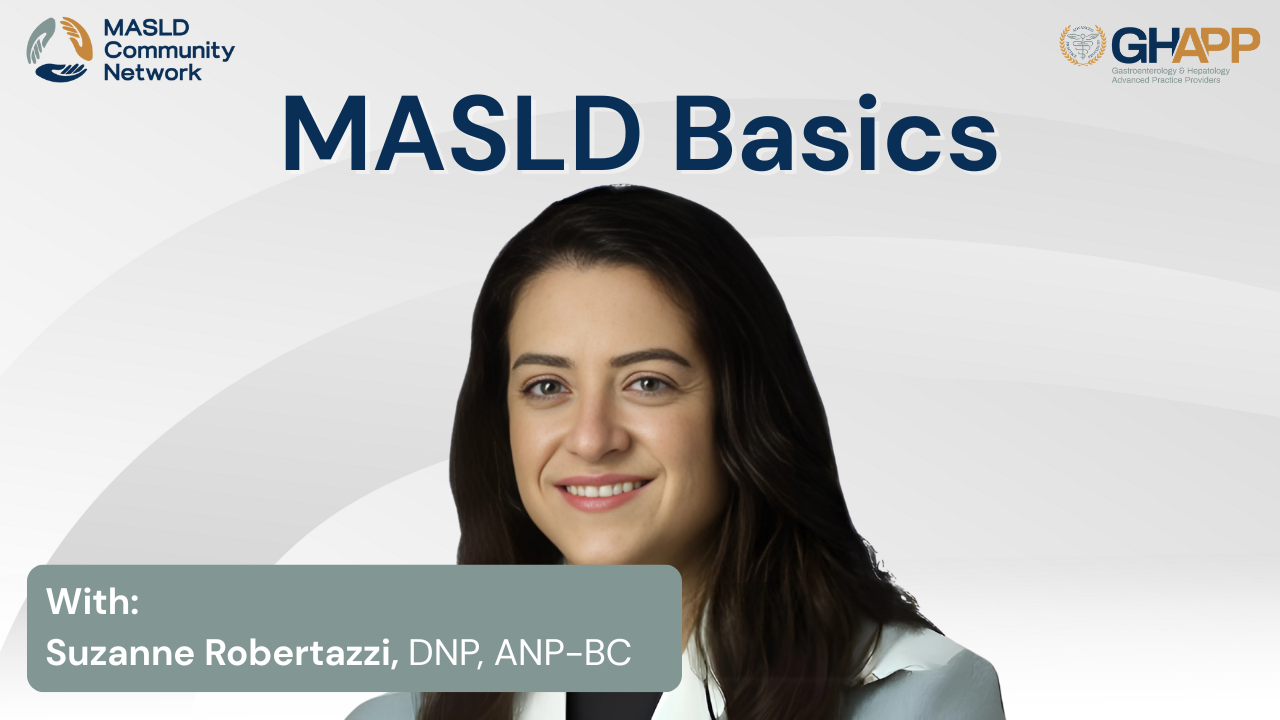
MASLD Basics With Suzanne Robertazzi

Join Suzanne, a nurse practitioner from the Washington DC VA Medical Center, as she kicks off a comprehensive lecture series on steatotic liver disease, focusing on the evolving understanding of MASLD (Metabolic dysfunction-associated steatotic liver disease) and MASH (Metabolic dysfunction-associated steatohepatitis). In this foundational session, Suzanne walks through the new nomenclature replacing NAFLD and NASH, and outlines the clinical criteria used to identify and stratify patients along the MASLD–MASH spectrum. Learn how metabolic risk factors such as obesity, prediabetes, hypertension, and dyslipidemia contribute to disease progression, and explore the use of non-invasive diagnostic tools like Fib-4, FibroScan, and ELF scores to assess fibrosis. The session also discusses indications for liver biopsy, the implications of overlapping etiologies (like alcohol-associated liver disease), and strategies for identifying patients at high risk for cirrhosis, hepatocellular carcinoma (HCC), and liver-related mortality. This lecture equips clinicians, particularly those in primary care and hepatology, with a practical framework to evaluate steatosis, interpret metabolic profiles, and determine when to refer patients for specialty care. Whether you're new to liver disease or looking for updates on MASLD and MASH terminology, this session is an essential starting point.
Watch Now
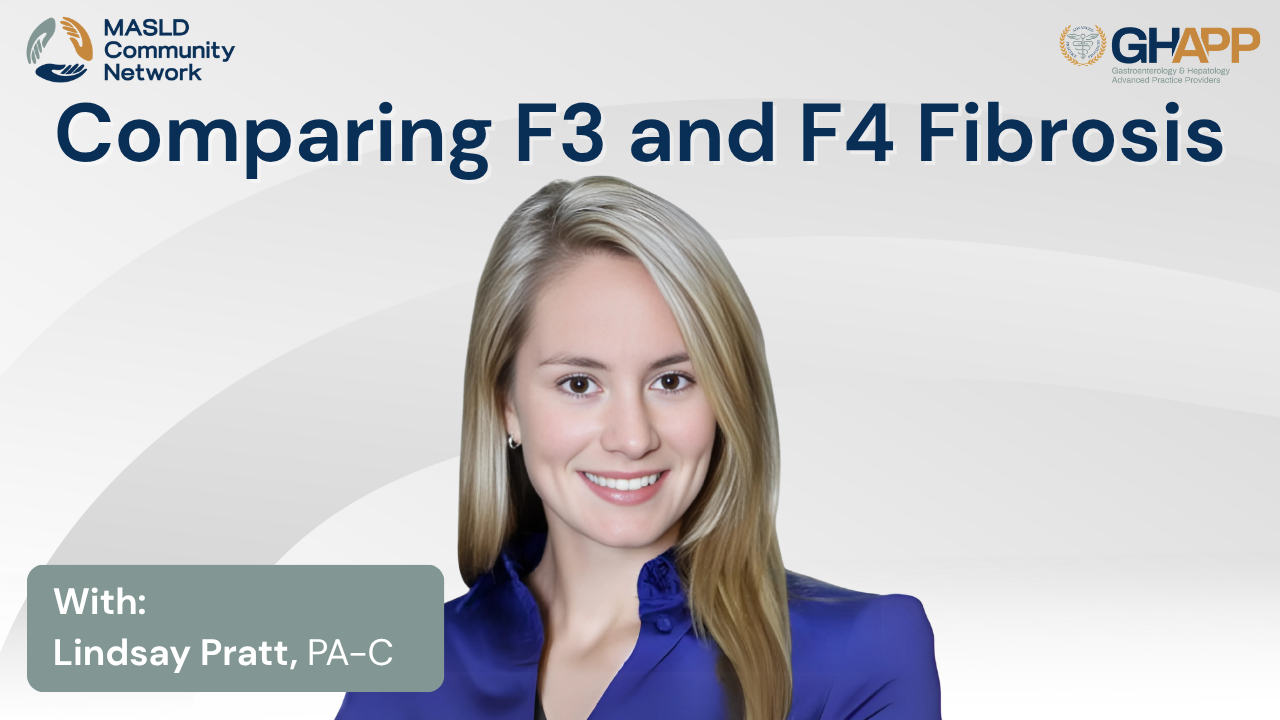
Comparing F3 and F4 Fibrosis With Lindsay Pratt

Join Lindsey Pratt, PA-C from the University of Colorado Liver Transplant Program, for an in-depth clinical comparison of F3 and F4 fibrosis in patients with MASLD (Metabolic Dysfunction–Associated Steatotic Liver Disease) and MASH (Metabolic Dysfunction–Associated Steatohepatitis). Using an identical patient profile with differing non-invasive testing results, Lindsey demonstrates how to accurately stage fibrosis using tools like FIB-4, FibroScan, CAP score, and ELF test—emphasizing when pharmacologic intervention is appropriate and when advanced monitoring becomes critical. This session explores the clinical implications of fibrosis staging, treatment pathways including resmetirom (Rezdiffra), the role of GLP-1 receptor agonists, and practical nutrition and lifestyle strategies. For F4 patients, Lindsey outlines key elements of surveillance for hepatocellular carcinoma (HCC), portal hypertension management, and transplant evaluation. Whether you're in hepatology or primary care, this case-based discussion offers evidence-backed guidance for managing patients across the MASLD/MASH spectrum and preventing liver disease progression.
Watch Now
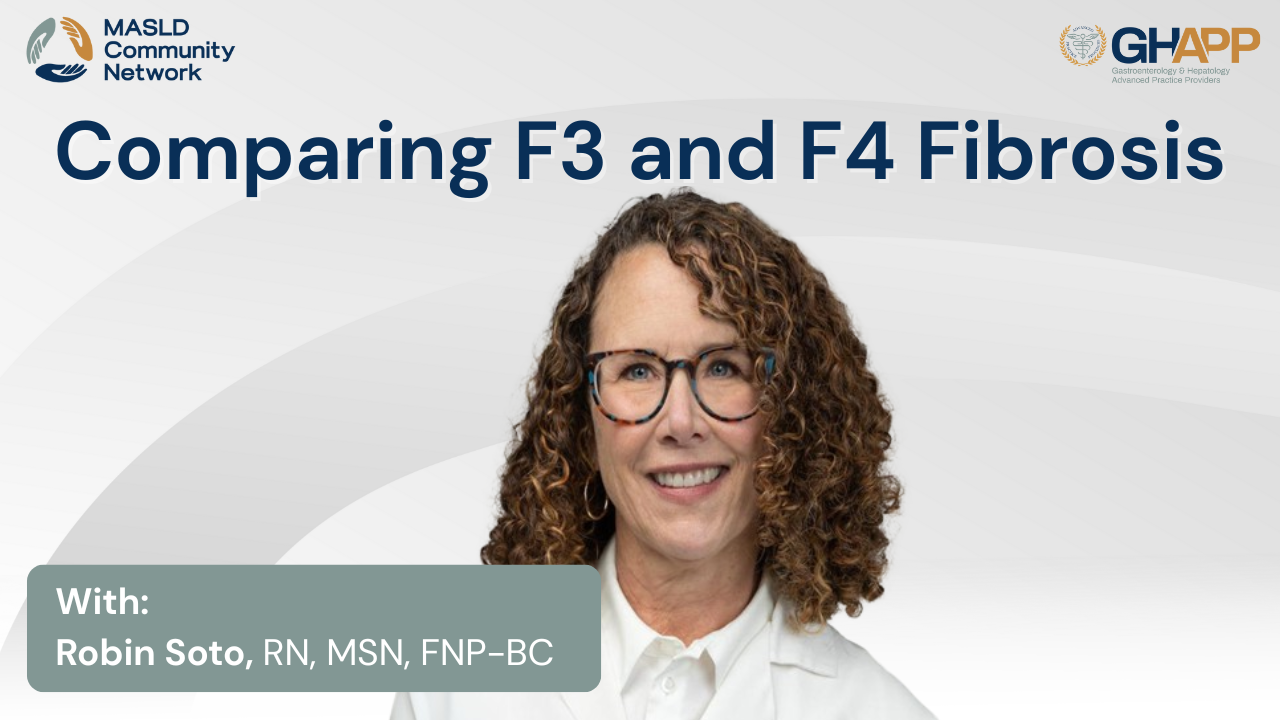
Comparing F3 and F4 Fibrosis With Robin Soto

In this in-depth case-based session from the GHAPP MASLD/MASH Community Network, Robin Soto, NP from UC San Diego Health, explores the clinical nuances of diagnosing and managing fibrosis stage 3 versus stage 4 in patients with MASH (Metabolic Dysfunction–Associated Steatohepatitis). Using a real-world case study of a patient named Sam, Robin demonstrates how to interpret and reconcile non-invasive tests (NITs) like FIB-4, FibroScan, CAP score, and ELF test to guide accurate staging. She offers practical insights into treatment decisions, including when to use resmetirom, the importance of lifestyle modification, and how to assess comorbidities like diabetes, obesity, and cardiovascular risk. The session also outlines when and how to monitor for hepatocellular carcinoma (HCC), implement liver cancer surveillance strategies, and approach multidisciplinary care for advanced fibrosis or cirrhosis. Whether you’re a hepatology specialist or a primary care provider, this video equips you with evidence-based tools for managing MASLD and optimizing outcomes in complex liver disease.
Watch Now
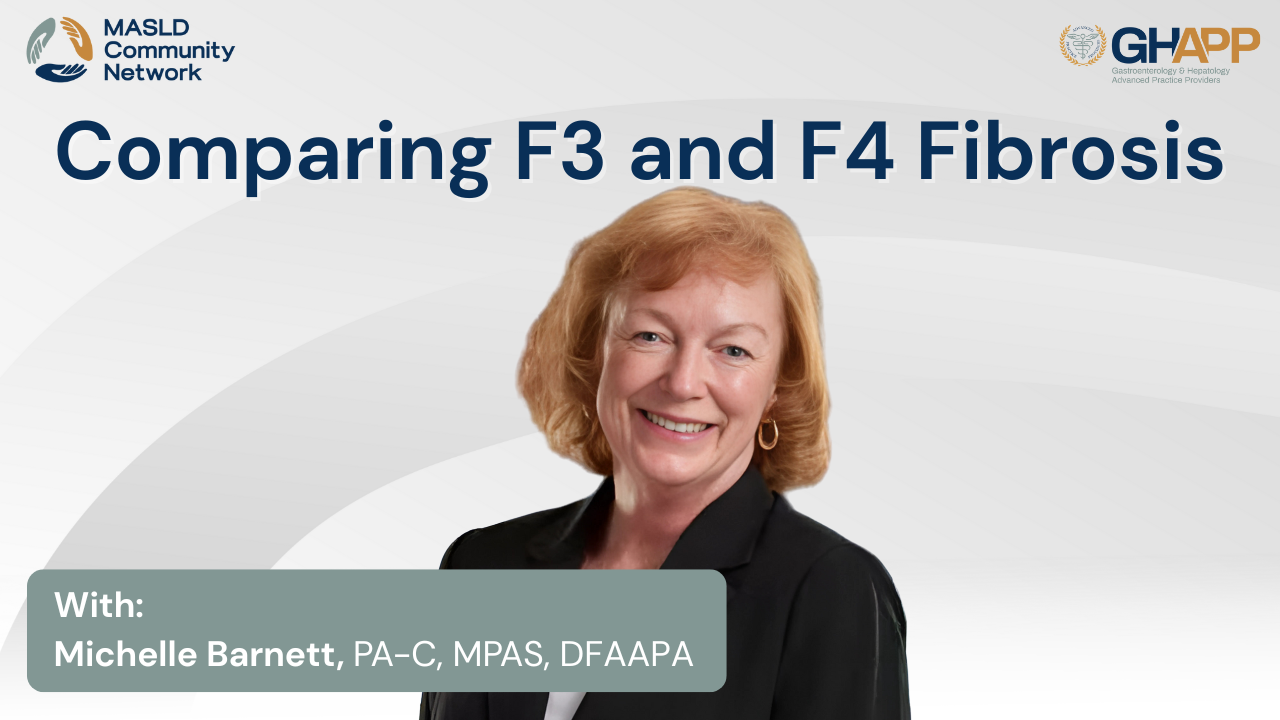
Comparing F3 and F4 Fibrosis With Michelle Barnett

In this installment of the GHAPP MASLD Community Network, Michelle Barnett, PA-C from Peak Gastroenterology in Colorado Springs, presents a deep dive into the clinical management of MASH—formerly known as NASH or non-alcoholic steatohepatitis. Through two comparative case studies, Michelle explores the nuances of diagnosing and managing patients with F3 and F4 fibrosis. Learn how to effectively use non-invasive diagnostic tools like FIB-4, FibroScan, and ELF testing, and gain valuable insights into stratifying fibrosis risk, monitoring hepatocellular carcinoma (HCC), and determining when resmetirom is appropriate. This session also covers practical guidance on nutrition, exercise, medication safety, and multidisciplinary care for patients with advanced liver disease. Whether you're a hepatology specialist or a primary care provider navigating the MASLD/MASH landscape, this video offers actionable strategies to improve long-term patient outcomes and reinforces the critical role of lifestyle intervention and liver disease surveillance.
Watch Now

Lifestyle Management With Lisa Richards

Join Lisa Richards, FNP-BC, from UC San Diego Health, as she leads a powerful educational session on the lifestyle management of MASLD (Metabolic Dysfunction–Associated Steatotic Liver Disease) in this GHAPP MASLD/MASH Community Network event, sponsored by Madrigal Pharmaceuticals. Through a compelling clinical case study, Lisa walks viewers through a step-by-step approach to diagnosing MASLD, assessing fibrosis risk using noninvasive tools like FIB-4 and FibroScan, and implementing guideline-based interventions. Learn how to counsel patients on culturally sensitive dietary modifications, physical activity strategies, and behavior change techniques that improve outcomes. This session also explores the clinical relevance of weight loss thresholds, Mediterranean-style eating plans, and the importance of patient-centered goal setting. Whether you’re a provider managing metabolic liver disease or looking to integrate newer therapies like resmetirom, this video offers practical tools to empower sustainable change and improve liver health.
Watch Now
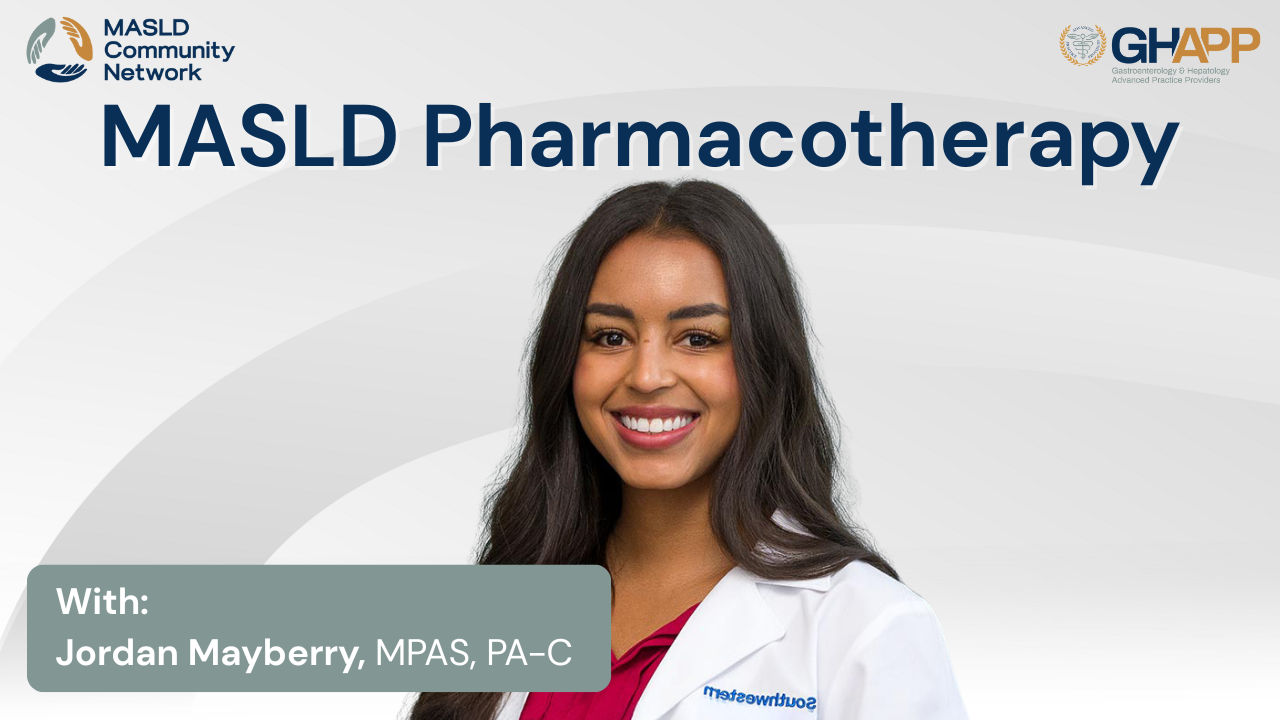
MASLD Pharmacotherapy With Jordan Mayberry

Join Jordan Mayberry, MPAS, PA-C from UT Southwestern, for an insightful session from the GHAPP MASLD/MASH Community Network focused on the evolving landscape of pharmacotherapy in MASLD and MASH. This presentation explores evidence-based strategies for treating metabolic dysfunction–associated steatotic liver disease (MASLD), with an emphasis on weight loss, diabetes management, and liver-directed therapies. Jordan breaks down key data on GLP-1 receptor agonists, SGLT2 inhibitors, Vitamin E, pioglitazone, and highlights the latest clinical evidence supporting the use of Resmetirom—the first FDA-approved treatment for MASH with stage 2 or 3 fibrosis. Learn how these therapies fit into hepatology practice, including clinical considerations, side effect management, and patient selection. Stay up to date on ongoing research, treatment duration, and real-world application of these new therapies. Don’t forget to register and join the GHAPP MASLD/MASH Community Network for continued education and access to valuable resources.
Watch Now
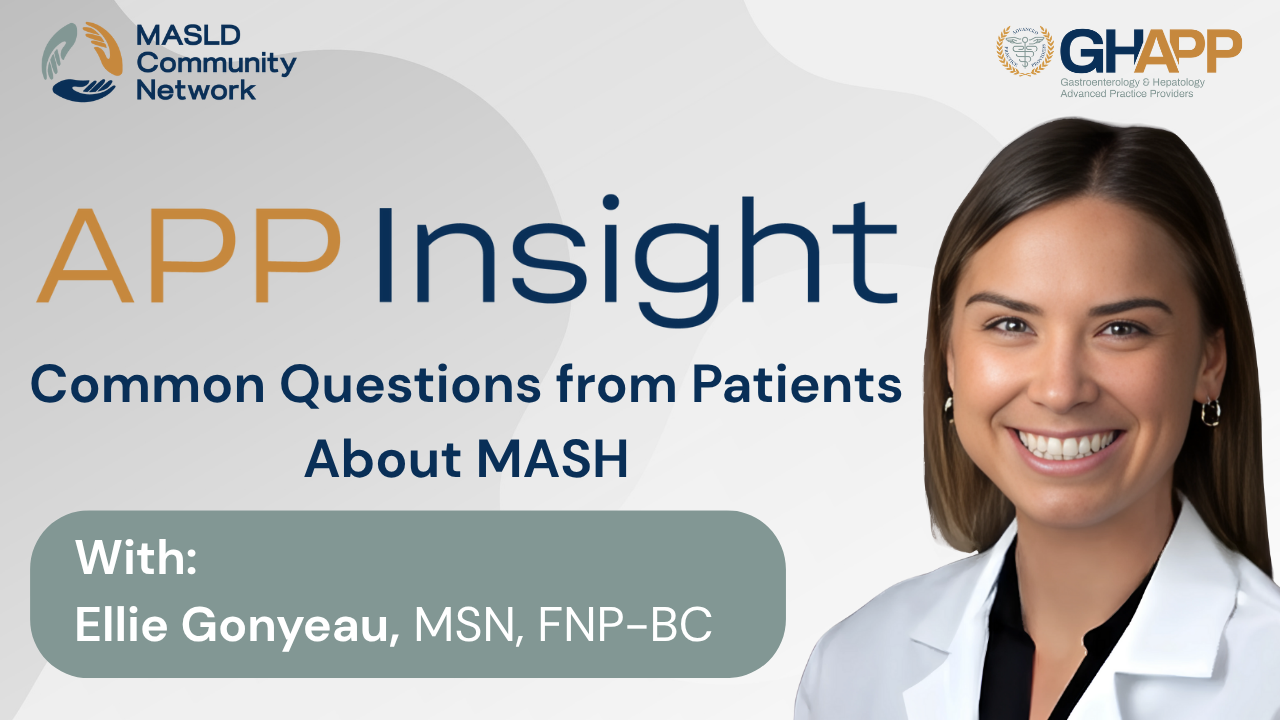
Common Questions From Patients About MASH

In this informative video, Ellie Gonyeau, a nurse practitioner in general gastroenterology at Beth Israel in Boston, answers some of the most common questions she hears from patients about MASLD (Metabolic dysfunction-Associated Steatotic Liver Disease). With compassion and clarity, Ellie addresses concerns about the seriousness of the condition, explaining that while MASLD can progress to advanced liver disease, early intervention can make a significant difference. She emphasizes the importance of not delaying care and encourages patients to take manageable steps—like losing just 5–10% of their body weight—to reduce liver inflammation and slow disease progression. Nutrition, exercise, and proactive conversations are central to her patient-centered approach. Whether you're newly diagnosed or seeking guidance, this episode offers valuable, practical insights for anyone navigating MASLD. #MASLD #FattyLiver #LiverHealth #GIcare #BethIsrael #NursePractitioner #Gastroenterology #PatientEducation #LiverDisease #WeightLossSupport
Watch Now
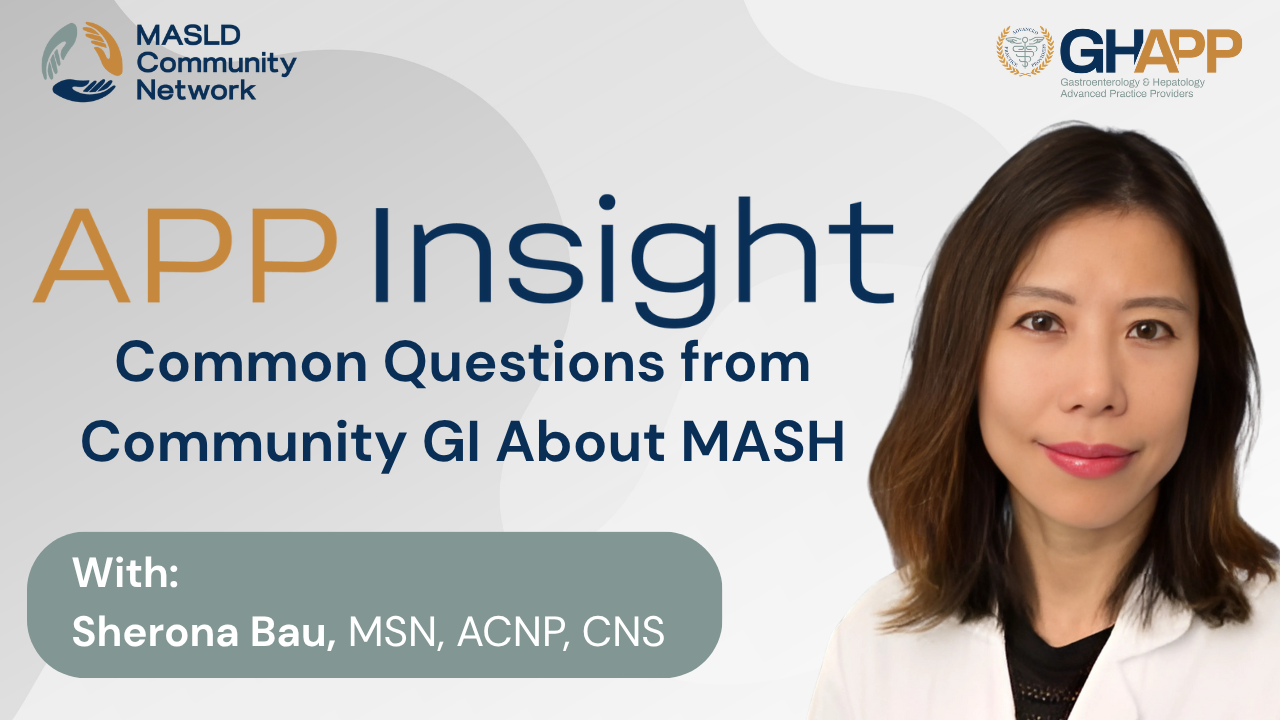
Common Questions from Patients About MASH

In this impactful episode, Sherona Bau, NP from UCLA, addresses the most frequent and pressing questions patients ask after being diagnosed with MASLD (Metabolic dysfunction-associated steatotic liver disease) or MASH (Metabolic-associated steatohepatitis)—including concerns about life expectancy, risk of liver failure, liver cancer, and genetic impact on family members. She emphasizes the importance of risk stratification using non-invasive testing, particularly FibroScan®, to determine the extent of fat accumulation and liver fibrosis. Sherona explains that early identification of stage 2 or 3 fibrosis is critical, as treatment options are now available for these stages, offering hope for patients. She also stresses that MASLD is not just a liver disease—it's a systemic, metabolic condition—and encourages coordinated care with endocrinologists, cardiologists, and dietitians. Additionally, she discusses the hereditary nature of fatty liver and the importance of family screening, especially for children of affected individuals. This video offers clear, compassionate guidance for patients and providers navigating the complexities of fatty liver disease.
Watch Now

Common Questions from Community GI About MASH

In this practical and timely video, Erin Tanner, NP at Gastro Health in Birmingham, Alabama, shares expert insights on how community gastroenterology providers should approach incidental findings of fatty liver (MASLD/MASH) on abdominal imaging. With over 14 years of experience in GI and hepatology, Erin emphasizes that fatty liver can no longer be ignored, even when discovered during workups for unrelated GI symptoms like reflux or diarrhea. She walks through the step-by-step use of the FIB-4 index to risk-stratify patients and explains when to follow up with further non-invasive testing such as FibroScan® or ultrasound elastography. For patients with F3 fibrosis, Erin outlines next steps including lifestyle interventions, the use of Resmetirom, and the promise of GLP-1 therapies for future treatment. This is a must-watch for GI clinicians aiming to improve outcomes by proactively managing fatty liver disease in everyday practice.
Watch Now
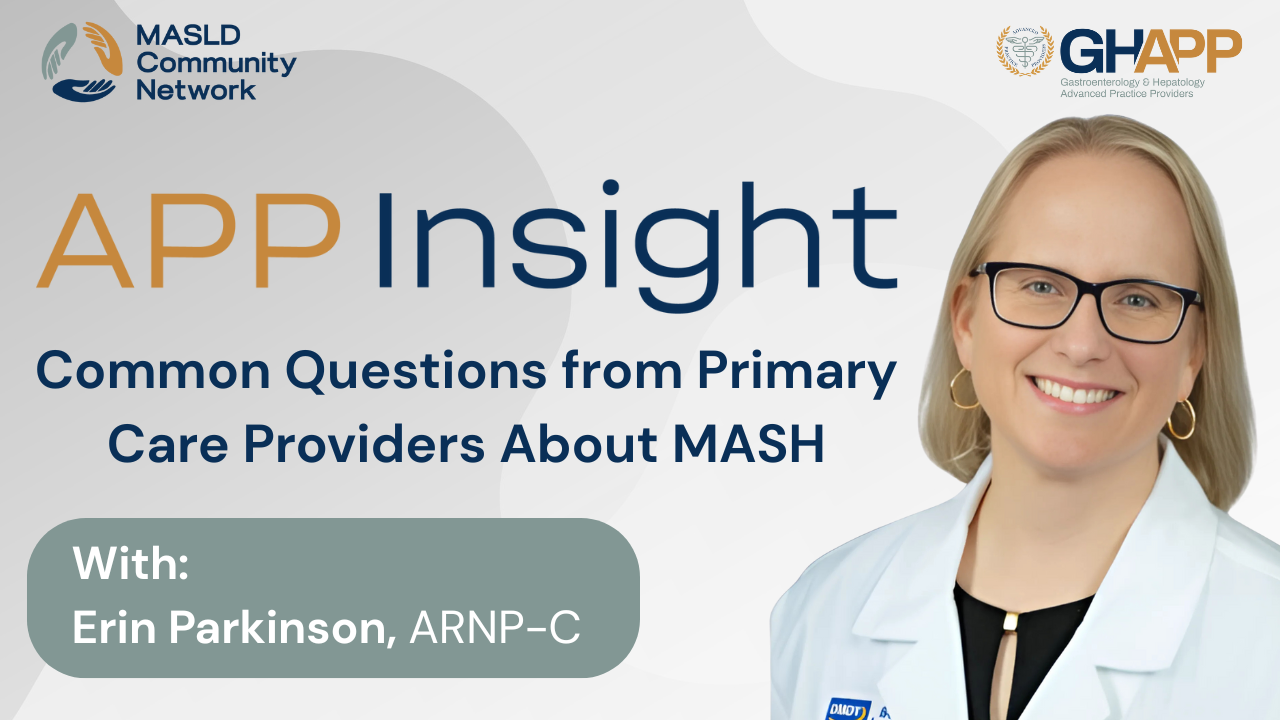
Common Questions from Primary Care Providers About MASH

In this educational video, Erin Parkinson, ARNP-C at the Transplant Institute at Tampa General Medical Group, addresses two of the most frequently asked questions from primary care providers about MASLD (Metabolic dysfunction-associated steatotic liver disease) and MASH (Metabolic-associated steatohepatitis). First, she explains when it’s appropriate to refer a patient to GI or hepatology, emphasizing the use of FIB-4 for risk stratification and recommending referral when scores are indeterminate or high, especially if a FibroScan® result shows ≥8 kPa. Erin also discusses lifestyle interventions, reinforcing the importance of weight loss and dietary modification, with strong endorsement of the Mediterranean diet—a recommendation supported by major liver societies. She also notes that intermittent fasting may be a helpful adjunct for patients seeking to improve liver health through sustainable weight reduction. This video provides practical tools for frontline providers to improve early detection and management of fatty liver disease.
Watch Now
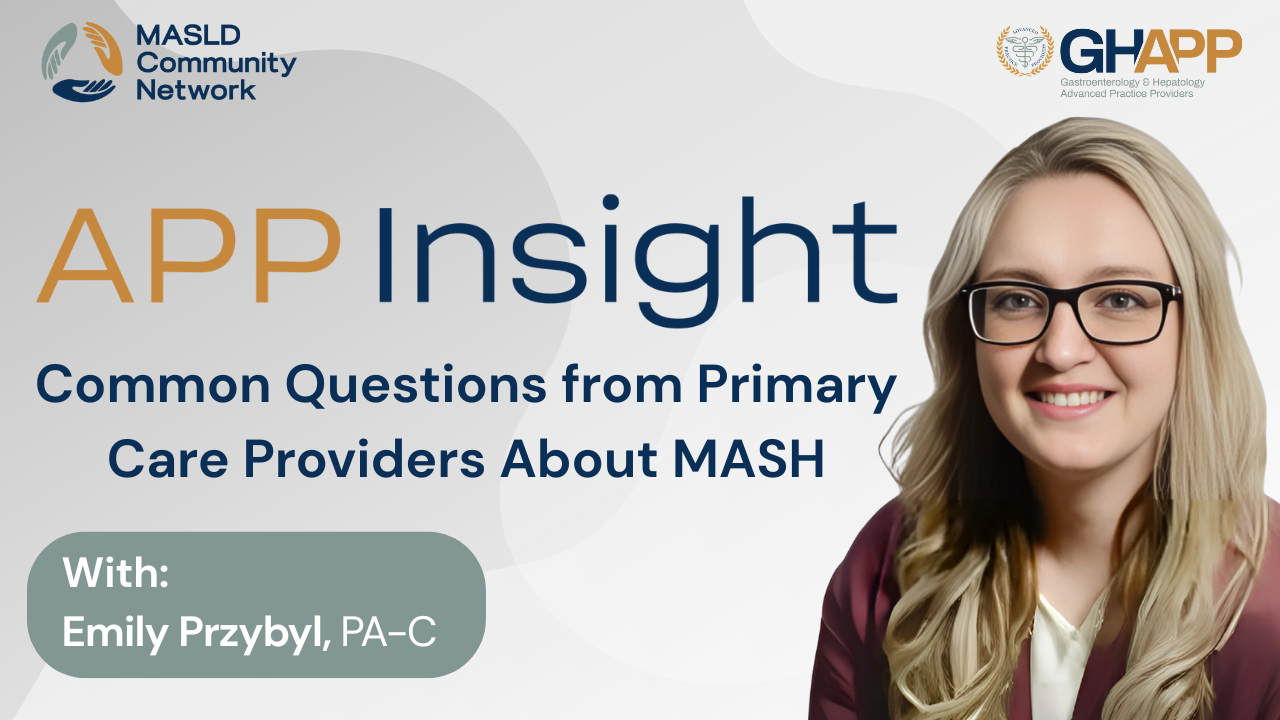
Common Questions from Primary Care Providers About MASH

In this informative episode, Emily Przybyl, PA-C at Erie County Medical Center in Buffalo, NY, answers two of the most common questions primary care providers have about MASLD (Metabolic dysfunction-associated steatotic liver disease) and MASH (Metabolic-associated steatohepatitis): When should I refer to hepatology? and Is it safe to prescribe statins in patients with fatty liver disease? Emily explains that any history of hepatic steatosis on imaging or elevated liver enzymes (LFTs) is reason enough to initiate referral for further workup, including non-invasive testing like FIB-4 or FibroScan®. She also debunks the common myth that statins should be avoided in this population, emphasizing that statins are not contraindicated and are critical for managing cardiometabolic risk factors that drive liver disease progression. This episode is a must-watch for clinicians navigating MASLD/MASH in primary care, with practical guidance that supports early intervention and evidence-based management.
Watch Now
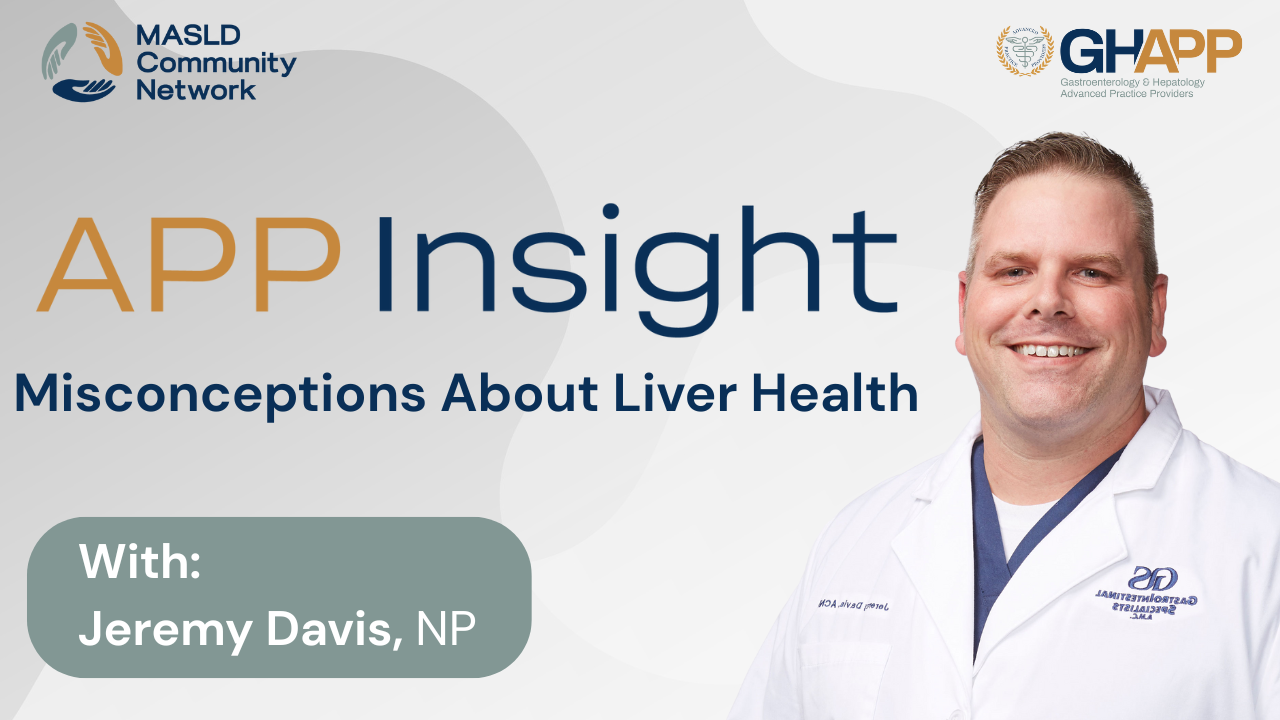
Misconceptions About Liver Health

In this quick but powerful video, Jeremy Davis, NP from Shreveport, Louisiana, addresses some of the most common misconceptions about liver health that he encounters in clinical practice. Many patients believe that liver disease only occurs in people who drink alcohol, but Jeremy explains how conditions like MASLD (Metabolic dysfunction-associated steatotic liver disease) and MASH (Metabolic-associated steatohepatitis) can affect individuals regardless of alcohol use. He also clears up the myth that only overweight patients are at risk, pointing out that co-morbidities such as hypertension, high cholesterol, cardiovascular disease, and type 2 diabetes can contribute to liver disease—even in patients with a normal BMI. Finally, Jeremy explains why normal liver enzyme labs (ALT and AST) don’t always rule out liver disease, making it crucial to assess underlying risk factors and improve provider and patient awareness. This video is a valuable resource for both healthcare professionals and patients looking to better understand non-alcoholic liver disease and why early screening matters.
Watch Now
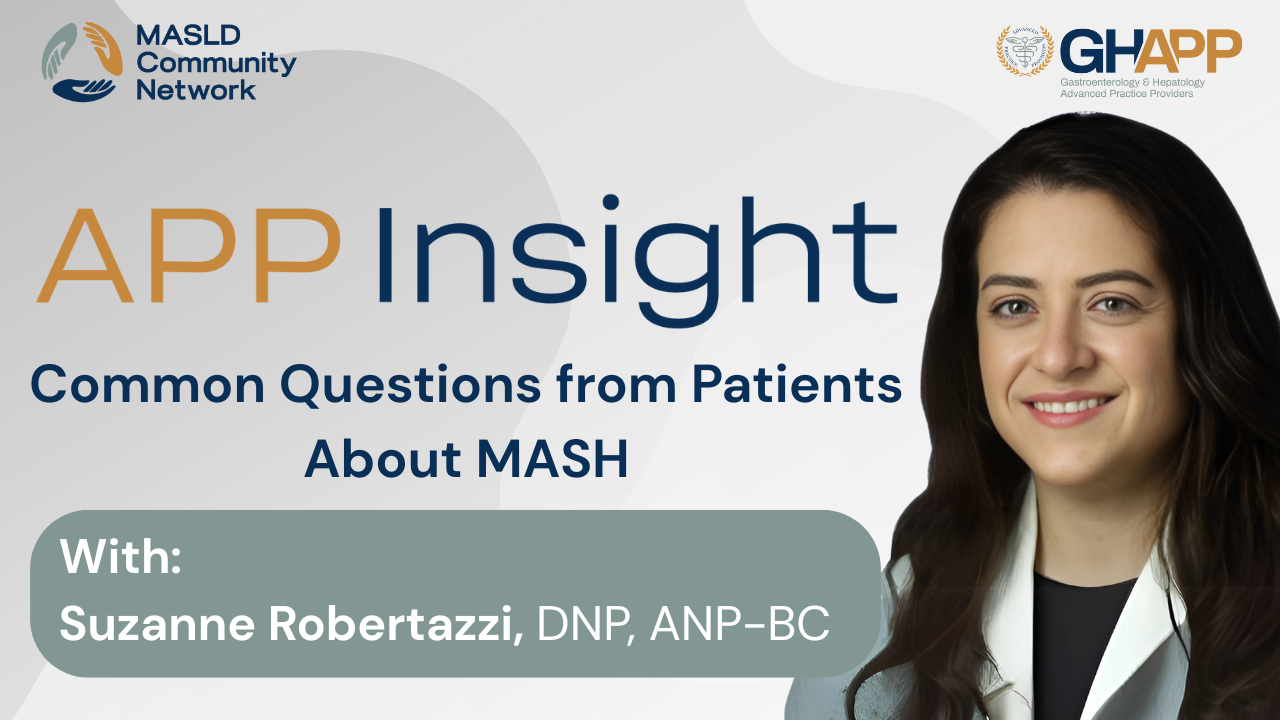
Common Questions from Patients About MASH

In this focused episode, Suzanne Robertazzi, NP at the Washington DC VA, shares expert insights on how to prevent recurrence of MASH (Metabolic-associated steatohepatitis) and MASLD (Metabolic dysfunction-associated steatotic liver disease) in liver transplant recipients. Drawing on her experience caring for post-transplant veterans, Suzanne explains that MASH can return even after liver transplantation, making ongoing metabolic management essential. She outlines key strategies including tight blood sugar and blood pressure control, especially since transplant medications can contribute to hypertension. Suzanne also emphasizes the importance of introducing regular physical activity post-recovery and adopting a Mediterranean-style diet—while tailoring nutrition guidance to meet the needs of patients in urban settings with limited access to fresh foods. This video is a must-watch for transplant teams, hepatology providers, and patients seeking to extend the life and health of their new liver through evidence-based lifestyle and clinical interventions.
Watch Now
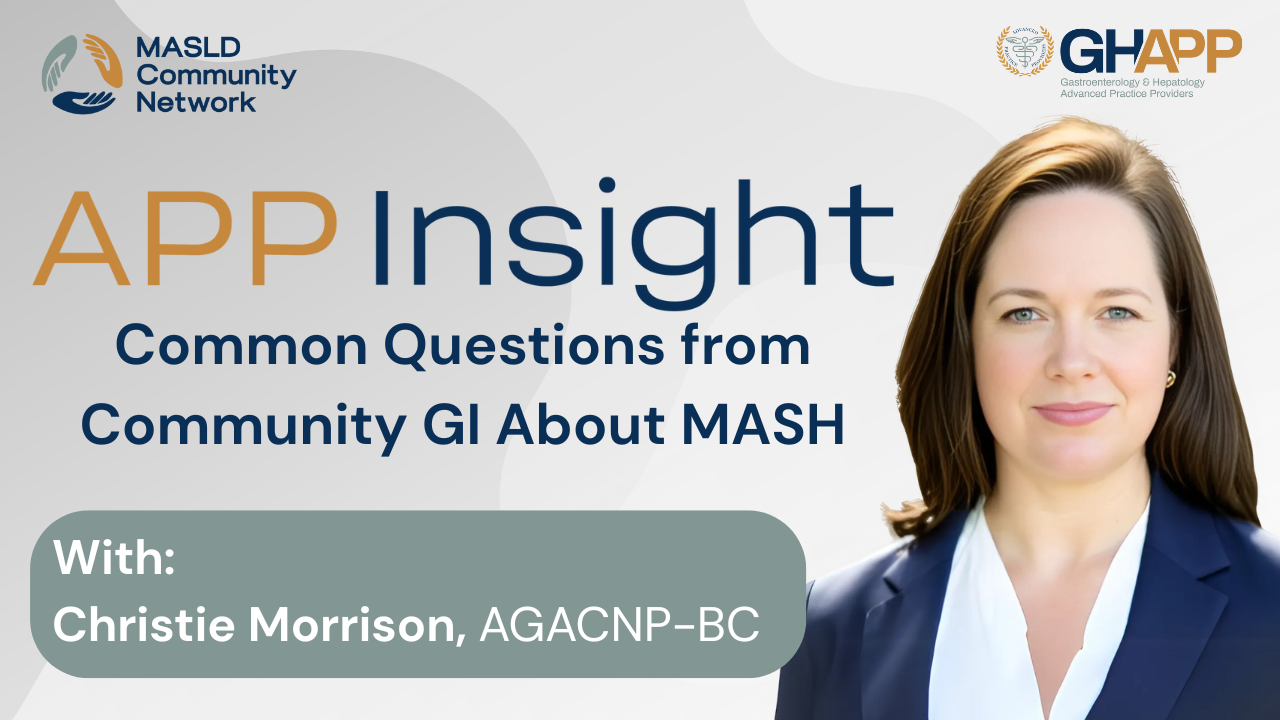
Common Questions from Community GI About MASH

In this insightful video, Christie Morrison, a local advanced practice provider with the GHAPP MASLD/MASH Community Network, answers two of the most frequently asked questions from community GI providers: when to refer patients with MASH to a transplant center and how to evaluate liver fibrosis when FibroScan® isn’t accessible. Christy emphasizes the importance of using non-invasive testing (NITs)—including FIB-4 and ELF (Enhanced Liver Fibrosis) scores—to help identify patients with F3 fibrosis, who are at higher risk for rapid progression to cirrhosis and hepatocellular carcinoma (HCC). She encourages early referral to transplant hepatology to avoid delays in care, especially given long wait times and the value of multidisciplinary support teams at transplant centers. For clinicians without access to FibroScan, Christy shares practical alternatives such as ordering reflex testing to ELF via major labs and leveraging easy-to-use digital tools like MDCalc for FIB-4 calculation. This episode is a valuable resource for GI providers looking to optimize liver care pathways and prevent late-stage complications in MASLD and MASH patients.
Watch Now
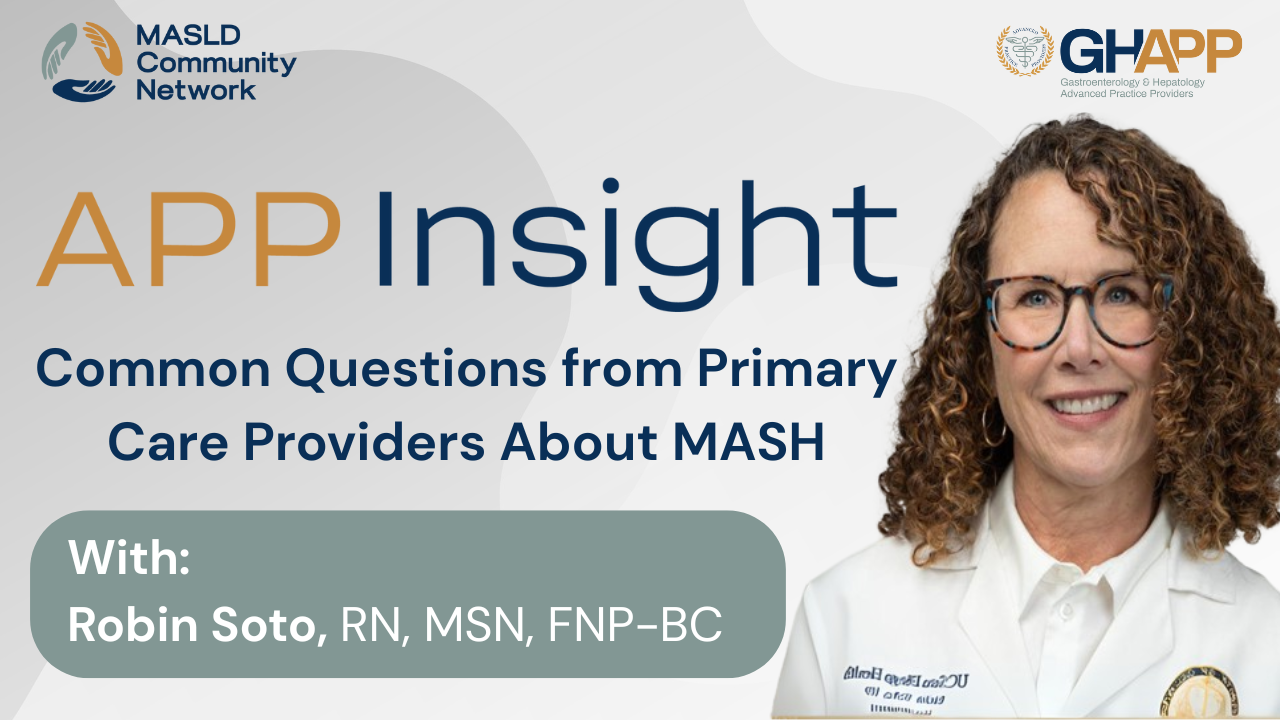
Common Questions from Primary Care Providers About MASH

In this educational video, Robin Soto, RN, MSN, FNP-BC from UC San Diego Health, answers common questions from primary care providers about the progression and management of MASLD (Metabolic dysfunction-associated steatotic liver disease) and MASH (Metabolic-associated steatohepatitis). She addresses the often-misunderstood reality that fatty liver disease can progress to cirrhosis, even in patients with no history of alcohol use—challenging the stigma that surrounds liver disease. Robin explains how MASH is a progressive condition, and if left unmanaged, can lead to advanced fibrosis and liver failure. She also shares practical dietary advice for patients, highlighting the benefits of the Mediterranean diet—rich in healthy fats, fiber, and low in processed foods and sugars—as recommended by hepatology societies like AASLD. Importantly, she emphasizes that even modest weight loss (3–10%) can significantly improve steatosis, inflammation, and even reverse fibrosis. This video is a valuable resource for clinicians and patients alike, focused on prevention, early intervention, and empowering lifestyle changes.
Watch Now
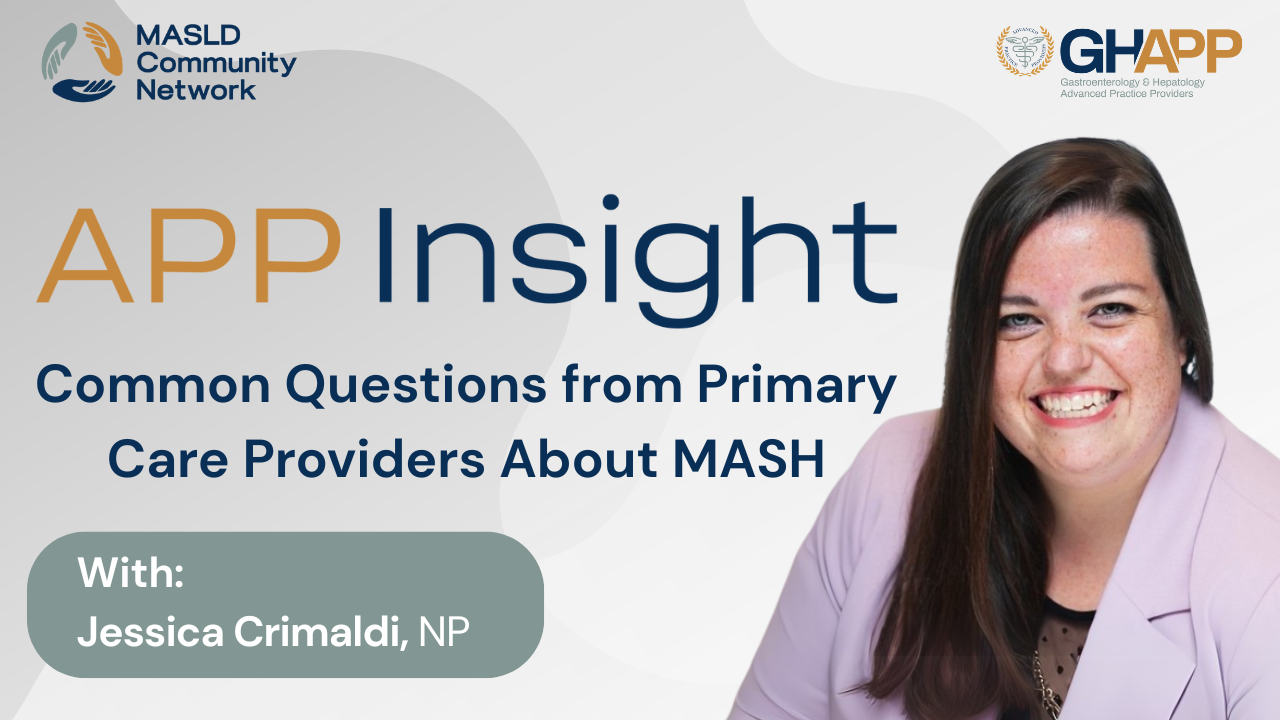
Common Questions From Primary Care Providers About MASH

In this insightful episode, Jessica Crimaldi, NP from the Cleveland Clinic, addresses two of the most frequently asked questions from primary care providers about MASLD (Metabolic dysfunction-associated steatotic liver disease) and MASH (Metabolic-associated steatohepatitis). First, she clarifies a common concern regarding statin use in patients with liver disease, emphasizing that statins are not only safe in most cases—including compensated cirrhosis—but also beneficial in managing cardiometabolic risk factors and slowing disease progression. She explains when statins are contraindicated and encourages collaboration with hepatology if there are concerns. Second, Jessica outlines a practical pre-referral workup for suspected MASLD/MASH patients. She details the labs needed to calculate FIB-4, suggests ordering an INR, and highlights the importance of screening for viral hepatitis, autoimmune liver disease, and common genetic liver disorders. This episode offers clear, actionable guidance for providers managing fatty liver disease in primary care and is a valuable resource for improving early diagnosis and coordinated care.
Watch Now

Common Questions From Community GI About MASH

In this session, Lavinia Iordache, PA-C, from the University of Miami, draws on a decade of experience in inpatient and outpatient hepatology to address common management questions related to MASLD (Metabolic dysfunction-associated steatotic liver disease) and MASH (Metabolic-associated steatohepatitis). She provides practical guidance for gastroenterology providers navigating when to monitor versus refer patients with fibrosis, how to interpret and time non-invasive testing (NITs) such as FIB-4, and when liver biopsy may still play a role—particularly in cases with persistently elevated liver enzymes despite lifestyle improvement. Lavinia also dives into the referral criteria for hepatology, the evolving role of resmetirom in stage 2–3 fibrosis, and the critical topic of HCC screening. While current AASLD guidelines limit HCC surveillance to cirrhosis, Lavinia highlights emerging evidence and EASL recommendations supporting imaging in patients with F3 fibrosis based on individualized risk factors like diabetes, genetics, and obesity. She also explains why CT or MRI is often preferred over ultrasound in MASLD patients due to obesity-related imaging limitations. This is a must-watch for hepatology and GI teams managing liver fibrosis in metabolic disease.
Watch Now
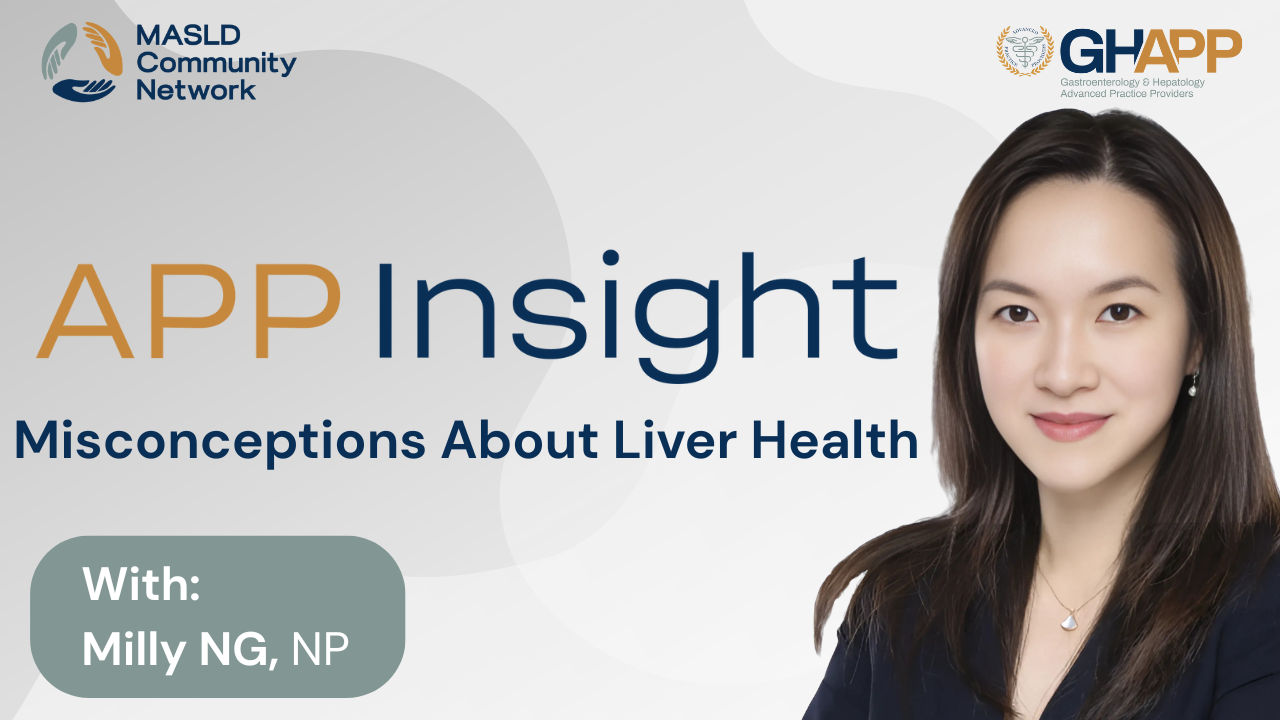
Misconceptions About Liver Health

In this short and informative video, Miu Lai Ng, a nurse practitioner at Tufts Medical Center, debunks two of the most common myths about liver health. First, she sets the record straight on liver cleanses and detox teas—explaining that your liver already detoxifies your body daily and doesn’t need fad diets or trendy supplements. Instead, what your liver needs is support through sustainable habits like reducing alcohol intake, cutting back on processed sugars, and maintaining a healthy weight. She also highlights a critical point: liver disease is often silent, and many people with significant liver damage have no symptoms until it’s advanced. If you're at risk due to metabolic syndrome, alcohol use, or other factors, Miu Lai urges you to talk to your healthcare provider about screening options like FIB-4 or FibroScan®. Your liver works hard for you—this video is a reminder to return the favor with real, lasting care.
Watch Now
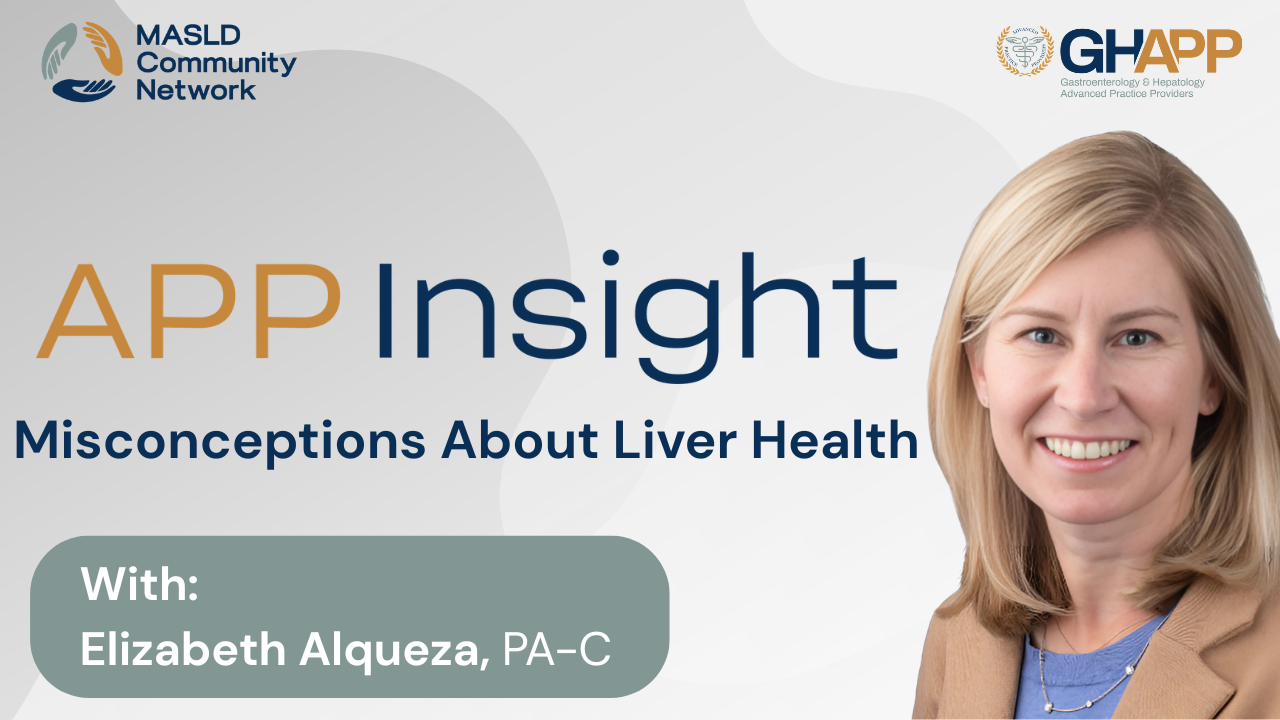
Misconceptions About Liver Health

In this quick myth-busting session, Elizabeth Alqueza, PA-C from Beth Israel Deaconess Medical Center in Boston, addresses two of the most common misconceptions in hepatology related to steatotic liver disease (MASLD/MASH). First, she explains that liver disease is not always fixed or irreversible—and with proper management and elimination of the underlying cause, liver fibrosis can improve over time, a trend often monitored through FibroScan®. Second, she clarifies that significant liver improvement does not require extreme weight loss. In fact, a modest 5–10% reduction in total body weight—sometimes as little as 10–20 pounds—can lead to measurable improvements in liver inflammation and fibrosis. This video is ideal for providers and patients seeking a clearer understanding of how lifestyle changes can reverse liver disease and why timely, targeted interventions matter.
Watch Now
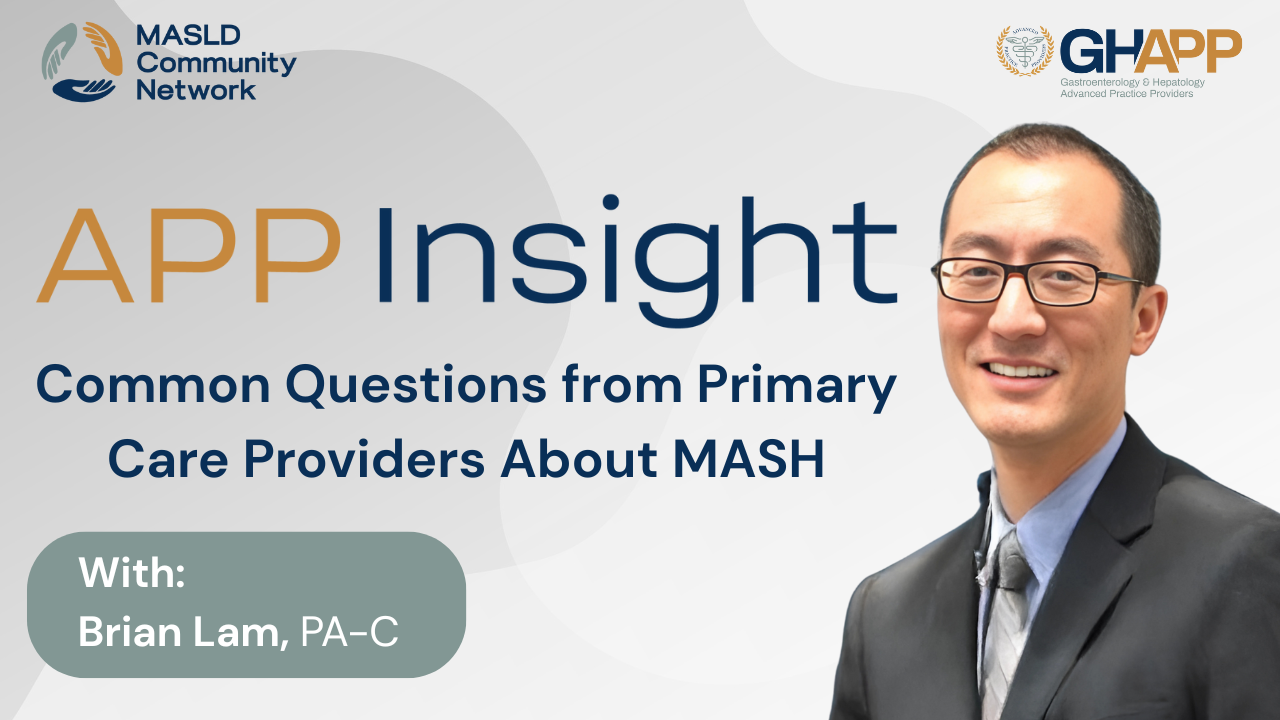
Common Questions from Primary Care Providers About MASH

In this FAQ session, Brian Lam, PA-C, breaks down a common question he receives from primary care providers, endocrinologists, and even other GI specialists: Which patients with fatty liver should be referred to hepatology or GI for further evaluation? Using a clear and practical approach, Brian explains how to apply FIB-4, a simple lab-based non-invasive test, to guide referrals. He emphasizes that patients with metabolic syndrome—especially those with diabetes—are at significantly higher risk for MASH (Metabolic dysfunction-associated steatohepatitis), with roughly 1 in 3 diabetic patients affected. If the FIB-4 is greater than 1.3, or greater than 2.0 in adults over 65, it's time to refer. Brian also highlights the utility of FIB-4 with reflex to ELF, now available through major labs like LabCorp and Quest, as an efficient two-step method to detect advanced fibrosis and at-risk MASH. This video is perfect for busy clinicians looking for a referral-friendly workflow to catch MASH early and improve liver health outcomes in high-risk populations.
Watch Now

Non-Invasive Testing With Jordan Mayberry

In this educational session, Jordan Mayberry, PA-C from UT Southwestern, presents a practical overview of non-invasive testing for diagnosing and staging metabolic dysfunction-associated steatotic liver disease (MASLD) and metabolic-associated steatohepatitis (MASH). Using a real-world patient case, Jordan discusses how clinicians can leverage key tools—such as FIB-4, ELF testing, FibroScan (VCTE), and MRI elastography—to assess fibrosis and stratify risk in patients with MASLD. She explains the benefits, limitations, and clinical applications of each modality, including guidance on when and how to use them in everyday practice. Whether you're a hepatology specialist or a provider managing patients with cardiometabolic risk factors, this talk delivers a clear, step-by-step approach to incorporating non-invasive liver assessment into your workflow. Viewers are also invited to explore the GHAPP MASLD/MASH Community Network for ongoing education, resources, and clinical insights.
Watch Now

APP Insight: Misconceptions About Liver Health

In this video, Gabriella McCarty, NP-C, of Northshore Gastroenterology in Cleveland, Ohio, tackles common misconceptions surrounding fatty liver disease, also known as MASLD (Metabolic Dysfunction–Associated Steatotic Liver Disease). Drawing from her clinical experience, Gabriella highlights how fatty liver is often an incidental finding during routine GI visits, even when patients present for unrelated concerns like GERD or colon screenings. She emphasizes that MASLD is not caused by alcohol, but instead driven by metabolic risk factors such as obesity, diabetes, high cholesterol, and hypertension. Gabriella dispels the myth that normal liver enzymes indicate a healthy liver, explaining that liver markers are often unreliable in detecting advanced fibrosis or cirrhosis. She also warns against unregulated liver detox products and the outdated belief that fatty liver is harmless. With MASLD now the most common liver disease worldwide and increasing rates among younger populations, Gabriella stresses the importance of early screening, lifestyle modification, and patient education. This is a must-watch for anyone looking to better understand the silent progression of fatty liver disease and the tools available for timely intervention.
Watch Now
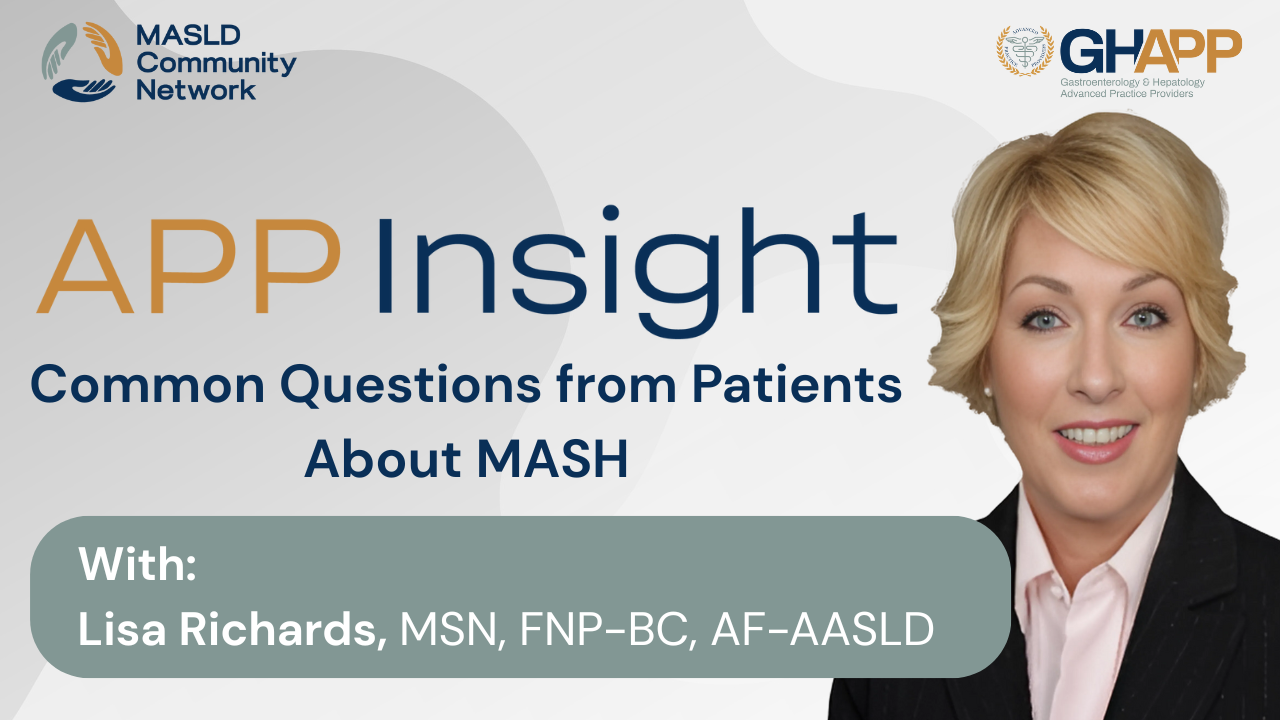
Common Questions From Patients About MASH

In this practical and patient-focused discussion from the GHAPP MASLD/MASH Community Network, we address some of the most frequently asked questions by patients newly diagnosed with MASLD (Metabolic dysfunction-associated steatotic liver disease). Many patients wonder how they can have liver disease if they don’t drink alcohol. This video explains the evolution from NAFLD to MASLD, emphasizing that MASLD is rooted in metabolic risk factors—not alcohol use—and commonly affects individuals with diabetes, obesity, and hypertension. Viewers will also learn about evidence-based lifestyle interventions, including the benefits of a hypocaloric diet, the recommended Mediterranean-style eating pattern, and 150 minutes of weekly physical activity. Finally, we tackle the question “Is MASLD curable?” with empowering guidance on how weight loss and exercise can help reverse liver damage and reduce liver fat. This is a must-watch for clinicians, care teams, and patients seeking clarity and confidence in managing this increasingly common liver disease.
Watch Now
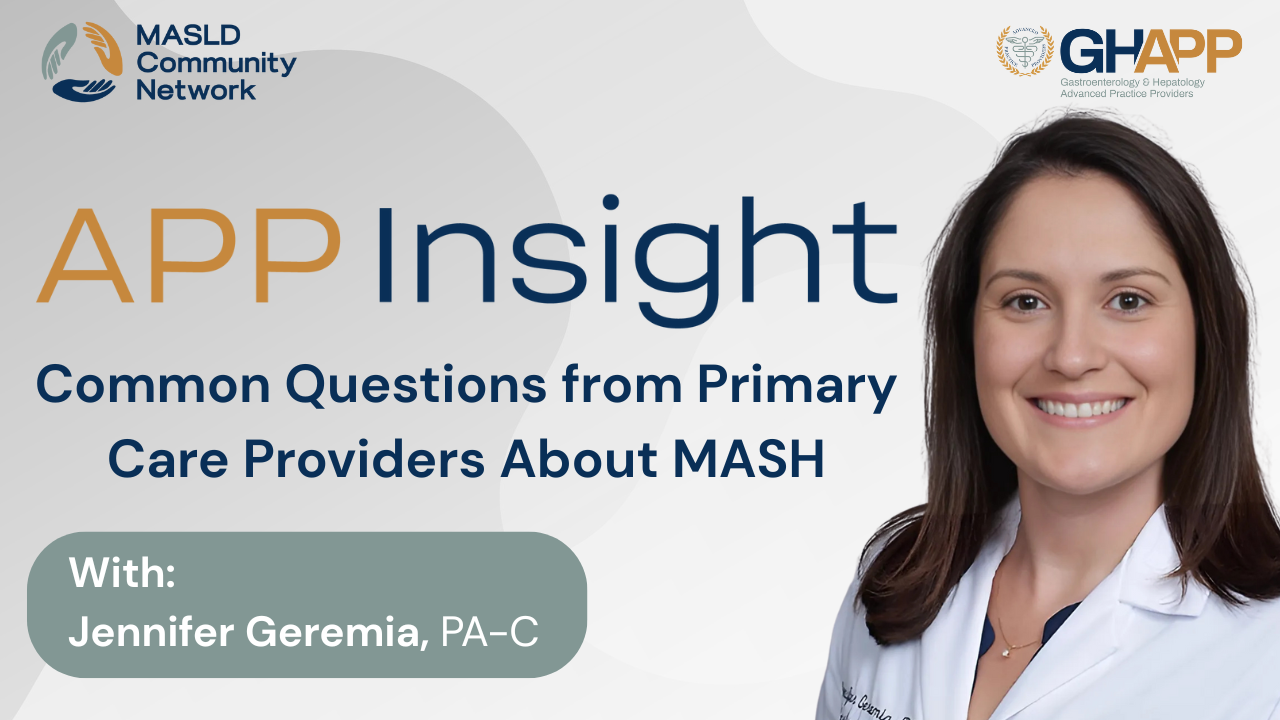
Common Questions From Primary Care Providers About MASH

In this informative session, Jennifer Geremia, PA-C, a seasoned gastroenterology physician assistant in tertiary care Boston, addresses some of the most common questions primary care providers have about identifying and managing patients with fatty liver disease, MASLD (Metabolic dysfunction-associated steatotic liver disease), and MASH (Metabolic-associated steatohepatitis). Jennifer highlights the importance of using FIB-4 as a first-line non-invasive test (NIT) in high-risk patients with diabetes, obesity, or other metabolic conditions—noting how easily this tool can be integrated into routine labs via the EMR. She underscores that the liver is often overlooked in chronic disease management and makes a strong case for routine fibrosis screening alongside cardiovascular and diabetes evaluations. The talk also dives into actionable next steps after FIB-4 testing, including elastography, ELF testing, and referrals to GI when needed. Jennifer closes by discussing realistic lifestyle intervention goals—especially the importance of 7–10% weight loss for meaningful reductions in steatosis and fibrosis risk. This session is a must-watch for PCPs, APPs, and clinicians managing metabolic comorbidities and seeking practical, evidence-based strategies for early MASH detection and management.
Watch Now
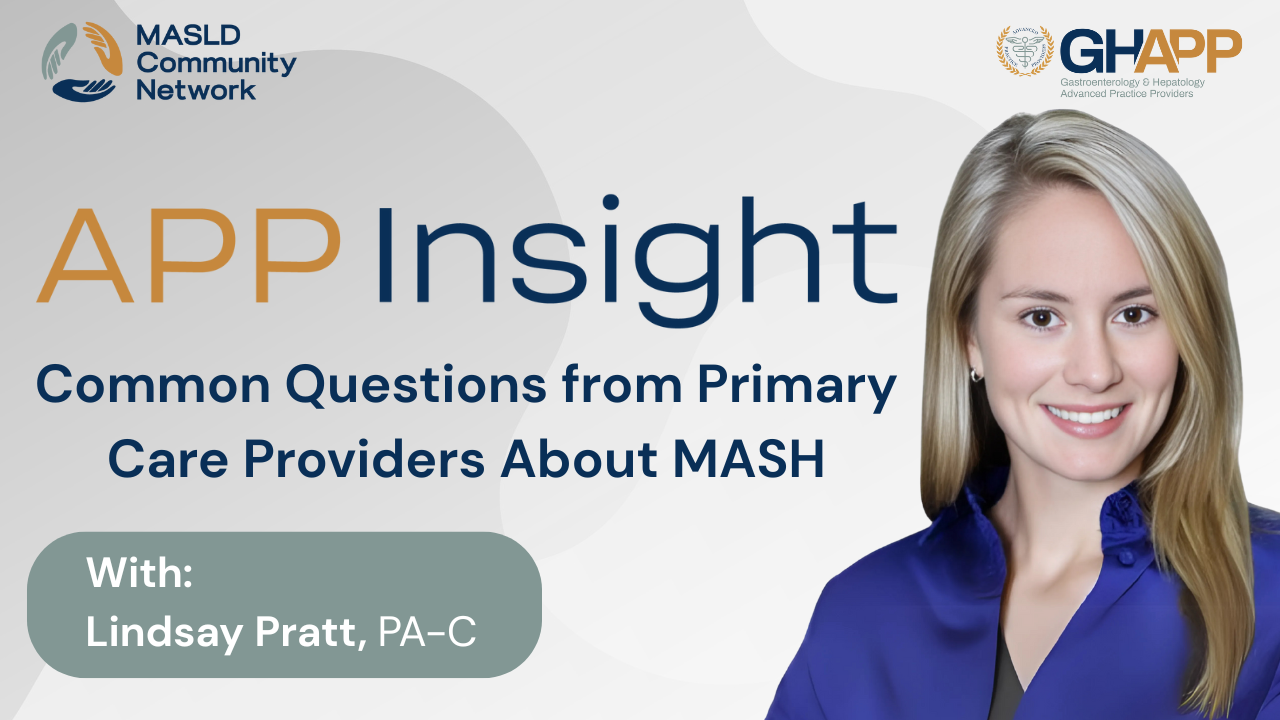
Common Questions From Primary Care Providers About MASH

In this concise and practical discussion, Lindsay Pratt, PA-C from the University of Colorado’s Department of Hepatology and Liver Transplant, shares expert guidance on screening and managing patients with MASLD (Metabolic dysfunction-associated steatotic liver disease) and MASH (Metabolic-associated steatohepatitis). Speaking directly to the common questions she receives from primary care providers, Lindsay outlines when to screen for MASLD/MASH—emphasizing the importance of evaluating patients with elevated liver enzymes, hepatic steatosis on imaging, and cardiometabolic risk factors like diabetes, hypertension, hyperlipidemia, and sleep apnea. She breaks down the utility of FIB-4 as a first-line non-invasive test, when to use FibroScan®, and clears up a common misconception about statin use in liver disease—encouraging providers to continue or initiate statins when indicated. This session is ideal for clinicians managing metabolic syndrome and its liver manifestations and offers simple, evidence-based tools to identify at-risk patients early.
Watch Now

APP Insight: Common Questions from Patients About MASH

In this episode, Jordan Mayberry, MPAS, PA-C, a seasoned hepatology provider at UT Southwestern in Dallas, Texas, addresses some of the most frequently asked questions from patients diagnosed with MASLD (Metabolic Dysfunction–Associated Steatotic Liver Disease) and MASH (Metabolic Dysfunction–Associated Steatohepatitis). With over 12 years of clinical experience, Jordan explains the root causes of MASLD/MASH, including key cardiometabolic risk factors like obesity, diabetes, hypertension, and hyperlipidemia, as well as genetic predispositions—particularly in Hispanic populations. He emphasizes the importance of fibrosis assessment in guiding treatment decisions, explaining that patients with early-stage disease should focus on lifestyle changes, while those with more advanced fibrosis (stages F2–F3) may be candidates for pharmacologic therapy such as resmetirom (Rezdiffra). Jordan also explores how prognosis depends on fibrosis stage and long-term management of comorbidities, making early intervention and risk stratification essential. This episode offers practical insights for clinicians aiming to improve conversations and care strategies for patients living with MASLD or MASH.
Watch Now

Non-Invasive Testing With Lindsay Pratt

In this educational session from the GHAPP MASLD/MASH Community Network, Lindsay Pratt, PA-C from the University of Colorado, guides viewers through the practical application of non-invasive testing (NITs) for assessing fibrosis in patients with MASLD (Metabolic dysfunction-associated steatotic liver disease). Using a real-world case study, she highlights how to interpret FIB-4, ELF score, vibration-controlled transient elastography (VCTE/FibroScan®), and MR elastography (MRE) to stratify patients by risk and guide next steps in management. Lindsay explains the strengths and limitations of each NIT, how lifestyle modifications and cardiometabolic risk factors play a role in disease progression, and how tools like the AGA Clinical Care Pathway can be applied in day-to-day practice. This session is ideal for hepatologists, GI providers, APPs, and primary care professionals working to improve outcomes in patients with fatty liver disease—without relying on liver biopsy.
Watch Now

Non-Invasive Testing With Janet Gripshover

In this in-depth and practical discussion, Janet Gripshover, NP from Cedars-Sinai in Los Angeles, explores the evolving role of non-invasive testing (NITs) in the diagnosis and risk stratification of MASLD (Metabolic dysfunction-associated steatotic liver disease) and MASH (Metabolic dysfunction-associated steatohepatitis). Drawing from real-world experience and a case study involving a 65-year-old patient with multiple cardiometabolic risk factors, she breaks down the latest 2025 approaches to fibrosis assessment—highlighting the use of FIB-4, ELF score, vibration-controlled transient elastography (FibroScan®), and MR elastography. Gryover also emphasizes how combining tests across modalities can improve accuracy and patient care while avoiding the risks of liver biopsy. Learn how liver stiffness, lab values, and clinical history all intersect to guide care and treatment decisions in patients with fatty liver disease. This session is part of the MASLD/MASH Community Network and is ideal for providers, specialists, and anyone interested in the forefront of liver disease management.
Watch Now

APP Insight: Common Questions from Community GI About MASH

In this informative video, Janet Gripshover, DNP, FNP-BC, and nurse manager for the liver transplant program at Cedars-Sinai, answers key questions about managing MASH (Metabolic Dysfunction–Associated Steatohepatitis) and navigating non-invasive testing. She addresses a common clinical challenge—what to do when FIB-4 and FibroScan results are discordant. Janet explains that while non-invasive tests are useful, they're not foolproof, and when results are unclear—especially in patients with significant metabolic risk factors—liver biopsy remains the gold standard for accurate diagnosis. She also shares expert recommendations on dietary changes for patients with fatty liver disease, emphasizing alcohol avoidance, high-protein, low-fat, and lower-carb diets, as well as achievable weight loss goals (around 5% of body weight). Janet highlights when to escalate care beyond lifestyle interventions—typically after 3 to 6 months if there’s no improvement—and discusses options such as pharmacologic therapy or bariatric surgery. This video provides practical, evidence-based guidance for healthcare providers managing the complexities of MASLD and MASH.
Watch Now

Lifestyle Management With Christina Hanson

Join Christina Hanson, NP from South Denver GI, for a practical and in-depth discussion on lifestyle management of MASLD (Metabolic Dysfunction-Associated Steatotic Liver Disease) and MASH (Metabolic Steatohepatitis). In this GHAPP MASLD/MASH Community Network session, Christina walks through the case of Albert, a 65-year-old patient with obesity, diabetes, and abnormal liver findings—representing a common clinical scenario in primary and specialty care. This session highlights how to apply non-invasive fibrosis assessment tools like FIB-4 and FibroScan, interpret metabolic risk factors, and differentiate patients based on fibrosis staging. Christina discusses how cultural dietary habits, access to care, and social determinants of health impact disease management, and emphasizes the importance of personalized counseling, accountability strategies, and gradual, sustainable changes to diet and exercise. The session also reviews the role of Resmetirom, the first FDA-approved treatment for MASH with F2-F3 fibrosis, and outlines guideline-recommended lifestyle interventions including the Mediterranean diet and combined aerobic/resistance exercise. Learn how to identify, stage, and manage patients with MASLD and MASH in a way that supports long-term adherence and improves liver-related outcomes. Educational support provided by Madrigal Pharmaceuticals.
Watch Now

APP Insight: Common Questions from Patients About MASH

In this insightful video, Patrick Horne, NP, from the University of Florida, addresses some of the most frequently asked questions from patients diagnosed with MASLD (Metabolic Dysfunction–Associated Steatotic Liver Disease) and MASH (Metabolic Dysfunction–Associated Steatohepatitis). Drawing from his clinical experience, he answers common concerns such as: “How did I get fatty liver if I don’t drink alcohol?”, clarifying that alcohol is not a necessary factor in developing these conditions—rather, metabolic risk factors like obesity, diabetes, hypertension, and genetic predisposition play a significant role. Patrick also dives into lifestyle recommendations, including the importance of adopting a mediterranean diet, engaging in regular physical activity, and setting realistic weight loss goals. Additionally, he tackles the nuanced question of alcohol consumption in patients with MASLD/MASH, emphasizing individualized care depending on the stage of liver disease. This session is a must-watch for both patients and providers seeking practical, evidence-based guidance on managing metabolic liver disease.
Watch Now

MASLD Basics With Summer Collier

Join Summer Collier, NP from UC San Diego Health, for an essential overview of MASLD (Metabolic Dysfunction-Associated Steatotic Liver Disease) in this GHAPP MASLD Community Network session. Designed for clinicians and healthcare professionals, this case-based talk covers the evolving nomenclature shift from NAFLD/NASH to MASLD/MASH, including key definitions, diagnostic criteria, and practical tools for identifying and managing patients with steatotic liver disease. Summer walks through foundational concepts like the role of hepatic steatosis, cardio-metabolic risk factors, and the importance of excluding significant alcohol use to establish a MASLD diagnosis. She also provides clinical insights into non-invasive fibrosis staging using FIB-4, FibroScan, elastography, and blood-based tests, as well as how to differentiate patients who may require hepatology referral or biopsy. Emphasizing the importance of early detection and risk stratification in primary care, this session highlights how fibrosis stage impacts prognosis, treatment planning, and long-term liver-related outcomes. For more educational sessions and MASLD tools — visit the GHAPP MASLD Community Network.
Watch Now

APP Insight: Misconceptions About Liver Health

In this video, Christina Hanson, FNP-C, from South Denver Gastroenterology, dispels common myths around liver health and highlights a critical shift in how we identify and manage fatty liver disease. With the updated terminology from NAFLD/NASH to MASLD/MASH—Metabolic Dysfunction–Associated Steatotic Liver Disease—Christina explains how the new name more accurately reflects the underlying cardiometabolic drivers of the condition, such as obesity, type 2 diabetes, hypertension, and dyslipidemia. She emphasizes that liver enzyme abnormalities or incidental imaging findings should no longer be the only triggers for evaluation. Instead, clinicians—especially in primary care and endocrinology—should proactively screen high-risk patients using non-invasive tools like FIB-4 to assess for liver fibrosis. With over 50% of patients with type 2 diabetes and up to 90% of those with morbid obesity at risk for coexisting fatty liver, early identification and triage are vital to improving outcomes. This is a must-watch for healthcare providers seeking practical, guideline-driven strategies for detecting MASLD and MASH in everyday clinical practice.
Watch Now

How is MASH severity staged? What would an ideal MASH NIT algorithm look like?

Thank you to Madrigal for sponsoring this FAQ Video Module. In this GHAPP FAQ Video Module, Jonathan Yeh, a physician assistant at the Center for Liver Disease and Transplantation at Columbia University Irving Medical Center, discusses advancements in diagnosing and staging metabolic dysfunction-associated steatohepatitis (MASH). He explains the transition from traditional liver biopsy to non-invasive testing methods such as FibroScan and the Enhanced Liver Fibrosis (ELF) test for assessing fibrosis stages. Jonathan highlights the use of these methods, in combination with blood tests, to provide reliable staging of fibrosis in patients with MASH. For more information, visit the GHAPP website or ACE app.
Watch Now

APP Insights: Common Questions from Community GI About MASH

In this video, Lindsay Yoder, PA-C, a hepatology expert at Indiana University in Indianapolis, addresses some of the most common questions general GI providers have about diagnosing and managing MASLD (Metabolic Dysfunction–Associated Steatotic Liver Disease) and MASH (Metabolic Dysfunction–Associated Steatohepatitis). She explains the nuance of interpreting positive autoantibodies like ANA or ASMA, emphasizing that up to 30% of patients with MASLD/MASH may have non-specific reactive antibodies that are not clinically significant for autoimmune hepatitis. Lindsay walks viewers through how to evaluate serologic workups in context—considering IGG levels, ALT trends, and symptoms like fatigue or pruritus—and when to consider liver biopsy. She also shares expert guidance on when to refer patients to hepatology, particularly those with advancing fibrosis (F2-F4) or cirrhosis. Finally, she clarifies how to distinguish between MASLD and alcohol-associated liver disease (ALD), using daily alcohol consumption levels alongside cardiometabolic risk factors to help determine whether a patient falls into a MASLD, ALD, or mixed-etiology category like MetALD. This informative session is essential viewing for clinicians navigating the evolving landscape of metabolic liver disease.
Watch Now

APP Insight: Common Questions from Patients About MASH

In this video, Jonathan Yeh, PA, answers three of the most frequently asked questions about MASH—Metabolic Dysfunction–Associated Steatohepatitis—and offers practical advice for understanding and managing this progressive form of fatty liver disease. He begins by explaining what MASH is: an inflammatory, more advanced stage of MASLD (Metabolic Dysfunction–Associated Steatotic Liver Disease), driven by abnormal fat accumulation in the liver due to impaired fat transport. Jonathan then breaks down the treatment approach, emphasizing the importance of lifestyle modification—particularly diet and exercise. He highlights the benefits of a green Mediterranean diet, regular physical activity, and sustainable weight loss, which can improve or even reverse MASH in many patients. For individuals with more advanced fibrosis, pharmacologic treatment with resmetirom (Rezdiffra) may be indicated. This concise FAQ offers helpful guidance for patients and providers alike on tackling MASH with evidence-based strategies.
Watch Now

APP Insight: Misconceptions About Liver Health

In this video, Scott Springer, PA-C, from Erie County Medical Center in Buffalo, NY, addresses one of the most common misconceptions in liver health—trusting over-the-counter supplements and detox products to improve liver function. Drawing from his experience in both hepatology and addiction medicine, Scott emphasizes that many non-prescribed products marketed for liver support are not only ineffective but can actually cause liver harm. He cautions against relying on unregulated supplements and urges patients to consult medical professionals before taking anything for liver health. One surprising and evidence-based recommendation he makes: drink coffee. Filtered coffee, in particular, has been shown to support liver health and may reduce the risk of liver disease progression. Scott recommends two to three cups per day, without added sugar or excess dairy—especially for patients with MASLD or MASH. This video offers practical, research-backed advice for patients and providers alike, highlighting what truly helps (and what may harm) the liver.
Watch Now

Lifestyle Management With Robin Soto

Join Robin Soto, NP from UC San Diego Health, for a practical and case-based discussion on lifestyle management in patients with MASLD and MASH (Metabolic dysfunction-associated steatotic liver disease and steatohepatitis). In this presentation, Robin walks through the diagnosis and management of a representative patient case, highlighting how to assess fibrosis risk using non-invasive tools like FIB-4 and FibroScan, and emphasizing the critical role of lifestyle intervention. Learn how diet, exercise, and behavioral counseling can slow or reverse liver disease progression—especially in patients with cardiometabolic risk factors such as type 2 diabetes, obesity, and hyperlipidemia. Robin also addresses real-world barriers to dietary change, including cultural preferences, food accessibility, and socioeconomic challenges, while offering practical strategies for behavior change and patient engagement. This session is part of the GHAPP MASLD/MASH Community Network and includes educational resources on MASH and promotional information about Rezdiffra, a new treatment option for patients with advanced disease. Whether you're a hepatology provider or managing liver disease in primary care, this presentation offers essential, real-world guidance to support your clinical decision-making.
Watch Now

APP Insight: Common Questions from Community GI About MASH

In this episode, HoChong Gilles, DNP, FNP-BC, a seasoned hepatology expert and Clinical Program Director at the Central Virginia VA Health Care System, addresses a frequently asked question from primary care and community GI providers: How do you risk stratify patients without access to a FibroScan? Drawing on over 25 years of clinical experience, HoChong outlines practical strategies for assessing liver fibrosis using the FIB-4 score—a simple calculation based on patient age, ALT, AST, and platelet count. She also discusses how tools like the Enhanced Liver Fibrosis (ELF) test, available through Quest or Labcorp, can serve as valuable alternatives in the absence of elastography. Whether you're managing incidental hepatic steatosis or evaluating elevated liver enzymes, this episode offers step-by-step guidance for using non-invasive biomarkers to stratify liver disease risk and guide referrals effectively. Perfect for clinicians in primary care, GI, and hepatology seeking practical, accessible tools for early liver disease assessment.
Watch Now

Lifestyle Management With Anthony Derencius

Join Anthony Derencius, PA-C, at Pinnacle Clinical Research, for an in-depth, case-based discussion on the role of lifestyle management in MASH and MASLD. In this educational session from the GHAPP MASLD Community Network, Anthony walks through the real-world case of a 65-year-old patient with obesity, diabetes, and suspected metabolic liver disease, highlighting how to interpret non-invasive diagnostics like FIB-4 scores and transient elastography. He explains the clinical significance of metabolic risk factors, genetic predispositions (such as PNPLA3), and how personalized approaches to nutrition and exercise can alter the progression of fatty liver disease. With evidence-based insights on the Mediterranean diet, aerobic vs resistance training, and behavior change strategies, this video offers frontline strategies to support patients in reversing or slowing fibrosis. Watch to learn how providers can combine patient education, lifestyle interventions, and emerging pharmacotherapy to manage MASLD and MASH more effectively. Educational support provided by Madrigal Pharmaceuticals. For more disease state content, visit the GHAPP MASLD Community Network.
Watch Now

APP Insight: Misconceptions About Liver Health

In this video, Anthony Derencius, PA-C at Pinnacle Clinical Research, clears up some of the most common misconceptions about liver health—offering valuable insights for both patients and healthcare providers. With extensive experience in hepatology, Anthony emphasizes that liver disease is often silent and asymptomatic, meaning many individuals may feel completely fine while living with a significant liver issue. He cautions against relying on a single lab result or imaging test to determine liver status, especially when assessing for conditions like cirrhosis, and stresses the importance of confirming findings through multiple diagnostic tools over time. Anthony also highlights the need for proactive screening, particularly in patients with risk factors such as obesity, diabetes, or a family history of liver disease. Early detection is key, and he encourages patients to advocate for their liver health by seeking evaluation—even if their provider hasn’t suggested it. This is a must-watch for anyone aiming to better understand the complexities of liver disease and the importance of early and accurate diagnosis.
Watch Now

APP Insight: Misconceptions About Liver Health

In this video, Kelly Smeester, PA-C from South Denver Gastroenterology, addresses some of the most common and harmful misconceptions about liver health. One major myth she tackles is the belief that liver disease only affects those who drink excessive amounts of alcohol. Kelly explains that liver disease has many causes—including autoimmune conditions, viral infections, and metabolic dysfunction—meaning even individuals who don’t drink at all may still be at risk. She emphasizes the dangers of relying on unregulated “liver detox” supplements, clarifying that the liver is a natural detox organ and doesn’t require external cleanses, which may actually do more harm than good. Kelly also highlights how liver disease can be entirely asymptomatic, particularly in patients with conditions like type 2 diabetes, obesity, hypertension, and high cholesterol. Finally, she reinforces that cirrhosis is not solely alcohol-related and can result from steatotic liver disease, making regular liver evaluations and screenings crucial for early detection and management. This video is an essential resource for patients and providers aiming to better understand liver health beyond outdated myths.
Watch Now

Clinical Deep Dive: Unlocking the Treatment Potential of Rezdiffra

This educational discussion dives into Rezdiffra, the first and only FDA-approved therapy for non-cirrhotic metabolic-associated steatohepatitis (MASH) with moderate to advanced fibrosis. The talk provides a clinical deep dive into the progression of MASH and fibrosis, highlighting the risks of untreated disease and the importance of early intervention. A key focus is the thyroid hormone receptor beta mechanism, explaining how Rezdiffra directly targets liver-specific pathways to reduce hepatic fat accumulation and fibrosis. Additionally, the discussion covers the rigorous FDA approval process and dual efficacy endpoints, detailing how Rezdiffra achieved significant fibrosis improvement and steatohepatitis resolution in the MAESTRO-NASH trial. The session also provides practical insights into patient access, prescribing considerations, and managing common side effects. With over 2,000 patients studied, Rezdiffra has demonstrated a strong safety profile and offers a once-daily oral treatment option that represents a major advancement in MASH management. This discussion is essential for gastroenterologists, hepatologists, and endocrinologists managing patients with MASH, as well as primary care providers and cardiologists who play a role in identifying at-risk individuals. If you are a healthcare professional looking to stay updated on the latest MASH research and treatment strategies, this session provides the insights you need.
Watch Now

Lifestyle Management With Michelle Barnett

Join Michelle Barnett, PA-C, for an in-depth clinical case presentation as part of the GHAPP MASLD Community Network. With over 25 years of experience in GI and hepatology, Michelle walks through the real-world management of Albert, a 65-year-old patient newly diagnosed with MASLD (Metabolic Dysfunction-Associated Steatotic Liver Disease). In this session, she outlines key diagnostic criteria, the role of non-invasive tests (NITs) like FIB-4 and FibroScan, and how to risk-stratify patients using updated care pathways. Learn how to differentiate low-, moderate-, and high-risk cases and when to refer for hepatology evaluation or consider biopsy. Michelle also explores the clinical role of Resmetirom—the first FDA-approved medication for patients with MASH and F2-F3 fibrosis—and emphasizes the importance of sustained lifestyle modification, dietary change, and exercise in liver disease management. This expert discussion includes cultural and socioeconomic considerations, adherence strategies, and patient tools like the Exercise and Diet Adherence Scale. Visit the GHAPP MASLD Community Network for more resources, disease-state education, and updates on the evolving care landscape. Educational content supported by Madrigal Pharmaceuticals.
Watch Now

What is Resmetirom and how does it work to treat MASH?

Thank you to Madrigal for sponsoring the Medication Review Video Module. In this GHAPP Medication Review video, Robin Soto, a board-certified nurse practitioner at UC San Diego Health Hepatology, explains the mechanism of action of Resmetirom, the first and only FDA-approved drug for the treatment of MASH in adults with mild to moderate fibrosis (F2-F3). Robin describes how Resmetirom, a liver-directed, thyroid hormone receptor beta agonist, targets liver fat accumulation, promoting fatty acid oxidation and improving cholesterol metabolism. She highlights its anti-inflammatory effects and ability to reduce liver fibrosis by selectively activating receptors in the liver, while minimizing systemic side effects. For more information, visit the GHAPP website and ACE app.
Watch Now

What is the clinical profile of Resmetirom, including dosing schedules?

Thank you to Madrigal for sponsoring this Medication Review Video Module! In this GHAPP Medication Review Video Module, nurse practitioner Whitney Steinmetz discusses the clinical profile of Resmetirom, a thyroid hormone receptor beta agonist indicated for adults with metabolic-associated steatohepatitis (MASH) and moderate to advanced liver fibrosis. Whitney explores the mechanism of action, dosage recommendations, and the dual primary endpoint success of Resmetirom in clinical trials. She highlights key considerations, including drug interactions and common side effects such as nausea and diarrhea, and how they are generally well-tolerated over time. Learn more about Resmetirom's impact on liver health and patient care by visiting the GHAPP website or app.
Watch Now

APP Insight: Common Questions from Primary Care Providers About MASH

In this informative video, Michelle Barnett, PA-C, a hepatology expert based in Colorado Springs, answers frequently asked questions about elevated liver enzymes in the context of MASH (Metabolic Dysfunction–Associated Steatohepatitis) and MASLD (Metabolic Dysfunction–Associated Steatotic Liver Disease). She breaks down how to interpret common liver enzyme patterns—such as ALT greater than AST versus AST greater than ALT—and what these patterns may indicate, from MASH to alcohol-related liver disease and other potential causes like autoimmune hepatitis or drug-induced liver injury. Michelle outlines how to perform a thorough workup, including patient history, medication review, and physical exam findings, and emphasizes the importance of using tools like FIB-4 and abdominal ultrasound to assess for fibrosis and portal hypertension. The discussion also covers the clinical value of GGT, alkaline phosphatase, bilirubin, albumin, and platelets in evaluating liver function. Michelle shares practical guidance on when to refer patients to hepatology and how to monitor liver enzymes over time, particularly in those undergoing lifestyle changes or pharmacologic treatment. This comprehensive Q&A is an essential resource for providers managing patients with suspected or confirmed metabolic liver disease.
Watch Now

Updates On Approved Treatments for MASH

Join Robin Soto, NP, for an engaging session at the MASH Boot Camp during the 2024 GHAPP National Conference as she provides updates on improved treatments for metabolic-associated steatohepatitis (MASH). Robin dives into the mechanisms of action, key clinical data, and prescribing guidelines for current therapies, including groundbreaking updates from the MAESTRO-NASH study. She also explores the game-changing potential of FDA-approved therapies like Resmetirom, offering insights into its efficacy, safety, and impact on patients with at-risk fibrosis.
Watch Now

Defining, Diagnosing, & Treating MASH

Join Jordan Mayberry, PA-C, for an insightful video from the MASH Boot Camp at the 2024 GHAPP National Conference. Jordan covers the latest advancements in diagnosing metabolic-associated steatohepatitis (MASH). She provides a comprehensive overview of the evolution of MASH terminology, the diagnostic criteria, and the critical role of patient history in identifying steatosis. Discover how metabolic risk factors, genetic predispositions, and alcohol consumption influence disease progression. Jordan also explores the importance of non-invasive diagnostic tools, when to consider liver biopsies, and how to differentiate MASH from other liver conditions. Perfect for healthcare professionals seeking to refine their approach to liver disease management.
Watch Now

Management of Life Style Modification

This video focuses on the comprehensive management of patients with metabolic-associated steatohepatitis (MASH), emphasizing lifestyle modifications, dietary adjustments, and exercise strategies. Key topics include the importance of addressing risk factors like diet, exercise habits, and alcohol intake, as well as referrals to medically supervised weight loss clinics or bariatric surgery for advanced cases. The speaker highlights the benefits of the Mediterranean diet, intermittent fasting, and avoiding ultra-processed foods while discussing the role of resistance training to combat sarcopenia and maintain muscle mass. Practical advice and tailored recommendations ensure a holistic approach to managing MASH and improving patient outcomes.
Watch Now

Third Step of Life Style Management

This video provides a comprehensive overview of emerging pharmacologic treatments for metabolic-associated steatohepatitis (MASH) and their tailored applications based on patient profiles. Topics include FDA-approved therapies, drugs in advanced clinical trials (such as semaglutide and lanifibranor), and the potential for combination treatments targeting both steatohepatitis and fibrosis. The speaker emphasizes the importance of patient-specific approaches considering metabolic profiles, obesity, and diabetes status, alongside lifestyle interventions. Additionally, the video discusses the evolving interdisciplinary care model and highlights the exciting progress in non-invasive testing and treatment advancements for F2-F3 fibrosis.
Watch Now

Approved Medication for MASH/NASH

This video provides detailed guidance on selecting and monitoring patients for emerging therapies targeting advanced fibrosis (F2-F3) in NASH. Key topics include contraindications for patients with cirrhosis, considerations for concomitant medications, and dose adjustments for statins. The video outlines ideal candidates based on specific thresholds for VCTE, MRE, ELF scores, and other non-invasive tests while emphasizing the importance of ruling out portal hypertension and other liver diseases. It also reviews a stepwise monitoring approach, focusing on tolerability at three months and efficacy assessments at six and twelve months, with an emphasis on histologic and non-invasive test improvements.
Watch Now

Types of Diet for the Treatment of MASLD

This video explores comprehensive strategies for managing metabolic-associated steatohepatitis (MASH), focusing on fibrosis risk stratification, lifestyle modifications, and pharmacologic interventions. Learn about dietary recommendations like the Mediterranean diet, exercise guidelines emphasizing resistance training, and the role of intermittent fasting and processed food avoidance. The video also highlights weight loss targets, diabetes management, and emerging therapies such as GLP-1 receptor agonists and bariatric surgery, all aimed at improving liver health and patient outcomes.
Watch Now

NITs to Identify High Risk MASH Patients

Explore advancements in non-invasive diagnostics and risk stratification for liver fibrosis and MASH. This video highlights tools like FIB-4, transient elastography, and innovative scoring systems (e.g., FAST and Agile) to identify and predict outcomes for high-risk patients. Learn about serum biomarkers, updated guidelines, and the role of lifestyle interventions alongside targeted therapies for managing metabolic risks and advancing care in hepatology.
Watch Now

A Phase 3, Randomized, Controlled Trial of Resmetirom in MASH with Liver Fibrosis

Thank you to Madrigal for sponsoring this Journal Club Video Module! In this GHAPP Journal Club review, Lisa Richards, a board-certified family nurse practitioner specializing in hepatology at UC San Diego Health, presents pivotal research from a February 2024 New England Journal of Medicine publication. The phase 3 randomized controlled trial evaluated the efficacy of Resmetirom, the first FDA-approved therapy for non-alcoholic steatohepatitis (NASH) with moderate to advanced liver fibrosis. Lisa discusses key findings from the study, including improvements in liver fibrosis and NASH resolution in patients treated with Resmetirom compared to placebo. Join her for an in-depth look at this groundbreaking therapy and its impact on patient care.
Watch Now
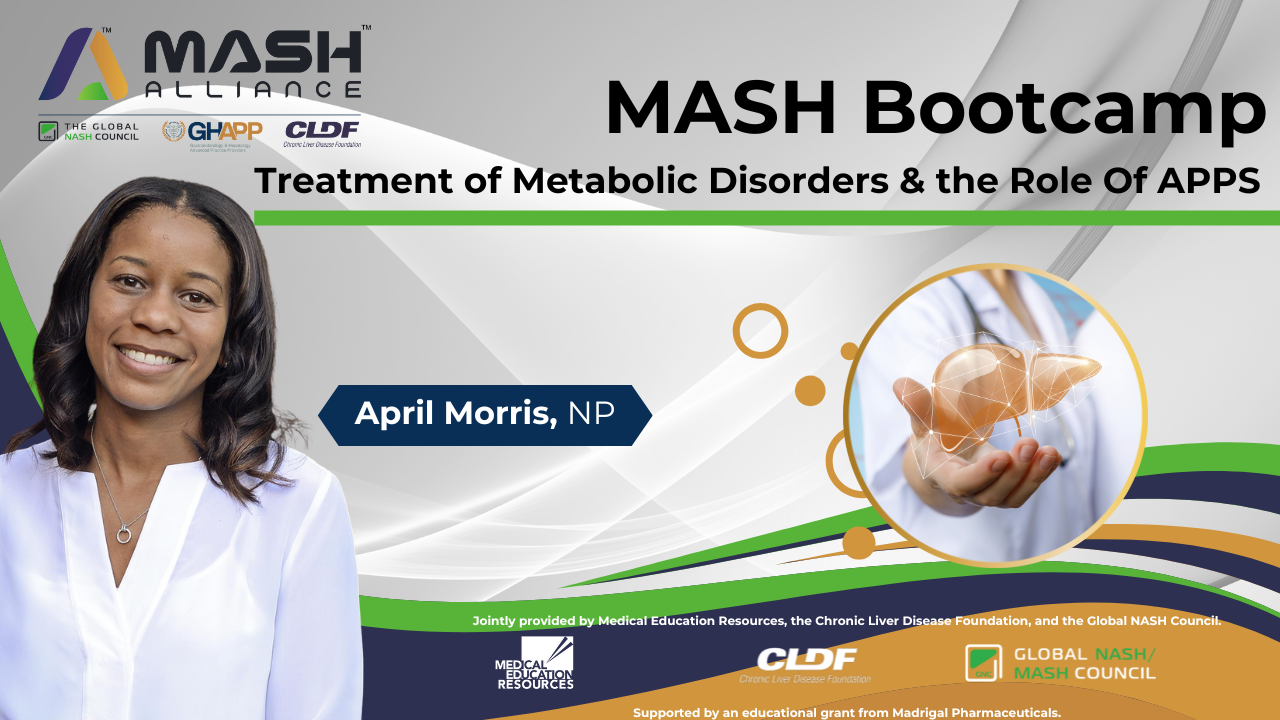
Treatment of Metabolic Disorders and the Role of APPs in MASH

In this video, April Morris, NP, a specialist in hepatology and endocrinology, discusses the comprehensive management of metabolic syndrome and the critical role of advanced practice providers (APPs) in optimizing patient care. With a multidisciplinary approach, she highlights the importance of weight management, medication selection, and addressing comorbidities such as hypertension, hyperlipidemia, and diabetes to improve metabolic-associated steatohepatitis (MASH) and overall health outcomes. April explores various weight loss medications, including GLP-1 receptor agonists and older alternatives, while emphasizing the need for personalized treatment plans that consider insurance coverage and patient history. She also discusses obesogenic medications that contribute to weight gain and suggests safer alternatives that are weight-neutral or promote weight loss. Managing comorbidities is another key focus, as she explains the importance of blood pressure, cholesterol, and diabetes control in reducing cardiovascular risks. Additionally, she stresses the impact of lifestyle modifications, including diet, exercise, and behavioral interventions, for long-term success. Throughout the discussion, April provides clinical insights into medication-induced weight gain, the barriers to accessing newer treatments, and why collaborative care across specialties, including primary care, endocrinology, hepatology, and bariatric surgery, is essential for effective disease management. For more expert insights, visit RhAPP.org and explore the RhAPP ACE 2.0 App for the latest digital education in metabolic and rheumatologic care.
Watch Now

MASH Bootcamp Q&A

In this interactive Q&A session, a panel of liver disease experts discusses key challenges in diagnosing and treating metabolic dysfunction-associated steatohepatitis (MASH) using non-invasive testing and the latest therapeutic advancements. The panel explores the role of FibroScan, ELF scores, and cardiometabolic risk factors in diagnosing fibrosis, especially in patients with limited access to MRI or VCTE-based assessments. They also discuss how serologic testing can be a viable alternative in resource-limited settings and when a liver biopsy may not be necessary for diagnosis. The discussion highlights the FDA approval criteria for Resmetirom, its limitations in F4 patients, and practical strategies for determining treatment eligibility. The experts address real-world challenges, including diagnosing MASH in rural areas, evaluating confounding factors in fibrosis assessment, and ensuring comprehensive liver disease workups to rule out autoimmune conditions.
Watch Now

Lifestyle Modifications for Patients With MASH

In this engaging presentation, Jonathan Yeh, PA, from the Center for Liver Disease and Transplantation at Columbia University, explores the critical role of lifestyle modifications in managing metabolic dysfunction-associated steatohepatitis (MASH). He breaks down the pathogenesis of MASH, explaining how obesity, diabetes, and metabolic dysfunction drive disease progression from steatosis to fibrosis and cirrhosis, and why weight loss and exercise are essential for reversing liver damage. Jonathan highlights the impact of dietary interventions, including the Mediterranean diet, low-carb approaches, and ketogenesis, while emphasizing the importance of calorie restriction over simply eliminating certain food groups. He also discusses the role of exercise, comparing the effectiveness of aerobic training, resistance training, and high-intensity interval training (HIIT) for improving liver health. Surprisingly, research suggests that resistance training may be just as beneficial as aerobic exercise while being more accessible to patients with physical limitations. The discussion also touches on the latest weight loss treatments, including GLP-1 receptor agonists like semaglutide and tirzepatide, which are rapidly transforming obesity management. However, Jonathan underscores that medications alone are not a solution—sustainable lifestyle changes remain the foundation of MASH treatment.
Watch Now

Identifying & Diagnosing MASH Patients with Non-Invasive Tests

In this informative session, Lisa Richards, NP, a hepatology expert from UC San Diego Healthcare, explores how non-invasive tests (NITs) can effectively diagnose metabolic dysfunction-associated steatohepatitis (MASH) and fibrosis without the need for a liver biopsy. She discusses the role of imaging and blood-based biomarkers, such as FibroScan, MRE, ELF, and FIB-4, in identifying patients with stage 2 or higher liver fibrosis and highlights their clinical applications in real-world settings. Lisa walks through a detailed case study, demonstrating how to interpret non-invasive test results, assess risk stratification, and make confident diagnostic decisions using combined NITs like FAST, MEFIB, and MAST scores. She also addresses key limitations of FibroScan and MRI elastography, including BMI constraints, insurance coverage challenges, and patient-specific factors like claustrophobia. Additionally, Lisa introduces clinical care pathways from leading hepatology organizations, explaining how primary care providers and specialists can collaborate to monitor and manage at-risk MASH patients. She emphasizes that, with modern non-invasive tools, biopsies are no longer necessary for diagnosing most MASH patients, enabling earlier intervention and improved patient outcomes.
Watch Now

Podcast: Discordant NITs, the Gray Zone

In this episode, Gabriella McCarty, NP at Northshore Gastroenterology in Cleveland, Ohio, shares her deep clinical insights on the evolving landscape of MASLD (Metabolic Dysfunction–Associated Steatotic Liver Disease) and MASH (Metabolic Dysfunction–Associated Steatohepatitis). With over 26 years of experience in private practice, Gabriella explains that the majority of fatty liver cases she encounters are found incidentally—often during evaluations for unrelated GI issues like GERD or routine colon screenings. She discusses the updated nomenclature from NAFLD to MASLD and outlines the cardiometabolic risk factors that inform diagnosis, such as obesity, diabetes, hypertension, and dyslipidemia. Gabriella emphasizes the importance of non-invasive assessments like FibroScan, FIB-4, ELF testing, and, in select cases, liver biopsy or MR elastography for accurate fibrosis staging. She also highlights the challenges of discordant test results and shares practical strategies for follow-up and monitoring. With a strong focus on lifestyle modification—promoting a Mediterranean diet, targeted weight loss, regular exercise, and alcohol avoidance—this episode provides essential education for providers managing patients with fatty liver disease, even when it's not the primary reason for the visit.
Watch Now
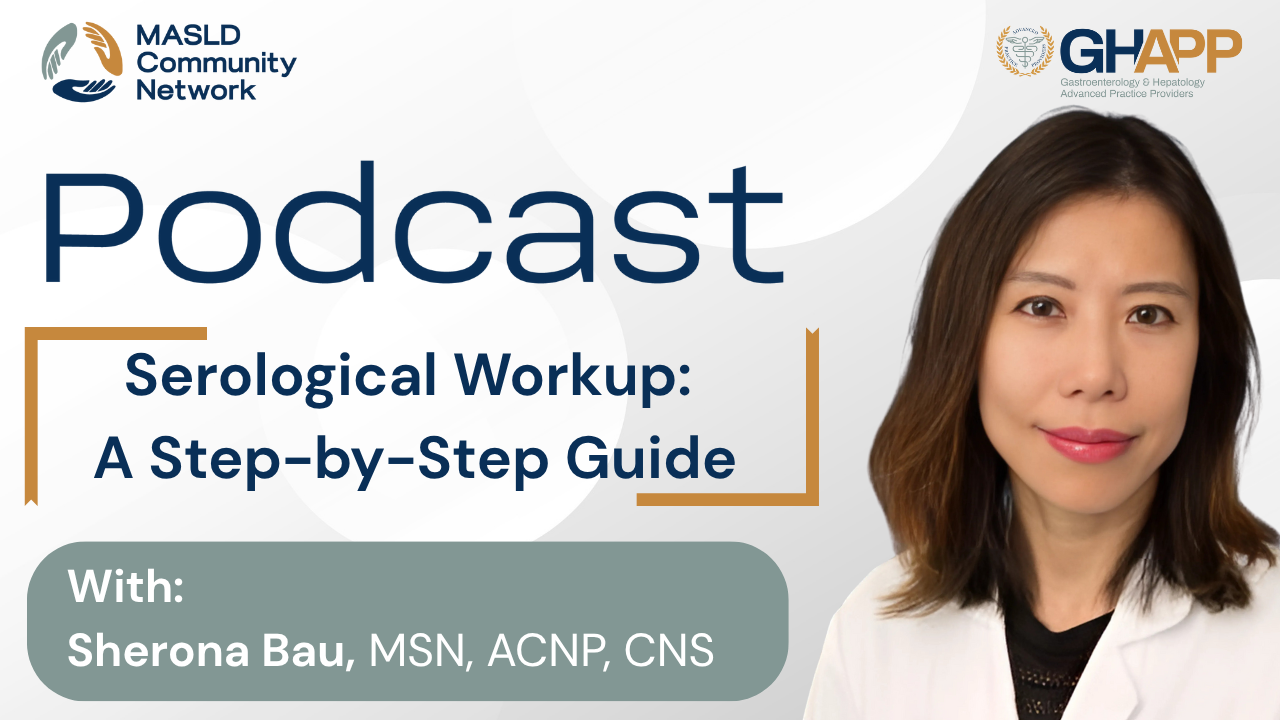
Serological Workup: A Step-by-Step Guide

In this comprehensive video, Sherona Bau, NP from UCLA, breaks down the essential hepatology workup for patients with MASLD (formerly NAFLD) and MASH, offering guidance for both primary care providers and GI/hepatology specialists. Drawing from her extensive clinical experience, she outlines a systematic approach to evaluating abnormal liver ultrasound findings—starting with critical labs to rule out chronic liver conditions like hepatitis B, hepatitis C, autoimmune hepatitis, PBC, and hereditary hemochromatosis. Sherona discusses the importance of ordering ANA, AMA, ferritin, serologies, and even specialized labs like the phosphatidylethanol (PEth) test to uncover alcohol-related liver disease that may be overlooked. She emphasizes the need to screen for cardiometabolic risk factors including type 2 diabetes and dyslipidemia and highlights non-invasive tests such as FibroScan and FIB-4 to help identify patients at risk of advanced fibrosis who may benefit from specialist referral. Most importantly, Sherona addresses the fears many patients face around liver disease progression and life expectancy, encouraging early intervention and coordinated care to improve long-term outcomes. This video is a must-watch for any clinician managing steatotic liver disease.
Watch Now
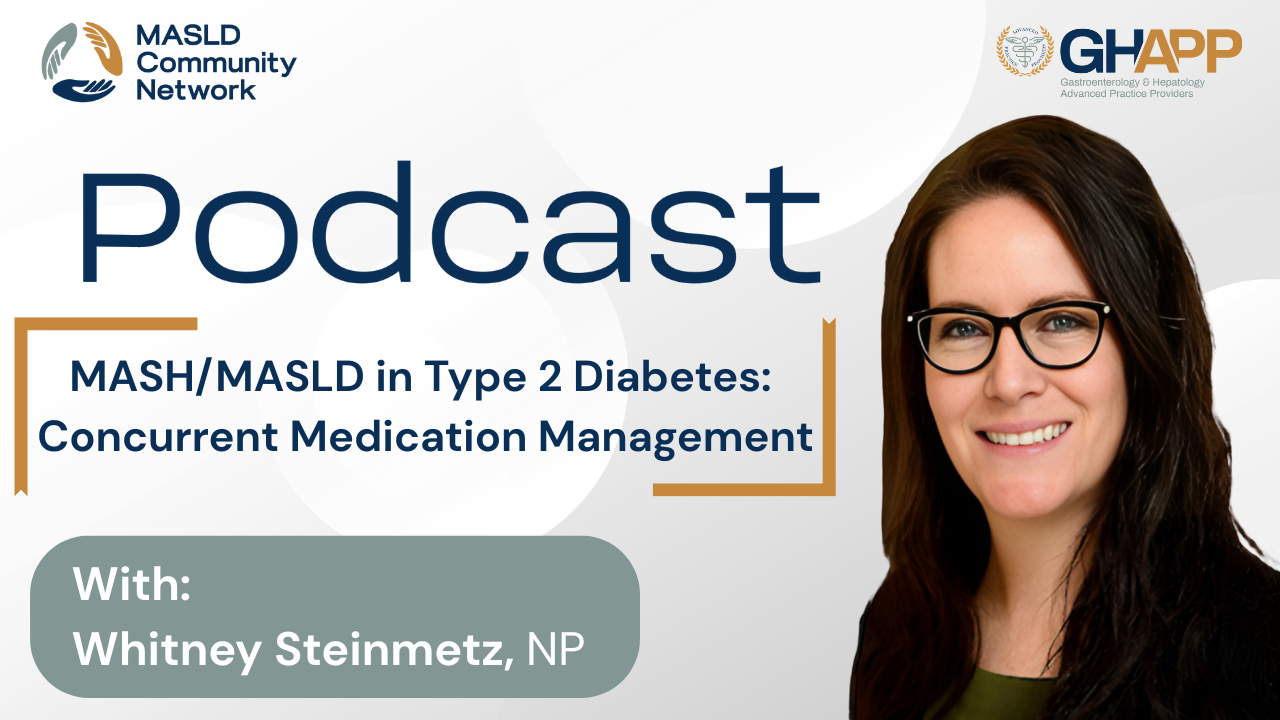
MASH/MASLD in Type 2 Diabetes: Concurrent Medication Management

In this informative episode, Whitney Steinmetz, NP from Presbyterian Medical Group in Albuquerque, NM, explores how to optimize medication strategies for patients with type 2 diabetes who are also living with MASLD and MASH. She discusses why individuals with type 2 diabetes are at significantly higher risk for developing advanced liver fibrosis—highlighting the overlapping metabolic, inflammatory, and insulin-resistant pathways that accelerate liver damage. Whitney breaks down how commonly prescribed diabetes medications—like GLP-1 receptor agonists, SGLT2 inhibitors, TZDs, and dual/triple incretins—impact liver fat, inflammation, and fibrosis progression. She offers practical guidance on selecting therapies that balance glycemic control with hepatic benefits while minimizing polypharmacy. Learn which medications may offer dual cardiometabolic and hepatic advantages, and which should be avoided or used with caution in patients with cirrhosis or advanced fibrosis. Tune in for real-world insights into how advanced practice providers can take ownership of MASH management in diabetes care.
Watch Now
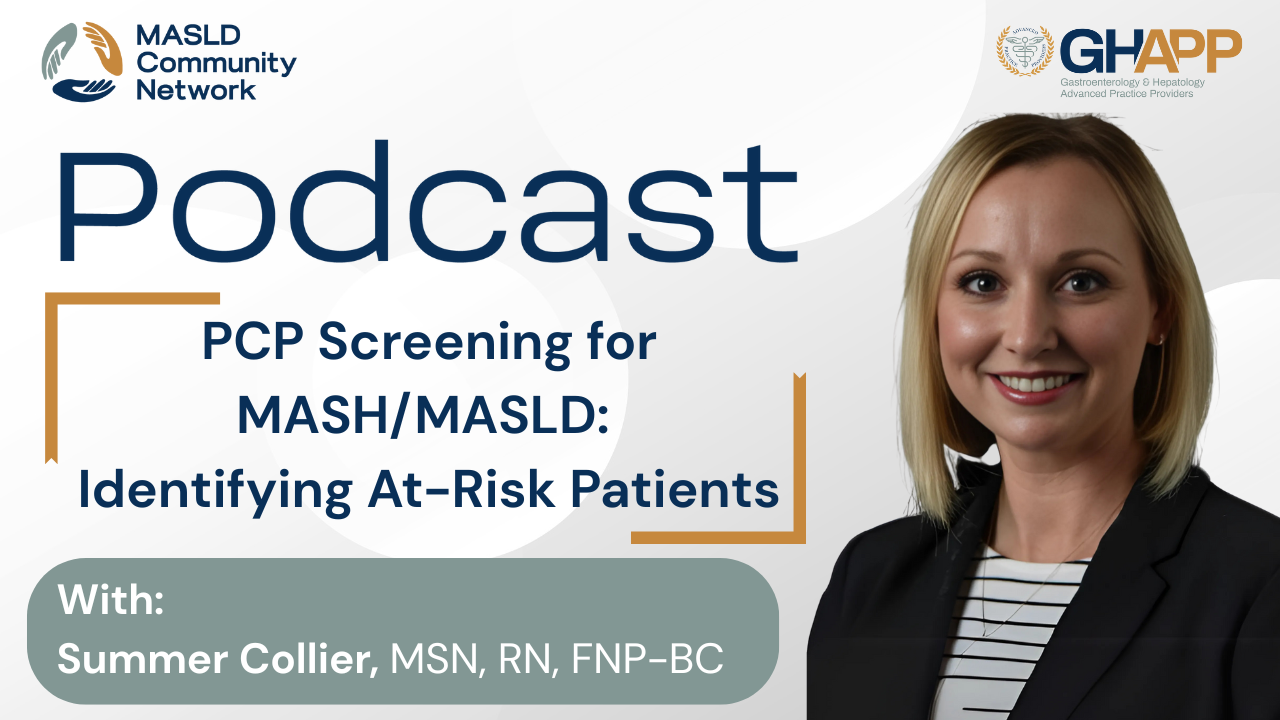
Podcast: PCP Screening for MASH/MASLD: Identifying At-Risk Patients

In this essential podcast episode from the GHAPP MASLD/MASH Community Network, Summer Collier, NP at UC San Diego Health, dives into the critical role that primary care providers and advanced practice providers play in recognizing and managing MASLD (Metabolic dysfunction-associated steatotic liver disease) and its progressive form, MASH (Metabolic-associated steatohepatitis). With MASLD affecting a growing number of patients—many undiagnosed—Summer walks through practical strategies for early identification, starting with high-risk individuals such as those with type 2 diabetes, obesity, or metabolic syndrome. She highlights the use of the FIB-4 index as a quick, validated, and guideline-recommended first-line screening tool, and explains how to interpret FIB-4 results to stratify risk and determine next steps, including ELF testing, FibroScan®, or referral to GI/hepatology. Summer also offers actionable workflow tips to integrate liver screening into routine primary care, like embedding FIB-4 calculators in EMRs or incorporating assessments into annual diabetes visits. This episode is a must-listen for clinicians seeking to prevent liver fibrosis progression and liver cancer through early, proactive care.
Watch Now

NITs: A Practical Overview: Navigating the Basics

In this practical and engaging overview, Janet Gripshover, nurse practitioner and nurse manager for the Cedars-Sinai Liver Transplant Program, breaks down the essentials of non-invasive testing (NITs) for assessing fibrosis in patients with metabolic-associated steatotic liver disease (MASLD). She explains the critical distinction between MASLD and MASH (metabolic-associated steatohepatitis), highlighting why early identification of aggressive liver disease is essential—even in patients without cirrhosis. Janet reviews key NIT tools, including FibroScan, MR elastography, and serum biomarkers like FIB-4 and ELF score, providing clinical insights on interpreting results, integrating them into risk stratification, and tailoring next steps for patient care. Viewers will learn when to act on elevated liver stiffness, how to interpret CAP scores, and why weight loss and comorbidity control remain foundational treatments. Whether you're new to hepatology or seeking a refresher on navigating fibrosis assessments, this video offers a clear, actionable framework to help prevent disease progression and optimize outcomes for patients with fatty liver disease.
Watch Now

GHAPPcast: Recognizing the Severity of MASH

Thank you to Madrigal for sponsoring this episode of GHAPPcast. In this episode of GHAPPcast, nurse practitioners Patrick Horne and April Morris from discuss the complexities of identifying and managing patients with metabolic-associated steatohepatitis (MASH). They explore clinical approaches, including the use of bloodwork, family history, and advanced diagnostic tools such as FibroScan, to recognize patients at risk. Patrick and April emphasize the importance of lifestyle interventions like diet and exercise alongside new medical therapies, while also offering practical tips for clinicians on patient monitoring and treatment management. Tune in for valuable insights into managing MASH in clinical practice.
Watch Now

Alcohol and MASLD/MASH: Navigating the Complex Relationship

In this insightful episode, Oyin Penny, NP with Premier Gastroenterology of Kansas City, addresses the complex clinical challenge of managing patients with MASLD (metabolic dysfunction-associated steatotic liver disease) who also consume alcohol. Oyin shares practical, evidence-based strategies for screening alcohol use in MASLD and MASH, emphasizing the importance of creating a nonjudgmental, patient-centered environment. She outlines how to use tools like PEth (phosphatidylethanol) testing to objectively quantify alcohol intake and explains the synergistic hepatotoxicity that occurs when alcohol use coexists with metabolic liver disease. Oyin also explores when to initiate non-invasive tests (NITs), why alcohol can distort fibrosis staging, and how to time assessments and treatment appropriately. From setting SMART goals to recommending behavioral support, medications like naltrexone, and exploring mental health and social work interventions, this episode offers a full-spectrum approach to managing high-risk patients. Whether you're a GI, hepatology provider, or in primary care, this episode provides tools for personalized care, alcohol harm reduction, and effective long-term MASLD management.
Watch Now

PCP Screening for MASH/MASLD: Identifying At-Risk Patients

In this episode, Jeremy Davis, NP from Gastrointestinal Specialists in Shreveport, Louisiana, discusses the vital role of primary care screening for MASLD (metabolic dysfunction-associated steatotic liver disease) and MASH (metabolic-associated steatohepatitis). With the rising prevalence of metabolic co-morbidities like type 2 diabetes, hypertension, dyslipidemia, and obesity, early identification of at-risk patients is more critical than ever. Jeremy outlines practical and evidence-based strategies for screening in the primary care setting, starting with simple tools like the FIB-4 score—which relies on common lab values—and how to interpret results to guide referrals to hepatology or GI specialists. He also discusses the downstream workup upon referral, including non-invasive tests like FibroScan, ELF score, and liver ultrasound. Treatment fundamentals such as the Mediterranean diet, physical activity, and weight loss remain the cornerstone of care, while emerging therapies like GLP-1 agonists and resmetirom offer new options for high-risk patients. Whether you’re a PCP, APP, or specialist, this episode offers clear guidance on how to incorporate MASLD screening into everyday workflows to catch liver disease early and optimize outcomes.
Watch Now

Practical Techniques for Lifestyle Adherence

In this episode, Emily Przybyl, PA-C at Erie County Medical Center in Buffalo, NY, dives into the foundations of motivational interviewing for patients with MASLD (metabolic dysfunction-associated steatotic liver disease) and MASH. With practical, real-world insights from her clinical experience, Emily shares how providers can build trust, meet patients where they are, and guide them toward meaningful, sustainable lifestyle changes. She emphasizes asking open-ended questions, assessing social determinants of health like income and food access, and collaboratively developing realistic diet and exercise plans tailored to each patient’s circumstances. Emily also highlights culturally sensitive counseling techniques, strategies for overcoming barriers like limited mobility or unsafe environments, and the importance of setting SMART goals for weight loss and liver health. Whether patients are struggling with motivation, resistant to change, or unsure where to start, this episode provides a supportive, patient-centered framework for fostering long-term behavior change in metabolic liver disease.
Watch Now

Monitoring for MASLD in Type 2 Diabetes

In this episode, Kelly Smeester, PA-C from South Denver Gastroenterology, explores the critical intersection of type 2 diabetes and metabolic dysfunction-associated steatotic liver disease (MASLD). Drawing from her background in both hepatology and endocrinology, Kelly offers practical, evidence-based strategies for non-invasive monitoring of liver fibrosis in patients with diabetes who may initially appear low risk. She highlights the utility of tools like FIB-4, ELF score, FibroScan, and MR elastography, while emphasizing the limitations of relying solely on liver function tests (LFTs). Kelly recommends annual FIB-4 screening—easily calculated with existing lab values—and discusses when to escalate to more advanced diagnostics. She also shares how advanced practice providers (APPs) can seamlessly integrate MASH education, lifestyle counseling, and routine screening into the diabetes care workflow, supporting early intervention and long-term liver health. This episode is a must-listen for clinicians looking to optimize care for patients at risk of silent liver disease progression in the setting of metabolic co-morbidities.
Watch Now

Diet and Nutrition: Tailoring Plans for Diverse Populations

In this quick and practical video, Miu Lai Ng, a nurse practitioner at the hepatology clinic at Tufts Medical Center in Boston, shares simple, culturally sensitive, and cost-effective dietary tips to help patients manage fatty liver disease—also known as MASH (metabolic dysfunction–associated steatohepatitis). From avoiding white-colored refined carbs like sugar, white rice, and potatoes to smart swaps like oatmeal—rich in soluble fiber and low on the glycemic index—this video emphasizes realistic changes tailored to diverse backgrounds. Miu Lai Ng also covers powerful tools for sticking with a liver-friendly diet, including food tracking apps, photo logging, meal planning tools, and the importance of social support. Plus, she highlights the hidden dangers of liquid calories found in sodas, juices, and bubble tea, which spike liver fat and cost more than you think. Whether you're supporting a patient or managing MASH yourself, this video offers actionable advice that respects both culture and budget—because small changes can lead to big results for your liver and your life.
Watch Now

Podcast: LFTs Demystified: A Practical Guide for APPs

In this podcast episode, Michelle Barnett, PA-C, a liver disease specialist based in Colorado Springs, provides a clear and practical overview on demystifying liver enzyme abnormalities—particularly in the context of MASH (Metabolic Dysfunction–Associated Steatohepatitis) and MASLD (Metabolic Dysfunction–Associated Steatotic Liver Disease). With MASLD affecting nearly 1 in 4 American adults, understanding liver enzyme patterns is critical for early detection and effective management. Michelle breaks down commonly reported values from hepatic function panels—ALT, ALP (alkaline phosphatase), and total bilirubin—explaining what constitutes normal, acute, subacute, and chronic elevations. She walks through hepatocellular, cholestatic, mixed, and isolated hyperbilirubinemia patterns and what they reveal about underlying liver conditions such as MASH, alcohol-associated liver disease, viral hepatitis, biliary obstruction, and drug-induced liver injury. Whether you're a provider or a patient looking to better understand lab results, this episode delivers expert guidance on interpreting liver enzyme elevations to support more informed clinical decisions.
Watch Now

The Role of Exercise in Liver Health

In this episode, Suzanne Robertazzi, DNP at the Washington DC VA Medical Center, discusses the vital role of exercise in liver health, especially for patients at risk of or living with MASLD (metabolic dysfunction-associated steatotic liver disease) and MASH. With a background in liver transplant care, Suzanne emphasizes the importance of tailoring exercise recommendations to each patient’s abilities, goals, and environment. She outlines practical, empathetic strategies for setting realistic fitness goals, celebrating small milestones, and integrating physical activity with nutritional counseling and behavioral support. Whether it's walking, swimming, or group classes, Suzanne explores low-cost and community-based options for promoting long-term adherence. This episode also highlights the benefits of a multidisciplinary approach, including collaboration with physical therapists, mental health professionals, and dietitians. Packed with actionable insights, this conversation is essential for healthcare providers working to empower patients with fatty liver disease through sustainable lifestyle interventions.
Watch Now

Monitoring for MASLD in Type 2 Diabetes

In this episode of the GHAPP MASLD podcast series, Lavinia Iordache, PA-C from the University of Miami, shares expert guidance on monitoring metabolic dysfunction-associated steatotic liver disease (MASLD) in patients with type 2 diabetes—a group at particularly high risk for disease progression. Lavinia explains the bidirectional relationship between MASLD and diabetes, highlighting the importance of early screening, timely non-invasive testing (NITs), and proactive management strategies to prevent advanced fibrosis and cirrhosis. She reviews essential tools such as FIB-4, ELF score, FibroScan, and MRI-PDFF, and offers clear recommendations on when to escalate care, refer to specialty clinics, or intensify follow-up. The discussion also covers the role of lifestyle interventions including the Mediterranean diet, intermittent fasting, exercise, and coffee consumption, as well as strategies to improve adherence despite psychosocial, cultural, or financial barriers. Lavinia emphasizes a multidisciplinary approach to managing MASLD and provides practical tips for tracking lifestyle changes, such as journaling and the use of the EDAS questionnaire. Whether you’re a GI, endocrinology, or primary care provider, this episode offers an actionable roadmap for reducing liver-related complications in patients with diabetes.
Watch Now

Podcast: Role of Exercise in Liver Health

In this engaging episode of the GHAPP MASLD/MASH Community Network podcast, Jonathan Yeh, PA at Columbia University Medical Center, discusses the essential role of exercise in liver health—especially in managing MASLD (Metabolic Dysfunction–Associated Steatotic Liver Disease) and MASH (Metabolic Dysfunction–Associated Steatohepatitis). With over 14 years of hepatology experience, Jonathan breaks down the most effective types of physical activity, highlighting the benefits of combining aerobic and resistance training over high-intensity interval training (HIIT) alone. He provides practical, personalized exercise recommendations tailored to patients’ physical abilities, access to resources, and comorbidities—including suggestions for those with mobility limitations or time constraints. Jonathan also offers motivational strategies to help patients overcome common barriers such as lack of time, motivation, or access to fitness facilities. From parking farther from a destination to lunchtime walks and home-based workouts using resistance bands, he emphasizes creative and realistic ways to build physical activity into daily routines. Beyond weight loss, he explains how exercise directly improves liver function by reducing liver fat, enhancing insulin sensitivity, and preventing fat and sugar buildup in the liver. This episode is a must-watch for clinicians and patients alike seeking to understand and implement exercise as a cornerstone in the management of fatty liver disease.
Watch Now

Addressing Health Disparities: Equity Considerations in MASH/MASLD Care

In this powerful and timely episode, Robin Soto, FNP at UC San Diego Health, explores the deep-rooted health disparities impacting patients with MASH (metabolic dysfunction-associated steatohepatitis) and MASLD (metabolic dysfunction-associated steatotic liver disease). With a focus on equity in liver care, Robin highlights the disproportionate burden of disease in Hispanic and underserved populations and the complex interplay of genetics, socioeconomic status, healthcare access, and systemic bias that drives these outcomes. She shares actionable strategies for advanced practice providers (APPs) to implement culturally sensitive communication, bias-conscious screening protocols using tools like FIB-4, NAFLD fibrosis score, and transient elastography, and how to leverage telehealth and community partnerships to bridge gaps in care. Robin also addresses the importance of culturally relevant dietary counseling, inclusive family engagement, and motivational interviewing to enhance adherence and improve long-term outcomes. Whether you're in primary care, hepatology, or community health, this episode offers a roadmap to advance health equity in the management of fatty liver disease.
Watch Now

NITs: A Practical Overview: Navigating the Basics

Join Ellie Gonyeau, a nurse practitioner at Beth Israel in Boston, for an insightful podcast episode on metabolic dysfunction-associated steatotic liver disease (MASLD) and MASH, and how to effectively use non-invasive testing (NITs) to evaluate and manage patients with fatty liver disease. Ellie breaks down the differences between MASLD and MASH—explaining why distinguishing simple steatosis from inflammatory liver injury matters for long-term outcomes. She covers first-line serum-based tools like FIB-4 and ELF score, as well as imaging-based modalities including FibroScan and MR elastography, helping clinicians understand when and how to apply each test. With practical tips on interpreting fibrosis risk thresholds, stratifying patients with metabolic comorbidities, and educating primary care teams, this episode emphasizes the power of early identification, appropriate triage, and collaborative care to prevent disease progression. Whether you're working in general GI, primary care, or hepatology, this episode equips you with tools to make liver disease detection more proactive and patient-centered.
Watch Now

NITs: A Practical Overview: Navigating the Basics

In this episode, Christie Morrison breaks down the fundamentals of non-invasive testing (NITs) for evaluating patients with fatty liver disease, including MASLD and MASH. She explains the key differences between steatosis (MASLD) and steatohepatitis (MASH), highlighting how non-invasive tests can replace liver biopsy for staging fibrosis. Christy reviews common tools like FIB-4, NAFLD fibrosis score, Enhanced Liver Fibrosis (ELF) score, transient elastography (FibroScan), and MR elastography, and outlines how to choose the right test based on patient factors such as co-morbidities, geography, access to labs, and imaging availability. The episode also emphasizes the importance of fibrosis risk stratification, interpreting FIB-4 cutoffs, and monitoring liver stiffness or ELF scores after initiating lifestyle or pharmacologic treatment—including newer therapies like resmetirom. This is a must-watch for APPs, GI clinicians, and primary care providers seeking to improve care pathways and outcomes in patients with metabolic liver disease through practical, accessible strategies for fibrosis detection and management.
Watch Now

Podcast: Alcohol and MASLD/MASH: Navigating the Complex Relationship

In this powerful and highly educational episode, Scott Springer, PA-C at Erie County Medical Center in Buffalo, NY, explores the complex and often overlooked relationship between alcohol use and metabolic dysfunction–associated steatotic liver disease (MASLD/MASH). Drawing from his dual expertise in hepatology and addiction medicine, Scott outlines the importance of accurately assessing alcohol use when diagnosing MASLD, MASH, MetALD, or ALD—emphasizing that MASLD and MASH are diagnoses of exclusion and heavily influenced by alcohol consumption thresholds. He discusses best practices for screening, including patient-centered, nonjudgmental interviewing, the use of biomarkers like PEth and urine ethyl glucuronide, and how these tools enhance accuracy and accountability in care. Scott reviews national guidelines that recommend alcohol abstinence for patients with chronic liver disease and presents data showing how even small reductions in alcohol use can significantly lower the risk of cirrhosis. He also unpacks the challenges of interpreting liver tests in patients with ongoing alcohol use, the limitations of non-invasive testing like FibroScan and FIB-4, and how alcohol may disqualify patients from emerging pharmacotherapy such as resmetirom. Finally, he highlights the promising potential of GLP-1 medications in managing both liver fibrosis and alcohol use. This episode is essential listening for hepatology providers, addiction specialists, and any clinician involved in the care of patients with coexisting liver disease and substance use disorders.
Watch Now

Beyond Basic NITs: When is Liver Biopsy or Advanced Imaging

In this episode, Brian Lam, PA, Associate Director of Research at Inova’s Liver and Obesity Research Program in Northern Virginia, explores the nuanced decision-making involved in going beyond basic non-invasive tests (NITs) for diagnosing and managing MASH (metabolic dysfunction-associated steatohepatitis). While FIB-4 and transient elastography are useful initial tools, Brian breaks down when and why clinicians should consider more advanced diagnostics—such as MR elastography (MRE), proton density fat fraction (PDFF), and in certain cases, liver biopsy. Learn how to assess the reliability of a TE exam, interpret discordant NITs, and when to escalate to cross-sectional imaging or histologic confirmation. This podcast also highlights the evolving role of fat fraction in therapy response, limitations in current FDA indications for resmetirom, and how emerging data may shape future clinical pathways for patients with compensated cirrhosis. Whether you're in primary care, GI, or hepatology, this discussion offers critical insights to improve accuracy in staging liver disease and optimizing treatment strategies for patients with MASH.
Watch Now

LFTs Demystified: A practical guide for APPs

In this GHAPP MASLD Community Network podcast, Jessica Crimaldi, NP, from the Cleveland Clinic, provides practical, real-world insights into interpreting liver function tests (LFTs) in the context of MASLD (metabolic dysfunction-associated steatotic liver disease) and MASH (steatohepatitis). Drawing on over a decade of experience in GI and hepatology, Jessica explains common ALT and AST elevation patterns that should prompt a diagnostic workup, even in asymptomatic patients. She reviews the hepatocellular vs. cholestatic patterns of injury, the value of the R-factor calculator in identifying the likely etiology of liver enzyme abnormalities, and how to differentiate MASH from other liver diseases such as PBC, viral hepatitis, or bile duct obstruction. The episode also addresses key non-liver labs like triglycerides, A1C, and cholesterol, and how they contribute to assessing metabolic risk. Finally, Jessica discusses the role of serial LFT monitoring in evaluating treatment response—highlighting what it means when liver enzyme levels fall and why "normal" LFTs don’t always indicate disease resolution. Whether you're a primary care provider or hepatology specialist, this podcast offers valuable guidance for early detection, risk stratification, and longitudinal monitoring of patients with MASH.
Watch Now

Podcast: Viral Hepatitis and MASH/MASLD: Understanding the Connection

In this episode, Patrick Horne, NP from the University of Florida, explores the important connection between viral hepatitis and MASLD/MASH (Metabolic Dysfunction–Associated Steatotic Liver Disease/Steatohepatitis). While patients may present with a presumed diagnosis of MASLD or MASH, Patrick emphasizes the critical need to rule out coexisting liver diseases such as hepatitis B and C. The presence of both metabolic and viral liver diseases can significantly accelerate liver inflammation, fibrosis progression, and ultimately cirrhosis—a concept he explains using the “two-hit” or even “three-hit” theory. Patrick walks through the recommended screening protocols, including one-time HCV testing for all adults over 18 and complete HBV panels to assess for immunity, past exposure, and chronic infection. He stresses that treating viral hepatitis—especially with today's highly effective antivirals—can and should occur alongside lifestyle modification strategies for MASLD/MASH. He also discusses how liver stiffness measurements can be skewed by active inflammation and suggests reassessing fibrosis after treating viral hepatitis. This episode is a must-watch for providers managing patients with liver disease, highlighting the need for a comprehensive, layered diagnostic approach.
Watch Now

HCC Surveillance: Implementation in Patients with Advanced Fibrosis/Cirrhosis from MASH

In this expert-led session, Elizabeth Alqueza, PA-C, from Beth Israel Deaconess Medical Center in Boston, discusses the critical importance of hepatocellular carcinoma (HCC) surveillance in patients with steatotic liver disease, including MASLD and MASH. HCC is a leading cause of cancer-related death worldwide, and early detection is vital for improving survival outcomes. Using a real-world case study, Elizabeth highlights risk factors such as obesity, type 2 diabetes, and advanced fibrosis—and underscores the growing role of MASH in HCC development, even in the absence of cirrhosis. She outlines best practices for staging, the importance of early referral to hepatology, and AASLD-recommended surveillance protocols using ultrasound and AFP testing every 6 months. The video also explores systemic barriers to screening and actionable strategies to improve adherence, such as EMR alerts, streamlined imaging protocols, and improved coordination between primary care and hepatology. This presentation is essential viewing for healthcare professionals managing patients with liver disease, offering practical tools to enhance HCC detection and optimize long-term outcomes.
Watch Now

Alcohol and MASLD/MASH: Navigating the Complex Relationship

In this insightful video, Jordan Mayberry, a seasoned physician assistant at UT Southwestern in Dallas, explores the complex intersection of alcohol use and metabolic-associated steatotic liver disease (MASLD), including its progressive form, MASH. With over 12 years of hepatology experience, Jordan breaks down why accurate assessment of alcohol intake is essential—not just for diagnosis but for guiding patient management. Learn how to use motivational interviewing techniques to respectfully screen for alcohol use, quantify intake effectively, and differentiate between MASLD, MASH, and the emerging diagnosis of MetALD (metabolic dysfunction-associated alcoholic liver disease). Jordan also shares practical tips on managing patients with MASH who drink above recommended thresholds, including behavioral interventions, medications like acamprosate, and referral pathways such as SMART Recovery or addiction psychiatry. The video also highlights how ongoing alcohol use can skew liver function tests (LFTs), distort non-invasive testing (NIT) results like FibroScan or MRE, and potentially affect eligibility for future MASH pharmacotherapies. This session is a must-watch for clinicians aiming to provide holistic, evidence-based care to patients navigating the dual challenges of liver disease and alcohol use.
Watch Now

HCC Surveillance: Implementation in Patients with Advanced Fibrosis/Cirrhosis from MASH

In this episode of the GHAPP MASLD Community Network podcast, Lisa Richards, a hepatology-focused nurse practitioner in San Diego, shares expert insights on hepatocellular carcinoma (HCC) surveillance for patients with advanced fibrosis and cirrhosis due to MASH (metabolic dysfunction-associated steatohepatitis). Lisa outlines which patients require routine HCC surveillance, emphasizing the importance of staging—particularly stages F3 and F4—and how AASLD guidelines guide surveillance strategies. She discusses recommended surveillance modalities, including ultrasound with AFP every six months, and introduces the LIRADS visualization score to help interpret imaging quality and follow-up needs. Lisa also addresses practical challenges in implementation, from patient education and engagement to overcoming barriers like cost, transportation, and care coordination. For advanced practice providers (APPs), this podcast delivers clear guidance on what to do when new liver lesions are detected and how to proceed with diagnostic imaging and referrals for multidisciplinary review or intervention. Empower your clinical practice with strategies that promote early detection and improve outcomes in patients at risk of HCC.
Watch Now

LFTs Demystified: A Practical Guide for APPs

In this informative session, Anthony Derencius, PA-C and sub-investigator at Pinnacle Clinical Research, provides a practical and accessible breakdown of liver function tests (LFTs) and liver-associated enzymes, with a focus on their role in diagnosing and monitoring fatty liver disease—including MASLD (metabolic dysfunction-associated steatotic liver disease) and MASH (metabolic-associated steatohepatitis). Drawing from years of experience in both general and transplant hepatology, Anthony explains how to interpret key markers like ALT, AST, alkaline phosphatase, bilirubin, albumin, and GGT. He emphasizes why elevated or even normal LFTs don’t always tell the whole story, and how a full workup—including viral hepatitis panels, autoimmune markers, alcohol-related labs, imaging, and non-invasive fibrosis assessments—can help uncover the root cause of liver injury. This video also walks viewers through when to consider additional tools like FIB-4, ELF score, FibroScan, or even liver biopsy. Whether you're a primary care provider or hepatology specialist, this session will sharpen your ability to distinguish between benign lab variations and signs of serious liver disease, ultimately supporting earlier diagnosis and better outcomes for your patients.
Watch Now

PCP Screening for MASH/MASLD: Identifying At-Risk Patients

In this essential FAQ video, Jennifer Geremia, PA-C, a seasoned gastroenterology provider practicing in Boston, outlines current primary care screening guidelines for identifying patients at risk for metabolic dysfunction-associated steatohepatitis (MASH) and MASLD. With nearly two decades of experience caring for GI and liver patients, Jennifer emphasizes the importance of integrating liver health into routine health maintenance—particularly for individuals with type 2 diabetes, obesity, metabolic syndrome, and related conditions. She reviews practical steps for risk stratification, beginning with FIB-4 scoring using readily available labs, and discusses how to interpret and act on the results, including when to refer for further testing like elastography or ELF testing. Viewers will also gain insight into patient counseling strategies, alcohol intake guidance, and the urgency of acting early—even in asymptomatic patients. This video is a must-watch for primary care clinicians aiming to improve detection and management of MASH and MASLD through evidence-based screening and timely intervention.
Watch Now

Podcast: Pharmacotherapy for MASH/MASLD: An Overview

In this informative episode, Lindsay Yoder, PA, a hepatology expert at Indiana University, provides a comprehensive overview of current pharmacotherapy options for MASH (Metabolic Dysfunction–Associated Steatohepatitis), focusing on the first FDA-approved medication, resmetirom (brand name: Rezdiffra). Speaking directly to the MASLD/MASH Community Network, Lindsay breaks down the key histologic endpoints that led to resmetirom’s conditional approval—namely, fibrosis improvement without worsening of steatohepatitis, and MASH resolution without worsening fibrosis. She shares real-world data from clinical trials showing that resmetirom nearly doubles the rate of fibrosis improvement and triples MASH resolution compared to placebo. Lindsay also explains how the drug works: as a thyroid hormone receptor beta agonist, resmetirom improves hepatic lipid metabolism, reduces liver fat, and dampens inflammation—all key drivers of MASH progression. She outlines ideal patient criteria (stage F2–F3 fibrosis without cirrhosis), safety considerations, tolerability, potential side effects, and statin interactions. With an emphasis on combining pharmacotherapy with lifestyle changes, this episode serves as a practical guide for clinicians treating patients with MASH who qualify for advanced intervention.
Watch Now

Discordant NITs, the Gray Zone

Join Lindsay Pratt, PA-C, from the University of Colorado School of Medicine’s Hepatology and Liver Transplant Department, as she unpacks the challenges of interpreting discordant results between non-invasive liver testing tools such as FIB-4 and FibroScan in patients with MASLD and MASH. With over 15 years of clinical experience, Lindsay walks viewers through how age, transaminase levels, platelet count, and patient factors like BMI and fasting status can impact test accuracy and reliability. She emphasizes when to consider advanced diagnostics like MRI elastography (MRE) or liver biopsy, and how to tailor decisions to the individual patient, especially when results don't align. This practical session is ideal for hepatology and GI providers navigating complex liver disease management, and includes tips for communicating test limitations and next steps with patients. Learn how to make informed decisions using non-invasive tests while maintaining patient-centered care in the management of fatty liver disease.
Watch Now

Differentiating Between F3 and F4

In this comprehensive discussion, HoChong Gilles, a nurse practitioner with 25 years of hepatology experience at the Richmond VA Medical Center, explores the critical importance of accurately distinguishing between F3 (advanced fibrosis) and F4 (cirrhosis) in patients with MASH (metabolic-associated steatohepatitis). While both stages carry increased risks of liver-specific and overall mortality, Gilles explains that F3 may still be reversible with lifestyle changes or pharmacotherapy, whereas F4 signals irreversible liver damage with heightened risk of complications like portal hypertension, hepatic encephalopathy, and liver cancer. Viewers will gain a deeper understanding of how non-invasive tests—like FIB-4, ELF, FibroScan, and MRE—perform in identifying fibrosis stage, including their limitations and overlaps. Gilles also outlines when to consider liver biopsy, especially in cases with discordant test results, atypical features, or clinical uncertainty. This video emphasizes how staging accuracy informs eligibility for therapies, surveillance strategies like HCC screening, and overall prognosis. Learn how to approach this nuanced distinction in clinical practice and why F3 vs. F4 isn't just semantics—it's a turning point in patient care.
Watch Now

HCC Surveillance: Implementation in Patients With Advanced Fibrosis/Cirrhosis From MASH

Learn when and how to effectively screen for hepatocellular carcinoma (HCC) in patients at risk, especially those with metabolic dysfunction-associated steatotic liver disease (MASLD). In this informative video, Maribeth Capuno, an adult nurse practitioner at the Richmond Veterans Affairs Medical Center, shares her clinical approach to early HCC surveillance. While AASLD guidelines recommend screening only after cirrhosis has been diagnosed, Maribeth highlights the growing evidence that patients with stage 3 fibrosis can still develop liver cancer—and why she begins surveillance earlier. She discusses the recommended tools, including liver ultrasound every six months and alpha-fetoprotein testing, and explores practical workflow tips to ensure patients remain adherent. Learn how imaging modalities like MRI and CT with liver protocol, along with tools like LI-RADS and tumor board consultations, contribute to timely and accurate diagnosis. The video also emphasizes key risk factors—such as obesity, diabetes, viral hepatitis, and lifestyle behaviors—and how managing these can help prevent the progression to HCC.
Watch Now

Addressing Health Disparities: Equity Considerations in MASH/MASLD Care

In this episode, Patrick Horne, NP at the University of Florida (UF Health), explores the impact of health disparities and socioeconomic inequality on the diagnosis and management of MASH (metabolic-associated steatohepatitis) and MASLD (metabolic dysfunction-associated steatotic liver disease). With a focus on rural and underserved populations, Patrick discusses how limited access to quality healthcare, healthy food, exercise options, and non-invasive testing (NITs) like FibroScan or MRI elastography can delay diagnosis and worsen outcomes. He shares practical, empathetic strategies for individualizing care, such as using accessible tools like FIB-4 or APRI, promoting low-cost physical activity like walking or swimming, and providing culturally sensitive nutrition advice tailored to financial and geographic realities. Patrick emphasizes the provider’s role as a patient advocate and coach, helping patients navigate barriers and create sustainable lifestyle modifications. This episode offers key insights for clinicians working to close gaps in care and promote equity in liver disease management.
Watch Now

Pharmacotherapy Review

Join Christina Hanson, FNP-C, from South Denver Gastroenterology, as she provides an in-depth overview of the current pharmacologic treatment landscape for Metabolic Dysfunction-Associated Steatotic Liver Disease (MASLD) and Metabolic Dysfunction-Associated Steatohepatitis (MASH). This expert-led session explores the three cornerstones of MASH management—lifestyle and weight loss interventions, cardiovascular risk reduction, and liver-directed therapy—while highlighting the evolving role of GLP-1 receptor agonists and the recent FDA approval of resmetirom, the first medication indicated for adults with MASH and moderate to advanced fibrosis. Christina also discusses clinical trial data from MAESTRO-NASH, reviews historical agents like vitamin E and pioglitazone, and offers practical guidance on patient selection, safety considerations, and monitoring strategies. Whether you’re a GI provider, hepatology specialist, or primary care clinician managing fatty liver disease, this video provides valuable insights into how emerging therapies are shaping the future of MASH treatment.
Watch Now

Podcast: Pharmacotherapy for MASH/MASLD: An Overview

In this comprehensive episode, Christina Hanson, FNP-C at South Denver GI, provides an in-depth overview of pharmacotherapy for MASLD and MASH, with a focus on the FDA-approved therapy resmetirom (brand name Rezdiffra). Drawing on over 18 years of experience in hepatology and GI care, Christina explains the histologic endpoints used in clinical trials—MASH resolution and fibrosis improvement without worsening disease—and how they guided the approval of resmetirom. She breaks down the drug’s mechanism of action as a selective thyroid hormone receptor beta (THR-β) agonist, which promotes lipid metabolism and reduces liver inflammation without systemic toxicity. Christina reviews key Phase 3 data from the MAESTRO-NASH trial, showing resmetirom’s significant impact on both MASH resolution and fibrosis regression across diverse patient populations. She also outlines criteria for appropriate patient selection (those with stage F2-F3 fibrosis), clinical monitoring strategies, and management of side effects like transient GI discomfort. Christina emphasizes the importance of baseline screening for liver disease, autoimmune conditions, thyroid function, and lipid levels before initiating therapy. She highlights best practices from the 2024 AASLD guidelines for ongoing monitoring and treatment response assessment, including ALT and liver stiffness thresholds that help determine whether to continue or discontinue therapy. This episode is a must-watch for hepatology clinicians looking to implement evidence-based, patient-centered strategies in the management of MASH.
Watch Now

Liver Model Overview

Join Alison Moe, PA-C with United Digestive, as she walks through a hands-on demonstration using a life-sized liver model to help patients better understand fibrosis and liver disease progression. In this engaging and practical overview, Allison explains how different stages of liver fibrosis—from normal liver to cirrhosis and hepatocellular carcinoma—can be felt and visualized using a segmented anatomical model. She shares how this tool enhances patient education during discussions about non-invasive liver testing, such as FibroScan, CAP scores, FIB-4, ELF testing, and more. Designed to support visual learners and improve comprehension of disease state, this video is a valuable resource for clinicians and patients navigating the complexities of metabolic-associated fatty liver disease (MASLD) and its progression to MASH. Learn how tactile and visual teaching aids can bridge the gap between diagnostics and patient understanding in hepatology care.
Watch Now
Latest News & Blogs
Developing risk stratification strategies and biomarkers for recurrent hepatocellular carcinoma

Hepatocellular carcinoma (HCC) remains a leading cause of cancer-related mortality, with high rates of post-resection recurrence posing significant clinical challenges. Early recurrence is largely driven by aggressive tumor biology, while late recurrence reflects de novo carcinogenesis in a cirrhotic liver. Traditional clinical and pathological predictors are insufficient for accurately identifying high-risk patients. Emerging translational advances including genomic, transcriptomic, proteomic,...
Read More
MASLD: insights on the role of folate in hepatic lipid metabolism

Metabolic dysfunction-associated steatotic liver disease (MASLD) is also known as fatty liver disease associated with non-alcoholic fatty liver disease (NAFLD), which is a spectrum of chronic liver diseases characterized by steatosis, inflammation, fibrosis and liver injury. The incidence and prevalence of MASLD is increasing rapidly worldwide. It is a multifactorial disease and there is no single drug approved for its treatment. The liver is the main organ that stores and metabolizes the B9...
Read More
ACLY inhibition promotes tumour immunity and suppresses liver cancer

Immunosuppressive tumour microenvironments are common in cancers such as metabolic dysfunction-associated steatohepatitis (MASH)-driven hepatocellular carcinoma (HCC) (MASH-HCC)^(1-3). Although immune cell metabolism influences effector function, the effect of tumour metabolism on immunogenicity is less understood⁴. ATP citrate lyase (ACLY) links substrate availability and mitochondrial metabolism with lipid biosynthesis and gene regulation^(5-7). Although ACLY inhibition shows antiproliferative...
Read More
Glucagon-Like Peptide-1 Receptor Agonists Improve MASH and Liver Fibrosis: A Meta-Analysis of Randomised Controlled Trials

CONCLUSIONS: GLP-1RAs are a promising treatment option for MASLD or MASH. Further research is needed to evaluate the long-term effects of GLP-1RAs on liver-related clinical events.
Read More
Plain language summary about GLP-1 treatments in people with metabolic dysfunction-associated steatotic liver disease

No abstract
Read More
Pathological Evolution and Internal Medicine Management of Nonalcoholic Fatty Liver Disease (NAFLD) in the Era of Metabolic Dysfunction-Associated Steatotic Liver Disease (MASLD)

Metabolic dysfunction-associated steatotic liver disease (MASLD), previously known as nonalcoholic fatty liver disease (NAFLD), is now recognized as the most prevalent chronic liver disease worldwide, driven by the rise in obesity, type 2 diabetes, and metabolic syndrome. The evolving nomenclature and understanding of MASLD necessitate updated insights into its pathophysiology, diagnostics, and internal medicine management. A comprehensive literature review was conducted using PubMed, Scopus,...
Read More
Evolving etiologies of liver transplantation: a trend analysis from 2020 to 2024 at the main center of Iran

CONCLUSION: The significant shifts in LT etiologies underscore the success of public health interventions in reducing the burden of viral-related ESLD. Additionally, the findings highlight the need for ongoing research into the prevention, early diagnosis, and management of autoimmune liver diseases, MASH, and liver cancer. These findings provide critical insights for clinicians and policymakers to enhance liver disease management and allocate resources effectively.
Read More
Thrombospondin-2 is a performant biomarker of at-risk MASH and advanced MASH fibrosis in a large multicentre European cohort

CONCLUSIONS: Serum TSP2, alone or with clinical/biological variables, potently discriminates AF and ARM in patients with MASLD.
Read More
Gut substrate trap of D-lactate from microbiota improves blood glucose and fatty liver disease in obese mice

L-lactate participates in metabolism, including the Cori cycle, but less is known about D-lactate. We found that circulating D-lactate was higher in humans and mice with obesity. D-lactate increased hepatic glycogen, triglycerides, and blood glucose more than equimolar L-lactate in mice. Stable isotope analyses showed that D-lactate is metabolized in mice and in hepatocytes to pyruvate, TCA intermediates, lipids, and glucose. The gut microbiota is the main source of blood D-lactate. Colonization...
Read More
Rapamycin ameliorates intrahepatic inflammation in MASLD by increasing macrophage fatty acid oxidation levels

Metabolic dysfunction-associated steatotic liver disease (MASLD) is a common liver disease and a serious threat to public health. Mammalian target of rapamycin (mTOR) plays an important role in the progression of MASLD and can be a potential therapeutic target. Our data show that rapamycin treatment can alleviate MASLD symptoms, including liver inflammation, steatosis and steatohepatitis, in the WD, CDHFD- or MCD-induced MASLD mouse model, but has no significant effect on hepatic fibrosis....
Read More
Serum LEAP2 Levels Across the Spectrum of Metabolic Dysfunction-Associated Fatty Liver Disease: A Potential Noninvasive Biomarker for Severity Stratification

CONCLUSION: Serum LEAP2 levels progressively increase with MAFLD severity and are independently associated with the disease. LEAP2 demonstrates potential as a noninvasive biomarker for assessing MAFLD severity, particularly in distinguishing MASH from healthy individuals. These findings warrant further investigation into LEAP2's pathophysiological role and therapeutic potential.
Read More
Rifaximin Attenuates Liver Fibrosis and Hepatocarcinogenesis in a Rat MASH Model by Suppressing the Gut-Liver Axis and Epiregulin-IL-8-Associated Angiogenesis

Metabolic dysfunction-associated steatohepatitis (MASH) is a progressive liver disease linked to fibrosis and hepatocellular carcinoma (HCC). Gut-derived lipopolysaccharide (LPS) promotes hepatic inflammation, fibrosis, and angiogenesis through toll-like receptor 4 (TLR4) signaling. This study examined the effects of rifaximin, a non-absorbable, gut-targeted antibiotic, on MASH-related liver fibrosis and early hepatocarcinogenesis, with a focus on the LPS-epiregulin-IL-8-angiogenesis axis.MASH...
Read More
Glucagon-like Peptide-1 Receptor Agonists (GLP-1 RAs): A Pan-Steatotic Liver Disease Treatment?

Glucagon-like peptide-1 receptor agonists (GLP-1RAs) are long-acting drugs that have gathered a lot of attention worldwide for their utility in the treatment landscape of type 2 diabetes mellitus and obesity. Their widespread global use has been accompanied by an additional observation related to a potential reduction in alcohol consumption. Preclinical studies in animal models, along with preliminary clinical findings, suggest that GLP-1 RAs may exert beneficial effects on alcohol use disorder...
Read More
Oral delivery of chitosan-bilirubin nanoparticles alleviates hepatic inflammation and fibrosis in metabolic dysfunction-associated steatohepatitis

Metabolic dysfunction-associated steatohepatitis (MASH) is a severe chronic liver disease that often leads to complications, such as cirrhosis and hepatocellular carcinoma. Despite intensive research and development efforts, there are relatively few approved therapeutics for MASH. Here, we report an oral nanomedicine comprising bilirubin-conjugated low molecular weight water-soluble chitosan (designated LMWC-BRNPs) that can alleviate oxidative stress and lipogenesis in liver to treat MASH in a...
Read More
Chiglitazar in MASLD with hypertriglyceridemia and insulin resistance: A phase II, randomized, double-blind, placebo-controlled study

CONCLUSION: Chiglitazar significantly reduced liver fat content in MASLD with hypertriglyceridemia and insulin resistance, with a dose-dependent effect and favorable safety profile.
Read More
E2F2 transcription factor promotes a cholestatic MASH phenotype by regulating hepatobiliary metabolism through miR-34a-5p

CONCLUSIONS: E2F2 deficiency protects against MASH and cholestasis preventing cholesterol accumulation, fibrosis, and inflammation through modulation of miR-34a-5p, which could provide therapeutic benefits for patients with cholestatic-MASH.
Read More
"Weekend Warrior" Exercise Pattern Protects Against MASLD and Mortality Comparable to Regular Exercise: National Cohort Study

CONCLUSIONS: WW physical activity patterns protect from MASLD and all-cause mortality comparable to regular exercise.
Read More
Cardiovascular implications of MASLD: overview of the evidence

CONCLUSION: MASLD seems to be an independent cardiovascular risk factor, but further studies are warranted to clarify the distinct impacts of MASLD stages and their interplay with MS on cardiovascular outcomes.
Read More
The Emerging Role of Anti-Hyperglycemic Agents for the Management of Metabolic Dysfunction-Associated Steatotic Liver Disease

The prevalence of type 2 diabetes mellitus (T2D) and metabolic dysfunction-associated steatotic liver disease (MASLD) is rapidly increasing worldwide. MASLD, previously known as non-alcoholic fatty liver disease (NAFLD), is defined as a condition of steatotic liver disease (SLD) with one or more cardiometabolic risk factor(s) and the absence of harmful alcohol intake. The variety of MASLD includes steatosis, metabolic dysfunction-associated steatohepatitis (MASH, formerly NASH), fibrosis,...
Read More
Bupleuri Radix polysaccharides enhance the efficacy and intestinal absorption of baicalin via regulating intestinal beta-glucuronidase activity in MASH mice

CONCLUSION: BRP improved BAI's intestinal absorption and therapeutic efficacy in MASH mice, potentially by modulating gut microbiota and enhancing β-GUS activity, thereby facilitating the deglycosylation of BAI. These findings reveal the potential synergistic mechanism of Bupleuri Radix-Scutellariae Radix pair and propose a feasible approach to improve the bioavailability and therapeutic effect of BAI.
Read More
Testimonial







